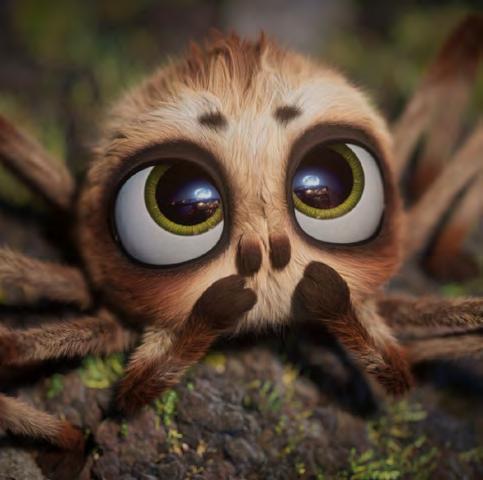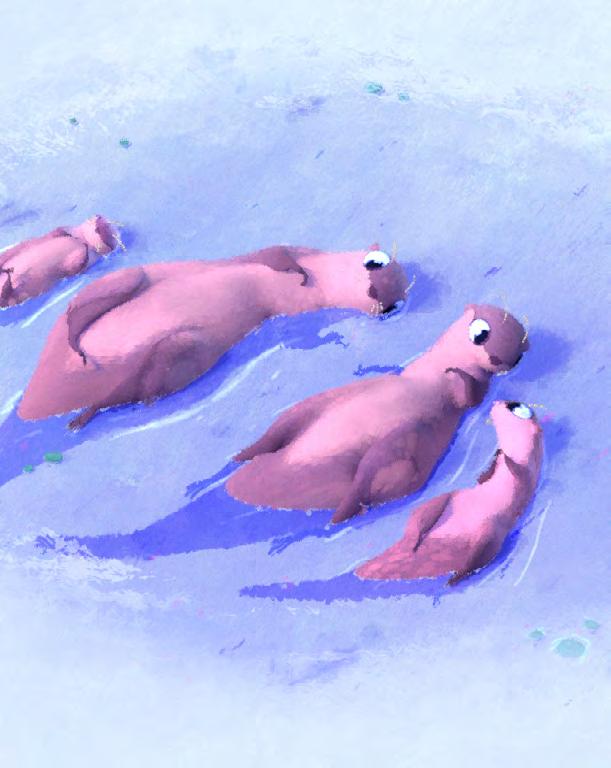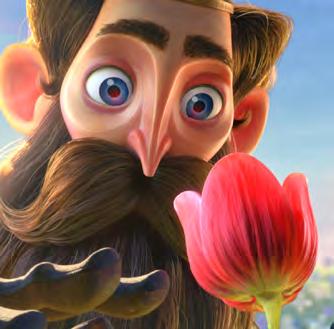














Which one did you miss?

The
behind DreamWorks’ eagerly anticipated Kung Fu Panda 4 gives us a sneak peek of their labor of love.




















The
behind DreamWorks’ eagerly anticipated Kung Fu Panda 4 gives us a sneak peek of their labor of love.



The official beginning of spring is still a few weeks away when this issue reaches your hands, but we get the feeling that that everyone is ready to put awards season behind them and dive right in to the fresh offerings of 2024.
Among them is one of the first big studio animated movies of the year, DreamWorks’ Kung Fu Panda 4, directed by animation veteran Mike Mitchell and Stephanie Stine. The plot revolved around everyone’s favorite panda (voiced by the consistently awesome Jack Black) training a new Dragon Warrior (Awkwafina) while a shape-shifting sorceress known as The Chameleon (voiced by the brilliant Viola Davis) brings back all of Po’s evil antagonists back from the spirit realm. Our writer Devin Nealy had a great time chatting with Mitchell, Stine and some of the key members of the creative team, and we hope you enjoy his cover story on the making of DreamWorks Animation’s 48th feature!
The studio is going to have a big year in 2024. Its charming Orion and the Dark has been doing very well on Netflix and delivered a 90% score on Rotten Tomatoes. There’s also a lot of good buzz surrounding Chris Sanders’ adaptation of Peter Brown’s much-loved book The Wild Robot, which Universal will release theatrically on Sept. 20. Also premiering this month is Megamind vs. the Doom Syndicate, the sequel to the 2010 movie Megamind, and the new series Megamind Rules!, which bow on Peacock on March 1. You can learn more about these two hot projects in Jeff Spry’s excellent feature story, which includes insights from director Eric Fogel and writer/showrunners Alan Schoolcraft and Brent Simons, who penned the original movie.
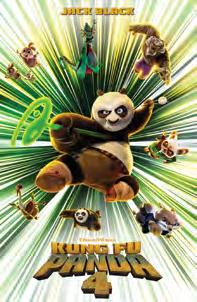
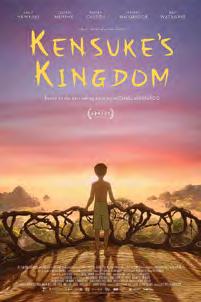
We’ve been following the making of the adaptation of Kensuke’s Kingdom by directors Neil Boyle and Kirk Kendry since it was announced a few years ago. Featuring the voices of Cillian Murphy, Sally Hawkins, Ken Watanabe and Aaron MacGregor, the powerful 2D-animated feature is the latest project from the award-winning team at Lupus Films (in assoc. with Kensuke’s Kingdom, Jigsaw Films, Melusine, Le Pact and Bumpybox). Like all the other previous Lupus Films projects (The Snowman and the Snowdog, Ethel & Ernest, We’re Going on a Bear Hunt and Mog’s Christmas, to name a few), this gentle picture is one to seek out in ‘24 as it remains faithful to the spirit of Michael Morpurgo’s beloved book while adding its own artistic flair and ecological vision to the story. The movie opened in France last month to rave reviews, and will be spotlighted at the Cartoon Movie co-production pitch event this month. You can read about some of our picks for the event in this issue, and make sure you visit our website for daily reports from Bordeaux (March 5-8).
This month’s issue also includes our Rising Stars of Animation feature and our annual School and Career Guide. We take deep proud in introducing you to some of the most creative and fresh voices in the world of animation this year, and spotlighting some of the most interesting and popular animation and VFX classes around the world. We also hope our collection of feature stories in this issue brightens your days and gives you artistic inspiration and hope for sunnier days ahead.


“Is it anticompetitive if one of the biggest movie studios in the world shuns the marketplace in order to use a tax loophole to write off an entire movie so they can more easily merge with one of the other biggest movie studios in the world? Cause it SEEMS anticompetitive!”
— Phil Lord on X (formerly Twitter) commenting on Warner Bros. possibly shelving Acme vs. Coyote to get a tax write-off.
President & Publisher: Jean Thoren
Accounting: Jan Bayouth
edit@animationmagazine.net
Editor in Chief: Ramin Zahed
Multimedia Editor: Mercedes Milligan
Webmaster: Damaso Abrajan
Asst. Webmaster: Lucy Abrajan
Tech Reviews Editor: Todd Sheridan Perry
Copy Editor: Jason Sanchez
Contributors: Kambole Campbell, Trevor Hogg, Karen Idelson, Devin Nealy, Charles Solomon, Tom Sito, Jeff Spry, Ellen Wolff
EVENTS
kim@animationmagazine.net
Director: Kim Derevlany
prod@animationmagazine.net
Creative Director/Production Manager: Susanne Rector


1
Would we still love Timothée Chalamet if he was a worm? Probably. Muad’Dib takes on House Harkonnen in Warner Bros.’ Dune: Part Two!
5 Embark for beautiful Bordeaux to check out the 55 project pitches at Cartoon Movie, running for three days and capped by the Cartoon Tribute awards. [cartoon-media.eu/movie]
6 It’s the end of an era for Family Guy, which makes its mid-season move to Wednesday nights at 9:30 p.m. on FOX after 22 seasons on the Sunday lineup.
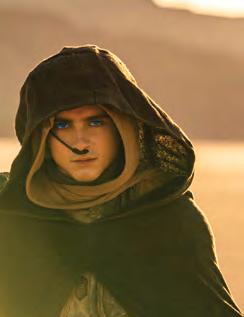
8
8 Po is back to kick some backside in Kung Fu Panda 4, from DreamWorks Animation! Another, much less cuddly bear stars in Imaginary, the new Blumhouse horror pic about a sinister stuffed toy.
10
Roll out the red carpet, the 96th Academy Awards are on tonight! The show airs live on ABC.
14 Part two of Invincible S2 brings more superhero mayhem to Prime Video.

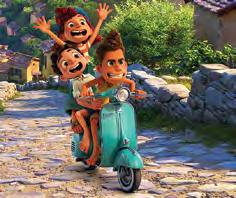

MIPTV returns to the Palais in Cannes for three days of television dealmaking. [miptv.com]
12
Prime Video makes a bid for the next video game series hit with Fallout
19 Salvador Simó’s Dragonkeeper opens in Spain following its Malaga festival premiere — Viva Kids will release the film in the U.S. this year.
Sci-fi fans can revel in Zack Snyder’s Rebel Moon - Part Two: The Scargiver on Netflix.
21
Liu Cixin’s sci-fi epic hits the screen in Netflix’s 3 Body Problem, from Game of Thrones showrunners David Benioff & D.B. Weiss and True Blood’s Alexander Woo.
22
Pixar’s 2021 movie Luca gets a proper theatrical release today, while the classic paranormal guardians return for a new chapter in Sony’s Ghostbusters: Frozen World
28
The new European co-pro series Bad Dinosaurs roars to life on Netflix.
29
The kaiju titans team up to battle an undiscovered threat in Godzilla x Kong: The New Empire, from Legendary Pictures. At home, muppet fans can dance their cares away with Fraggle Rock: Back to the Rock S2 on Apple TV+.

April



23
The International Animated Film Festival Stuttgart offers six days of screenings, talks, kids’ programs and experimental games, augmented by sibling events FMX (April 23-26) and Animation Production Days (April 23-25). [itfs.de | fmx.de | animationproductiondays.de]
26
The iconic echidna is back in Paramount+’s event series Knuckles, with Idris Elba reprising his role from the Sonic the Hedgehog movies. ◆
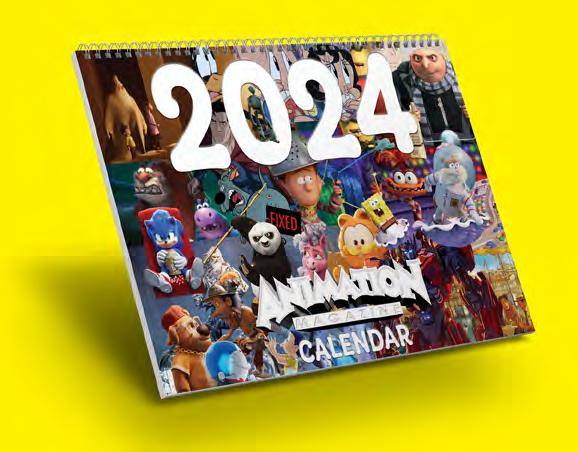
animationmagazine.net/calendar/
Keeping track of all the many animation and vfx shows and events each year is a lot easier with Animation Magazine’s annual trade-show calendar. Download our 2024 calendar, filled with great images and helpful info about all your favorite toon events and trade shows of the year.

The Calvin and Hobbes Portable Compendium Set 2 Books 3 & 4 of the paperback collections of Bill Watterson’s timeless comic. The new, portable format (6” x 9”) allows fans to take the imaginative, mischievous boy and his stuffed tiger BFF on the go — nearly 500 comics presented chronologically from March 1987 to July 1988. The second of seven planned volumes collecting one of the 20th century’s most popular and esteemed strips. [Andrews McMeel | $22 | March 5]
Tove Jansson: Life, Art, Words
Delve into the creative life of the famed Finnish-Swedish writer and artist which goes far deeper than her globally beloved Moomins. Author Boel Westlin (translated by Silvester Mazzarella) weaves together a rich life story through conversations with Jansson (1914-2001) and unprecedented access to her journals, letters and personal archives. [Univ. of Minnesota Press | $30 | April 2024]
Tim Burton: The Iconic Filmmaker and His Work
This new, updated edition of the book from the Iconic Filmmaker series brings fans and film buffs up to Burton’s latest endeavors, including the smash hit Netflix series Wednesday and the start of development on Beetlejuice 2. Explore the influences and behind-the-scenes details behind decades of acclaimed movies, including The Nightmare Before Christmas and Corpse Bride. [White Lion | $36 | March 5]



Wish
Includes Sing-Along version! Bonus features: Once Upon a Studio Disney 100th anniversary short ● Wish D-Classified (Easter egg guide) ● 100 Years in the Making: The Story of Wish ● Song Selection
● Deleted Scenes ● Deleted Song ● Outtakes
[Disney | $35 BD, $21 DVD | March 12]
Suzume
Bonus features: Roundtable Interview with Makoto Shinkai (director), Yojiro Noda (from OST band Radwimps) & Kazuma Jinnai (composer) ● Director’s Commentary ● Director’s Interview ● Director’s Filmography
Recap ● Radwimps Interview ● “Making Of”
Documentary ● Ending Scene “Tadaima”
Version ● Special Commemoration Videos ● Promos, Teaser & Trailers
[Crunchyroll | $35 BD | March 12]
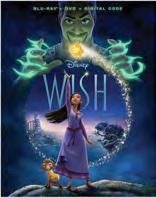

25 Golden Age Warner Bros. cartoons (1934-1964) on Blu-ray for the first time, including 10 films new to disc. Collection features rarities starring Daffy Duck, Foghorn Leghorn, Tweety & Sylvester, Bobo the Elephant and Quentin Quail; original Bugs Bunny shorts; early appearances by Egghead and Elmer; and the first color Merrie Melodies short, Honeymoon Hotel [WB | $22 BD | March 12]
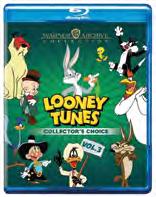
Based on Brian Jacques’ children’s fantasy books which have sold more than 20 million copies worldwide, two new video games from Forthright Ent. and Soma Games are ready to bring players to the forest floor. The Scout Anthology, available for PC, PS5 and X|S on Steam, is a narrative puzzle-driven action-adventure in three acts following young mouse recruits in Mossflower on a mission to save their home from pirates. For the cute and cozy casual gaming crowd, Feasts & Friends (PC, coming soon) savors the peaceful town of Lilygrove as players forage for ingredients, craft recipes and meet charming characters.
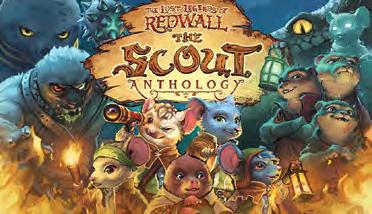
16 - 19 Sept . 2024
Toulouse - Oc c it a nie

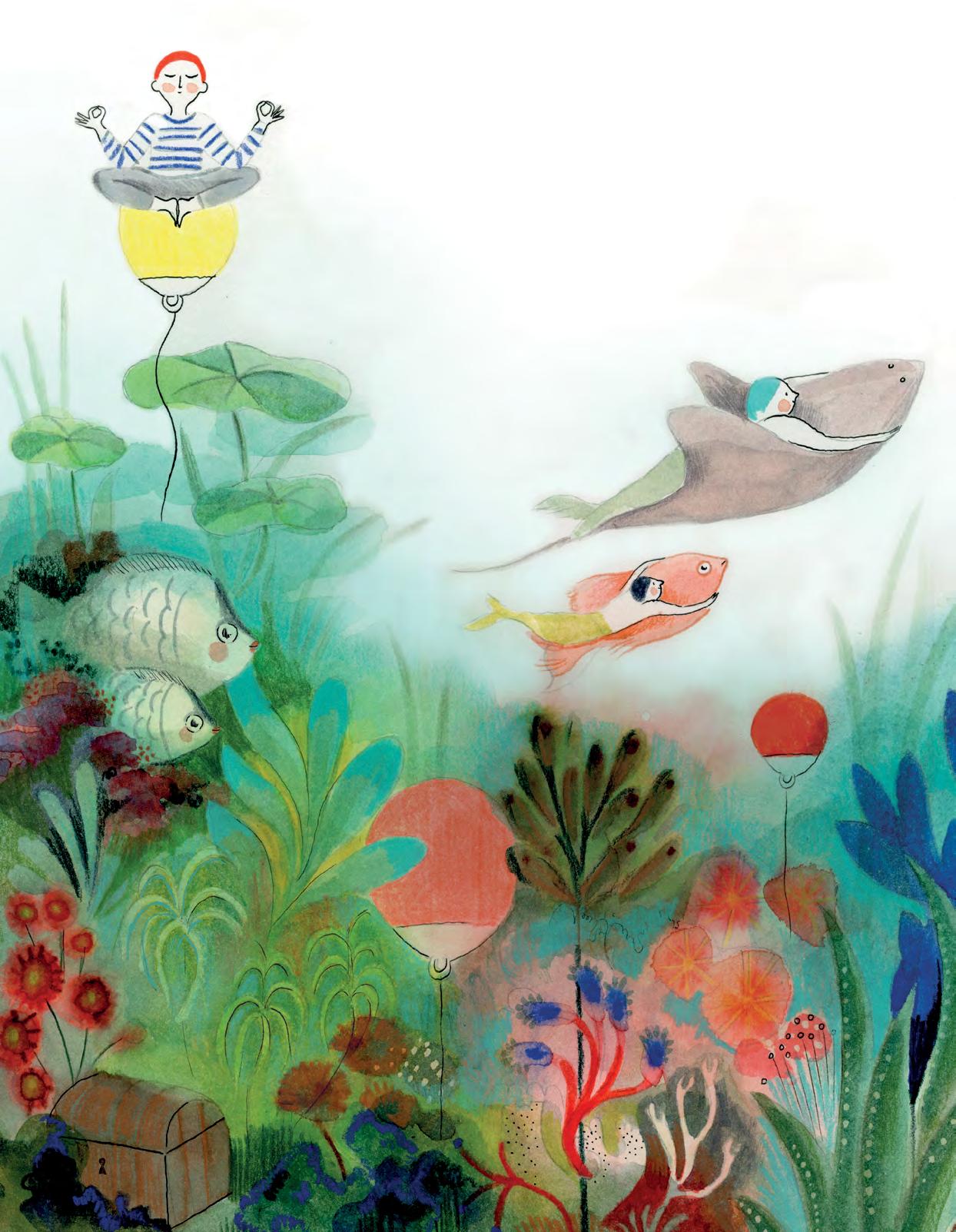
The creative team behind DreamWorks’ eagerly anticipated Kung Fu Panda 4 gives us a sneak peek of their labor of love.- By Devin Nealy -

With this month’s entry into the beloved franchise with Kung Fu Panda 4, the team at DreamWorks paralleled the historical development of kung fu by assembling a roster of veteran animators to mentor several rising stars in the studio’s distinctive style. “A lot of these guys I’ve known for years and years and years. They worked on Shrek with me; they worked on Trolls,” says Kung Fu Panda 4’s director Mike Mitchell. “I say this with all honesty: I think DreamWorks has the best animators all around.”
Kung Fu Panda 4 follows the continuing adventures of Po (Jack Black), who has evolved from an aspiring martial artist to the legendary position of Dragon Warrior across the preceding trilogy of films. In a beautiful dis-
play of art mirroring life, co-director Stephanie Stine, an avid fan of the series, has also found herself amid a professional ascension, with Kung Fu Panda 4 serving as her directorial debut. Like Po’s development as a martial artist, Stine battled insecurity while rising through the ranks in her animation career.
“I actually never thought that I would be directing because I grew up with a really awful stutter,” says Stine. “Filmmaking is all about communication and it’s all about talking out loud for hours on end. And so, I was like, ‘At this moment in my life, I’m not cut out for it.’”
Whereas Po’s teammates in the Furious Five, a pack of anthropomorphic animal martial artists, aided him in his journey, Stine relied on her collaborators, including production designer Paul Duncan and head of character animation Sean Sexton, to assist her
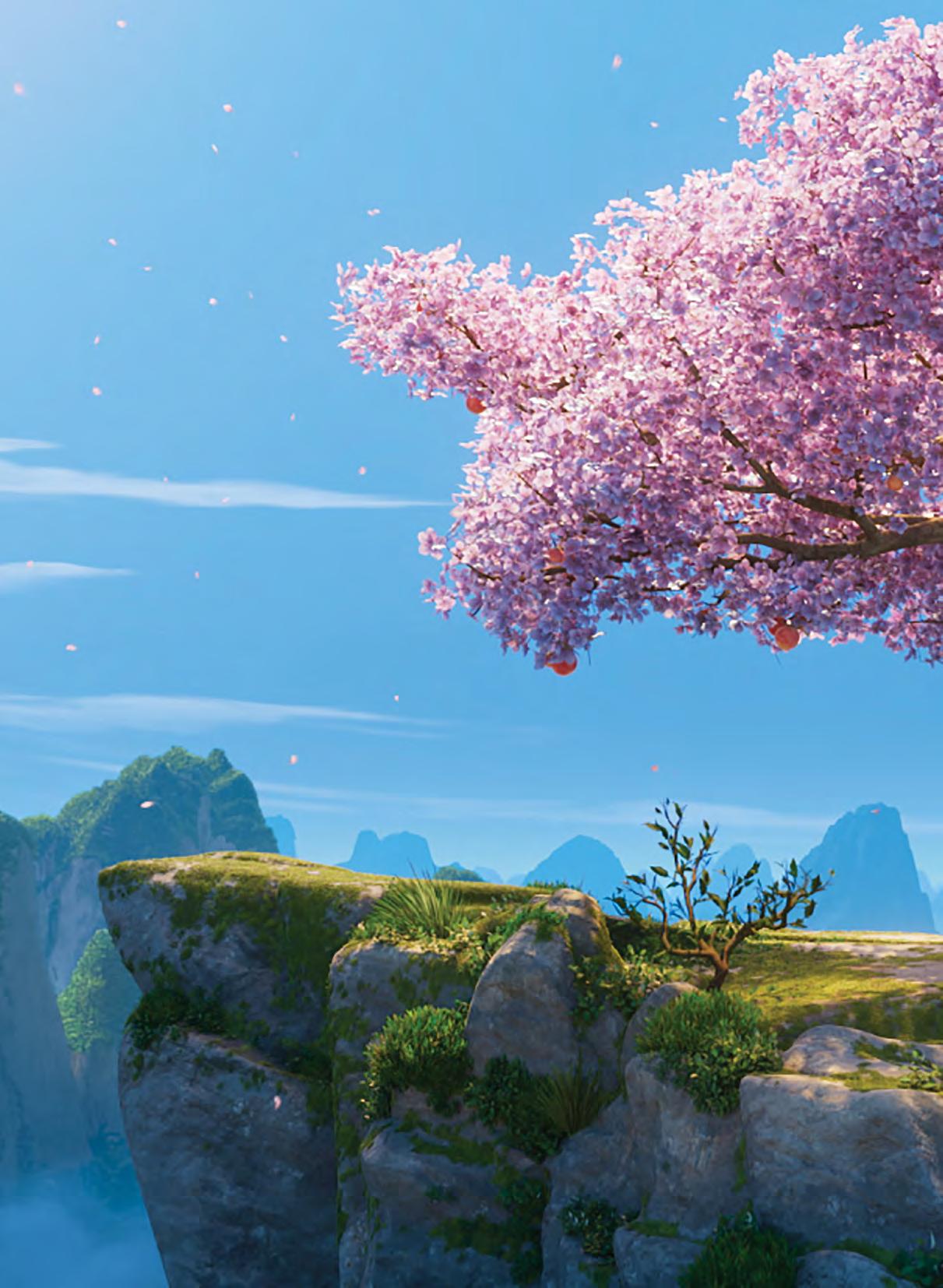
along the path. With a wealth of experience and a desire to innovate among the quartet, Sexton, Duncan, Stine and Mitchell began to embark on the creative high-wire act of taking the iconic Kung Fu Panda franchise in a fresh yet familiar direction. “We don’t want to do exactly what we’ve done with previous films. It’s like, ‘How has Po grown?’” says Sexton. “What is his arc? How can we move him forward in the franchise?”
To make good on their intention to shake up the intellectual property, the creative team behind Kung Fu Panda 4 decided to have the series’ protagonist, Po, relinquish his position as the Dragon Warrior, a title he’s owned since the first film. As a fan of the series, Stine shared the audience’s potential apprehension


‘Even since the last [Kung Fu Panda], there has been so much that’s evolved in animation — mostly, animation cameras. To use the updated cameras like GoPros that haven’t been incorporated yet in the Kung Fu Panda franchise was very exciting.’
- Director Mike Mitchell

over the film’s bold decision. “I think I can see from a lot of the audience’s reaction online already that people are just like, ‘Oh, my gosh, Po can’t let go of the Dragon Warrior title. That’s his destiny,’” says Stine. “I think we’re all a little bit scared and nervous about that, but I think for Po, it’s the most difficult for him. But along this journey, he comes to realize there are more important things.”
With the countless hours the creative team poured into obsessing over Kung Fu Panda 4’s
theme, the departure from the franchise’s familiar framework strategically avoids the pitfalls of feeling gimmicky. “Themes are really important to us, because I think it makes a difference in watching something. You really want it to be about something,” says Mitchell. “We really explored that when you make a big change, you don’t lose who you are. You still remain who you are, [and] you become something more.”
“In every single meeting that we go to
— whether it’s storyboards, editing, layout, lighting, animation or anything — everything hangs from the theme,” says Stine. “So, everything that Po faces is actually catered around him needing to learn that change is good.”
One of the unexpected changes that Kung Fu Panda 4’s production staff grappled with was the simultaneous Writers Guild and Screen Actors Guild strikes of 2023. With a truncated production schedule, Mitchell took the opportunity to expand the role of
RETURN OF THE DRAGON WARRIOR: Jack Black returns as Po, joined by several new voice stars, including Ke Huy Quan, Viola Davis and Awkwafina. The fourth cinematic outing for the popular panda is expected to be a big box office hit for DreamWorks.
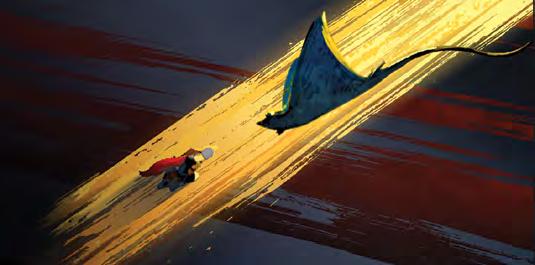
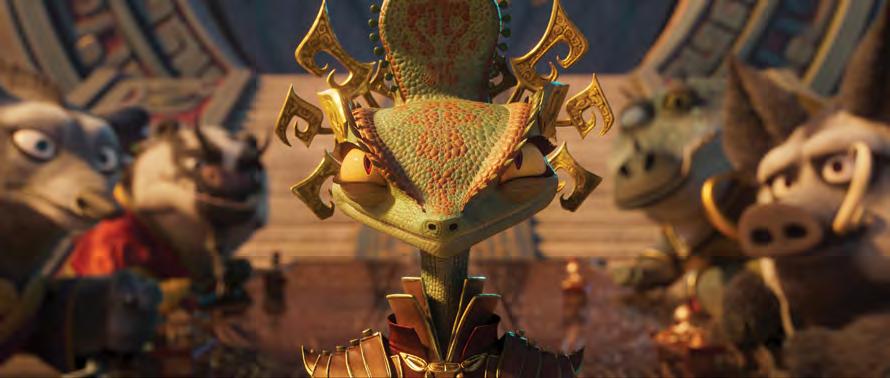
animators significantly. “A lot of our storytelling, I pushed it to animation, and these guys stepped up,” says Mitchell. “And all of them really got into the storytelling [and] got into the camera. Like, we were working out most of the film in the animation, which I think makes it a more creative film.”
Despite taking divergent routes into the animation industry, the early days of Paul Duncan’s and Sean Sexton’s careers at DreamWorks share a handful of similarities, as both men arrived during the studio’s era of 2D animation. Even with countless films under their belts, including previous entries into the Kung Fu Panda series, both men speak about Kung Fu Panda 4 as if it were their first film. “There is a legacy to Kung Fu Panda, and to break the mold too much would be a disservice to


what’s come before,” says Duncan. “So, for me and the director, Mike Mitchell, it was always, ‘Let’s stylize parts of the movie that we want to enhance the story.’ We won’t just check that box for the sake of checking the box.”
Seeking to inject new life into the series, Sexton and Duncan found themselves looking at myriad sources for Kung Fu Panda 4’s villain, a shape-shifting chameleon sorceress. “The Chameleon was a character that could have the potential to be one of the strongest in the franchise,” says Sexton. “[It’s] a character that could transform into any creature [or] any other master, and trying to technically figure that out was difficult. And also, just artistically, ‘How do we pull this off? How do we make this look interesting?’”
“Paul [Duncan] was great for coming up with ideas of how this would work,” says Sexton. “We literally looked at any movie with any kind of
transformation and tried to make something unique but also relatable and cool.”
To solve the Chameleon conundrum, Duncan found an answer within an unexpected and controversial source. “We looked at a lot of AI for that and a lot of the effects. We sort of left the broken bits in because it felt disjointed. It’s almost like it’s uncomfortable for her to change.”
Besides exploring AI, Sexton decided to revisit an often-overlooked gem within his DreamWorks filmography. “We even went back and looked at some of the stuff we did in 2D on Sinbad: Legend of the Seven Seas as kind of an inspiration,” says Sexton. “Eris was a character that was voiced by Michelle Pfeiffer, [and] she was a character that could transform and turn into different things.”
Duncan was equally influenced by the past, finding inspiration in the very culture that
‘Po’s whole journey is about accepting change and realizing that it’s not only not a scary thing but quite fulfilling if you embrace it. I feel like I was going on a similar journey as him.’
- Co-director Stephanie StineLEAPING LIZARD: Viola Davis voices the Chameleon, a terrible new villain who has the ability to summon the spirits of all of Po’s previous enemies.

‘We even went back and looked at some of the stuff we did in 2D on Sinbad: Legend of the Seven Seas as kind of an inspiration.’
- Head of character animation Sean Sexton

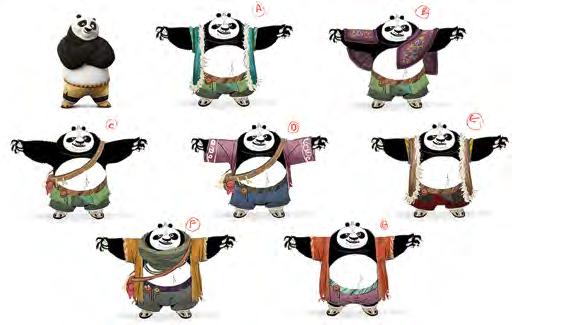
A VISUAL FEAST:
The talented artists at DreamWorks looked at a variety of Asian art as well as the studio’s rich cinematic history to find inspiration for the designs of the new characters in the movie.
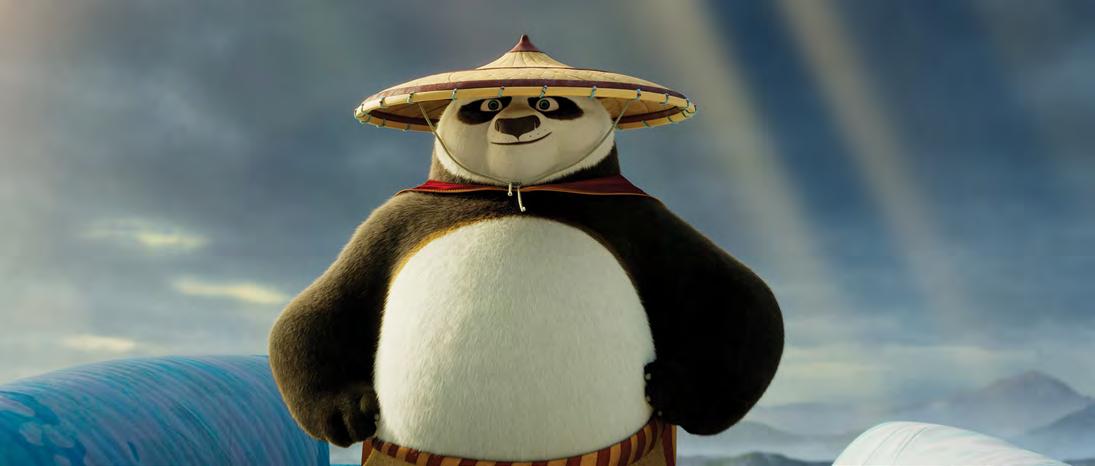
spawned kung fu. “We looked at a lot of the Taotie design from ancient China,” says Duncan. “It’s associated with greed and ancient demons. You basically have all these Taotie masks, and I was like, ‘This is perfect, because she changes all the time, and we rarely get to know her because she’s got this mask on.’”
Although a film like Kung Fu Panda 4 allows its production staff to stretch the perimeters of its creative license, Mitchell and Stine were intent on grounding the movie’s combat in realism. “We hired some live-action stunt performers from the Marvel films,” says Mitchell. “It was really fun for our animators to take a look at what a bunch of our stunt people

did and then know that we could take it even further with animation.”
“Even since the last [Kung Fu Panda], there has been so much that’s evolved in animation — mostly, in my opinion, animation cameras,” says Mitchell. “To use the updated cameras like GoPros and stuff like that that we’ve seen in live-action films that haven’t been incorporated yet in the Kung Fu Panda franchise was very exciting.” For Stine, the new cameras presented a unique opportunity to return to her roots. “I actually have a master’s degree in cinematography from the American Film Institute, so I used to work in live action as a camera person,” says Stine. “I’ve always had a love of lenses and types of cameras and what you can do with the camera, and how that ties
into knowing what the character is thinking and feeling.”
Navigating the film’s action-packed visuals may have been a walk in the park for Stine, but the director also credits Kung Fu Panda 4 for strengthening her literal and creative voice by helping her finally conquer her persistent stutter. “I think this particular journey of working on Kung Fu Panda 4, especially, has really helped me with my confidence,” says Stine. “Po’s whole journey is about accepting change and realizing that it’s not only not a scary thing but quite fulfilling if you embrace it. I feel like I was going on a similar journey as him.” ◆
DreamWorks’ Kung Fu Panda 4 opens in theaters nationwide on March 8.
photo credit: John Sciulli ©2013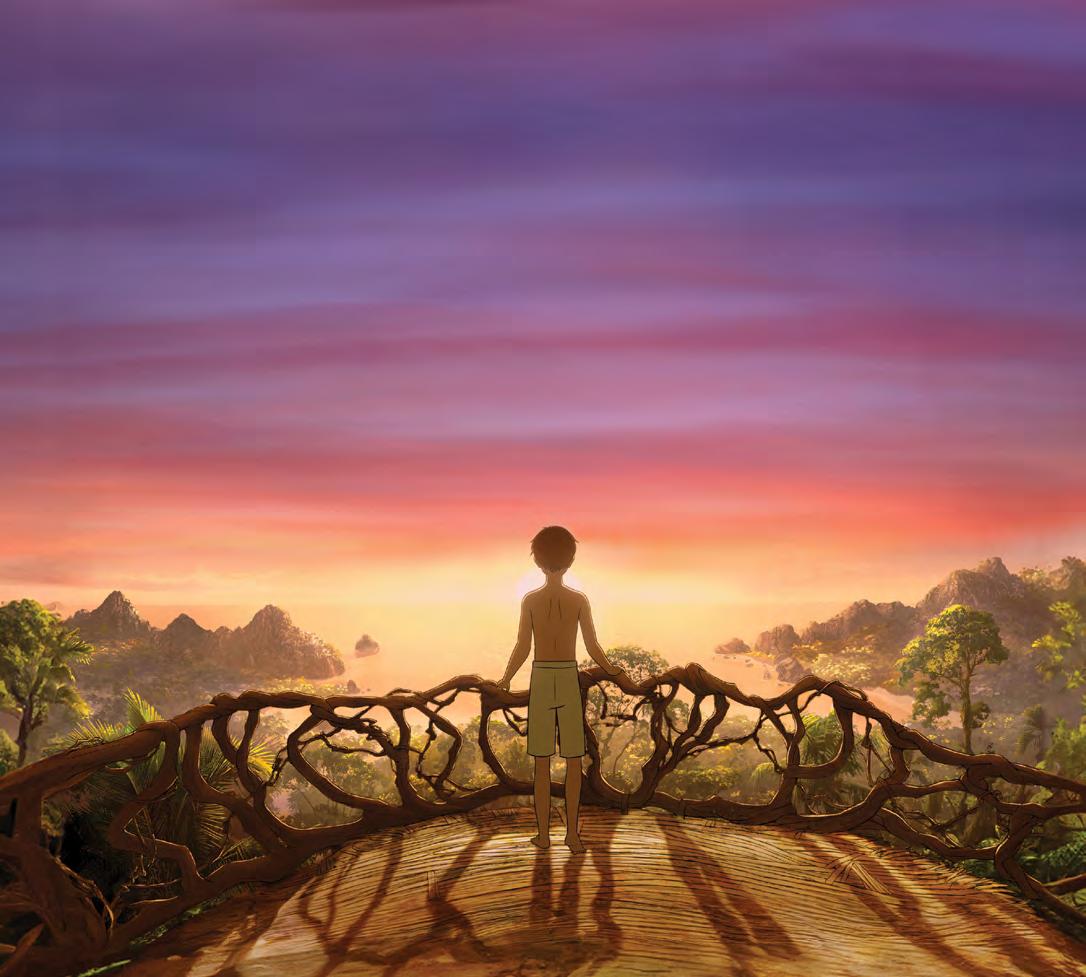
When Michael Morpurgo’s beloved children’s book Kensuke’s Kingdom was first published in 1999, readers fell in love with its memorable characters and strong ecological theme. The story centers on a young boy and his dog, Stella, who are shipwrecked on a remote island. It’s here that he meets a mysterious Japanese man who has lived there secretly since World War II. Despite initial mistrust and anger, the two strike up a friendship to protect the island from dangerous invaders.
Fans of the book will be happy to know that it has inspired a beautiful, 2D-animated feature, which is directed by Neil Boyle and Kirk Hendry and produced by Camilla Deakin, Ruth
Fielding, Sarah Radclyffe, Barnaby Spurrier and Stéphan Roelants. After debuting at the Annecy Festival last year, the movie opened in French theaters last month and will be showcased at Cartoon Movie in Bordeaux and the New York Int’l Children’s Film Festival in March.
Deakin, who is the co-founder of U.K.-based Lupus Films and has produced a long list of award-winning projects, such as The Snowman and the Snowdog, Ethel & Ernest, We’re Going on a Bear Hunt and Mog’s Christmas, was familiar with the book as her sons had read it at school. “I knew it was a fantastic story,” she says. “We met with the producers Sarah Radclyffe and Barnaby Spurrier and all got along well, so we decided to
embark on this epic journey together!”
The producer says it took a while to raise the financing, and the project was finally greenlit to get into preproduction in the summer of 2020. “That was right in the heart of the COVID pandemic,” she recalls. “We had to adjust pretty rapidly to everyone working from home, but we managed it fairly well, and Neil and Kirk quickly got used to briefing the crew and giving feedback over Google Meets and Slack.”
“We always joked that the pandemic created the perfect situation to make a film about being isolated on a desert island, because in reality we were all isolated in our houses and home studios!” says Boyle. “But credit to the production staff at Lupus Films — they figured out a way for all our artists and technicians to communicate

‘Michael Morpurgo always includes important themes, such as the value of respecting nature and protecting animals and finding understanding across different cultures — but always in a way that is integral to the story.’- Producer Camilla Deakin
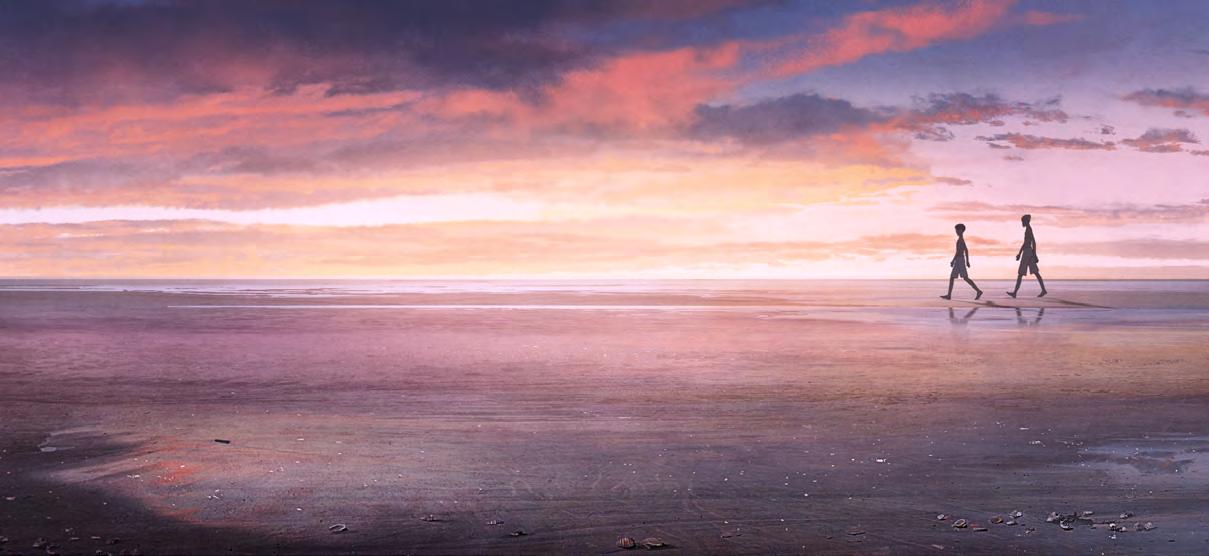
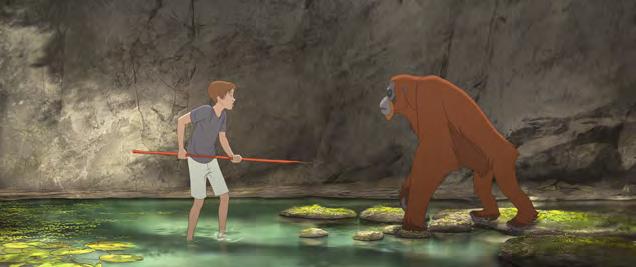
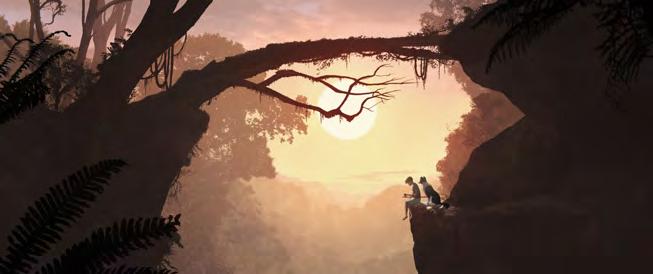

and share work, and we even had a few online parties along the way, so we had a much easier time of it than the characters in our film!”
Deakin says one of the things that drew her to the project was the way her sons, who were around nine or 10 at the time, responded to it. “They were drawn in by the sense of jeopardy for the young boy Michael, the terror he feels when he first washes up on the desert island and the tenderness of the relationships he
forms with Kensuke and the animals,” she notes. “Michael Morpurgo is so good at writing adventure stories with a heart, and he always includes important themes, such as the value of respecting nature and protecting animals and finding understanding across different cultures, but always in a way that is integral to the story.”
Hendry believes that the book is a rare beast. “It’s [a] proper adventure story full of action and excitement, but at the same time it
is also extremely gentle, with a complex emotional core,” he explains. “These two things don’t often sit side by side. It also includes a really important ecological message for our times. To have all three of those things — adventure, emotion and a timely message — that plays well to all ages, is a tremendous gift.”
One of the biggest challenges for the creative team was to find ways of telling the story with the minimum of dialog. “We approached

‘It’s a proper adventure story full of action and excitement, but at the same time it is also extremely gentle, with a complex emotional core. It also includes an important ecological message for our times.’
- Director Kirk Hendry

the film this way for two reasons,” explains Boyle. “The first is because it’s a film about people and other animals, who do not share a common spoken language: Michael is an English boy who cannot speak Japanese, and Kensuke is a Japanese man who cannot speak English. And none of the humans can communicate verbally with the animals. So, we had to find ways for our characters to show, rather than speak, their emotions. The second reason for minimizing dialog is that both Kirk and I are fans of very visual storytelling. We love to play with composition, camera blocking, body language, production design, color palette, sound design and the musical score, the combination of which, we feel, gives the audience the strongest cinematic experience.”
About two-thirds of the animation was produced in the U.K., managed from the Lupus Films studio in London. The other third of the animation was done by co-producer Melusine Productions at their studio, Studio 352, in Luxembourg. Storyboarding, layout and background artwork were also divided between the U.K. and Luxembourg. The 3D visual effects and compositing were done in Wales at Bumpybox.
“The tools we used to make the film were quite varied, ranging from old-school pencil and paper for some of our initial character designs, through to TVPaint software for our final 2D character animation,” says Boyle. “We also used Maya and Unreal Engine for our 3D work; Photoshop was used for much of the background painting; and everything was
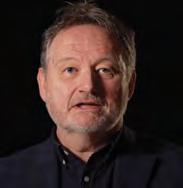
EARLY ACCOLADES: Kensuke’s Kingdom was nominated for four British Animation Awards (Best Feature, Writing, Music and Sound) last month.

composited in Nuke.”
Hendry adds, “In terms of characters, we went quite naturalistic in proportion as we felt the drama required it. In overall design terms, Neil and I often reference matte paintings from the Golden Age of Hollywood and beyond. The not-quite-real artifice of it all allows you to readily suspend your disbelief. They are full of charm that is often missing from [the] digital photoreal matte paintings commonplace in contemporary films. We also took inspiration from the sketch work of Japanese artist Hiroshige for our Nagasaki flashback sequence. The simplicity in the line and the use of negative space in the environment is beautiful and contrasted nicely with the rich style of the rest of the film.”
The creative team hopes audiences around the world will fall in love with the characters and the involving narrative as much as they
did. “First and foremost, we want them to leave the theater feeling they have been fully entertained and, perhaps, also wiping away a bittersweet tear,” says Boyle. “But beyond that, we worked hard to preserve Michael Morpurgo’s message of hope and the idea that ‘family’ — blood families, chosen families and the wider family of humans, animals and the natural world — is something to be respected and cherished. And I really think we have successfully achieved that. “
He adds, “Michael is very, very proud of our adaptation, and he has told us that it is the one film he feels is even better than his original book! So, obviously both Kirk and I, and our whole creative team, are thrilled to hear that, and we continue to be thrilled by the wonderful audience reactions we are getting.” ◆
For more info, visit lupusfilms.com.




How director Yuzuru Tachikawa captured the passion of the vibrant Tokyo jazz scene in his acclaimed movie, Blue Giant.
- By Kambole Campbell -
In its explosive, almost impressionistic approach to musical sensation and its often-punishing viewpoint of the grit required of artistic success, you couldn’t call Blue Giant short on passion. Adapted from the manga by Shinichi Ishizuka, the high points of Yuzuru Tachikawa’s film elicit the euphoria of live music as it goes on a whirlwind tour of Tokyo’s jazz scene. Musical solos turn into dazzling explosions of color and light, and the sensations and thrill of playing translate into wildly expressive imagery: At one point, a saxophonist hits a perfect note, and for a moment the instrument seems like it stretches into the infinite.
The sax player is Dai Mi yamoto, and the film consoli dates the manga’s broader arc into a snapshot of his attempts to make it big in Tokyo. After he moves into the city he reunites with an old friend, Shunji, who would later become part of a
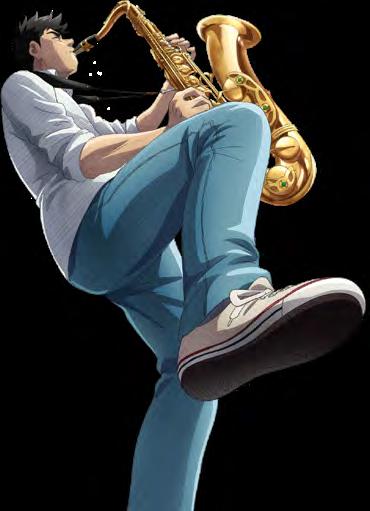
band together with him and the prodigal pianist Yukinori Sawabe. Speaking to Tachikawa in London, he says he wouldn’t have called himself a jazz enthusiast before he joined the film — now, not unlike Shunji in the film, the bug has got him, too. “The first thing I did when I started making this film was start learning the sax and go to some jazz clubs,” he explains. When pressed on how the saxophone playing was coming along, he elaborates: “So, I went to lessons for two years and I can play some basic pieces,” Tachikawa mused. He adds: “I can’t play the pieces in Blue Giant, they’re way too hard for me.”
It’s a film that not only engages with the broader emotional requirements of becoming a successful artist but also marvels at technical precision — and to show that, it needed to show the intricacies of the instruments themselves.
“Everything I learned was
beneficial to the film, because I’d never held a saxophone before,” he says. “I didn’t know if you press here, what happens? I didn’t know how to put my lips around the mouthpiece; absolutely everything I learned from scratch. And I also got some of the team as well to go to a sax lesson just so they could also get a feel for how it’s made.”
Although animating instruments and live musicians at the top of their game is tricky enough, naturalistically portraying amateurs might be even more difficult — one of Blue Giant’s leading trio, the amateur drummer Shunji, was an interesting challenge to get around, if only for the simple fact that the musicians they were using for reference were simply too good at what they do. Tachikawa explains, “The drummer is Shun Ishiwaka; he’s really well known in Japan. Even when he tried to play badly, it was still really good, and I had to keep telling him to do it worse.”
To get a feel for the movements of an amateur, Tachikawa went DIY again: “I went to a drum lesson as well and got a feel for just how bad a beginner it would be, and that was what I was aiming for.” Of course, though, they had some experts playing behind the scenes.
Together, Ishiwaka, saxophonist Tomoaki Baba

‘We wanted to get people listening to jazz and to get people thinking of it as not something slow and boring, but something passionate and emotional.’- Director Yuzuru Tachikawa



and legendary pianist Hiromi Uehara, who also composed the score, played the instruments of each character of the core trio — though Tachikawa noted that they used independent sessions with different artists to use for reference footage. The music was written and recorded first, Tachikawa emphasizing that Uehara was actually “on board from the beginning.”
The sessions in which they recorded the music for the film were separate from the sessions used for animation reference. According to Tachikawa, “They actually tried hard to stay still, so as not to make any noises that might be picked up on the recording, but Dai’s style of playing is very dynamic, and he moves around a lot; it’s very exaggerated movements. So, although I did reference their expressions and the movement of their fingers when they were actually recording the music, the movement comes along later at the animation stage.” For this, Tachikawa had another set of musicians whose sessions performing the pieces were “more about the movement.”In capturing the movements of these players, the animation had to be dynamic itself and required the interweaving of traditional 2D drawings and CG animation. Tachikawa briefly talks about the logistics of it,
saying that “the performance spaces are 3D, and so with the camerawork, it would’ve been hard to just have the characters in 2D. So, for those parts, the characters are CG as well.” Tachikawa also mentions the merits of both mediums, in the case of 2D, the potential for exaggerated expressions and deformation of the characters.
The director says deformation and exaggeration stand out about the musical sequences, in addition to the passion and the pace. The film impresses with its attention to technical detail in instrumentation but also the dreamlike expressionism of its musical sequences, as Tachikawa shows what the performers are seeing when they’re in the zone. A lot of what they were seeing — the use of color and flashes of light in corresponding with the sound — might remind some of something like Disney’s Fantasia’s “pure sound” segment.
The director mentions that he did watch Fantasia, as well as a lot of different music animation, but also pointed to older art animation. One particular piece of animation that stood out in his mind when shaping Blue Giant was Norman McLaren’s 1955 short, Blinkity Blank, because of how “it’s not actually animated; he creates colors by
scratching film.” Such a form of expression didn’t just have some bearing on Blue Giant, it also held some sway over his other work — the director highlighting his beloved anime TV series Mob Psycho 100 as one example.
Although the film takes place in a Tokyo jazz scene which seems to exist just out of sight, Tachikawa hoped to present jazz as something universal, not simply niche. When thinking about a sequence from the film that stood out to him the most, he cited the performance of “First Note.” The director says it was a definitive point for them “because, to begin with, we didn’t know what Dai’s saxophone playing would sound like, and that was the piece where we worked out, figured out his sound, and came up with that, so it was an important piece.” But it also spoke to that goal for the film. “We wanted to get people listening to jazz and to get people thinking of it as not something slow and boring, but something passionate and emotional,” he says. As Dai and his bandmates play their hearts out, the passion of Blue Giant is infectious — just as much as the catchy rhythms of its music. ◆
GKIDS and Shout! will release Blue Giant on DVD/ Blu-ray on April 30.
The creative duo behind the new X-Men ’97 offers us a special look at the making of the nostaglic Marvel series.
- By Tom McLean -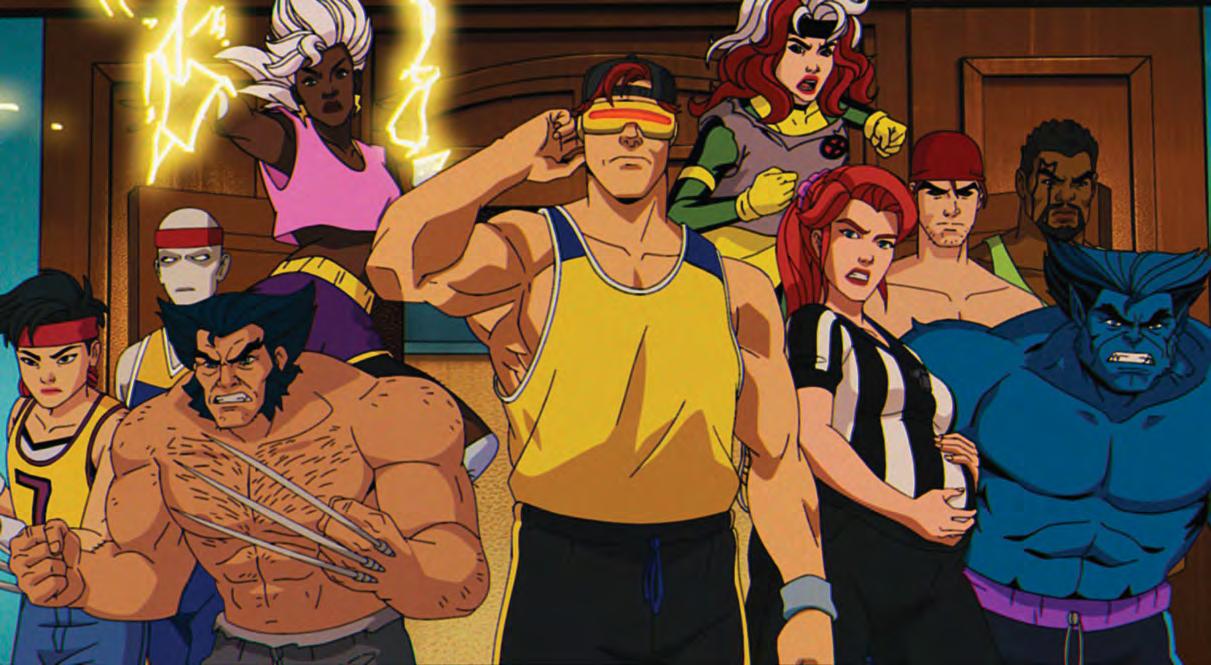
If you were a kid during the 1990s, odds are any mention of X-Men: The Animated Series instantly ignites your brain with that iconic theme song and title sequence. So, the X-Men ’97 revival and continuation of the beloved series that’s arriving on Disney+ this month must include or re-create that experience in some way, right?
Let’s back up! X-Men: The Animated Series was a runaway Saturday morning cartoon hit from the moment it debuted in October 1992 through its 76th and final episode in 1997. Jampacked with stories and relationships developed in the Marvel comic-book series created in 1963 by Stan Lee and Jack Kirby, X-Men: The Animated Series remains iconic for an entire generation of fans. As ’90s nostalgia grows, along with anticipation for the X-Men’s arrival in the Marvel Cinematic Universe, reviving the series instead of rebooting it seems a natural move.
“It was the concept from the beginning that that we wanted to, to the best of our ability, emulate the OG series,” says Brad Winderbaum, a 15-year Marvel Studios veteran and executive producer on X-Men ’97, which will have a 10-episode first season.
Immediately on board was Beau DeMayo, a die-hard fan of the original series who is serving as executive producer, showrunner and head writer on the series. DeMayo credits much of the original show’s success to Eric Lewald, who developed the series for TV and served as story editor with his wife, Julia; and Larry Houston, who directed 69 of the show’s 76 episodes. (The Lewalds wrote two books that helped revive interest in the show.) “I don’t think it’s an overstatement to say the Lewalds and Larry Houston are the grandparents of the MCU,” DeMayo says.
The original series thrived despite its extremely tight budget and time constraints by cramming as much story as possible into each episode — an experience that helped audiences overlook some of the seams in the animation work while perfectly capturing the frenetic style that had made X-Men comics so popular.
For DeMayo, however, the real key to the show is in the characters’ relationships and the human drama, rather than the toyetic approach common at the time for animated adventure shows.
“It’s the melodrama,” he says. “We will have the cool powers and villains, but at the end of the day you’re more curious about why Apocalypse rearing his evil head complicates Jean and Scott’s marriage more than you are about what is Apocalypse trying to do and how are they going to beat him."
It’s been fun to bring back the series’ sunny 1990s outlook on mutant-human relations in

'I think it’s very smart to bring this show back to take us back to the core truths about who these characters are, before then seeing how they enter the MCU in a larger capacity.'
— Exec producer and showrunner Beau DeMayo
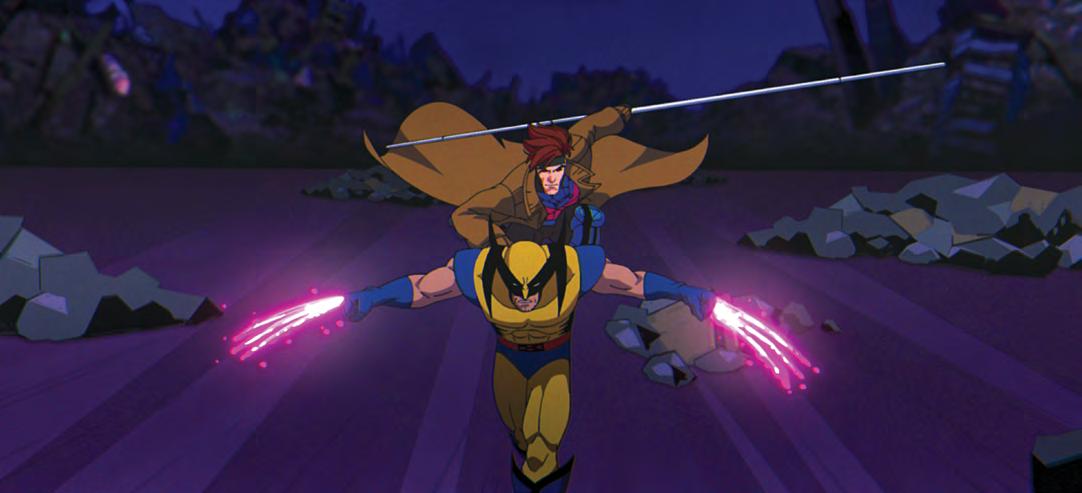
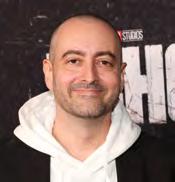
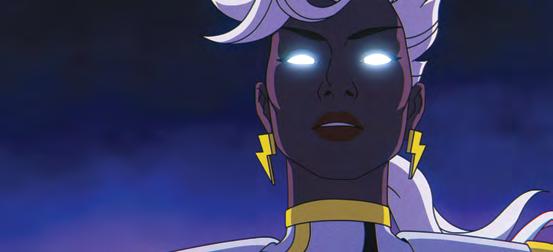
our more complicated times, even when it presents problems. DeMayo says the new show doesn’t apologize for being quintessentially ’90s, even when it at times is awkward in ways he generously describes as “cozy.” “Storm will always announce her moves; Rogue is always going to have the therapy metaphor,” he says.
Some characters presented more difficulties than others. Jubilee was especially difficult because young people today don’t act the same as they did in the 1990s, so her character can’t fill the same function. For Beast, DeMayo drew on his experience writing for Star Trek: Strange New Worlds and put in placeholders for the character’s scientific jargon. A similar problem emerged for Rogue, whose knack for Southern metaphors and analogies didn’t come as easily to DeMayo.
“Those tend to stop a scene every once in a while for me as I’m writing,” he says. “[She] surprised me not in terms of difficulty, but just
her character emerged in Season One in a way that I did not expect when I first conceived of the season.
Bolstering the revival’s credibility with fans is the return of a large portion of the original voice cast, including Cal Dodd as Wolverine, Alison Sealy-Smith as Storm, Lenore Zann as Rogue, Chris Potter as Gambit, George Buza as Beast and Catherine Disher as Jean Grey. (Alyson Court gave up the role of Jubilee beause she thought an Asian actor should voice the character, but Court has other roles in the new version.)
Lead character designer Amelia Vidal says she took advantage of the revival to bring in a full variety of body diversity. “For example, if we take Jean, Rogue, Storm and Jubilee, they all have different body proportions, heights, age, physical builds and posture attitudes,” she says. “[The] X-Men are so different from each other; celebrating those differences makes each character unique and special.”
The look of the show is equally important, and creating something that both evokes the original and meets modern audiences’ expectations requires an approach that director Jake Castorena describes as fresh but familiar.
“It needs to be the show we remember, but it has to be in 4K, because the reality is we’ve learned so much just in the art form of TV animation itself — from what works, what doesn’t work, technical advancements, production advancements, artistic advancements,” he says.
“To do the show, verbatim, as it was, it would be difficult to stay relevant.”
That’s where studying the original series and finding out what made it tick helped set a course for the new show’s visuals. “It’s who do you cut to and when,” he says. “Just because Scott is doing team leader [stuff] and he’s saying his thing doesn’t mean we’re not [focusing] on Jean worrying about whatever they’re going through at the moment."

'It needs to be the show we remember, but the reality is we’ve learned so much just in the art form of TV animation itself. To do the show, verbatim, as it was, it would be difficult to stay relevant.'
— Director Jake Castorena


Although there may be a temptation to limit the animation to evoke the ’90s style, Castorena says it’s more easily achieved with other techniques.
“If we put too many bells and whistles and did all the new fancy things that we can do with technology, it wouldn’t be the show you remember,” he says. The answer was less about technology and more about how the show was storyboarded. “It’s a lot about compositions and lenses, trying to adhere to what was cinematically being done at the time.”That includes some interesting little tricks, Winderbaum says. “Part of the design of the overall look of the show is to create a small video transfer effect over the animation to give it a little bit of that television in the ’90s patina,” he says.
Evoking memory with those techniques also makes it possible to occasionally break
the rules and open up the action in ways the original series could not. “We have a strict code of ethics,” says Winderbaum. “But there are specific points where we crack it on purpose for what I think is great dramatic effect.”
With a second season already on order and the X-Men poised to enter the Marvel Cinematic Universe — perhaps as early as this summer’s Deadpool & Wolverine — the future looks bright for the X-Men.
“I think it’s very smart to bring this show back to take us back to the core truths about who these characters are … why we fell in love with them in the first place, before then seeing how they enter the MCU in a larger capacity,” DeMayo says.
But what everyone still wants to know is
whether they’ll re-create that opening title sequence and use the original theme song. Winderbaum confirms Larry Houston directed the new show’s opening sequence. Castorena adds: “I feel we’re doing it right. And if you want to do things right, there are just certain things you may or may not have to include."
DeMayo also won’t confirm but gives fans hope: “Everyone knows what that theme means to people, what that main title means to people. And we are big believers over here of not setting ourselves up for failure.” ◆
X-Men 97 will premiere on Disney+ on March 20. A new episode debuts each week.
Tom McLean is a lifelong X-Men fan and author of Mutant Cinema: The X-Men Trilogy from Comics to Screen, published by Sequart.

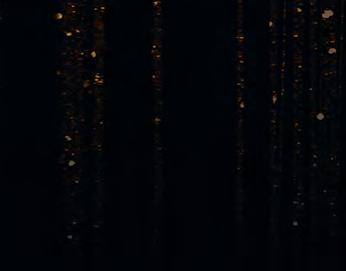
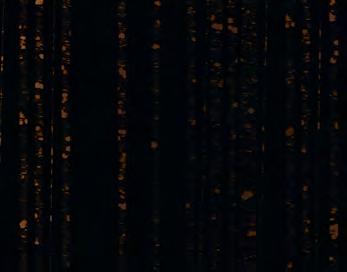
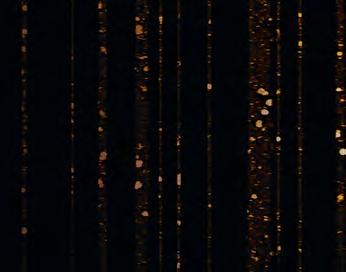


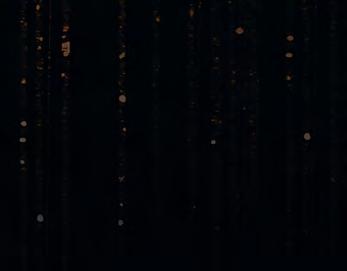

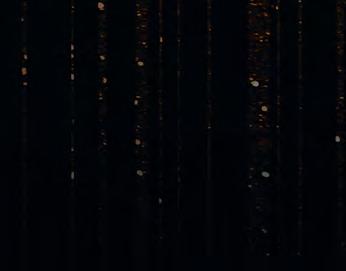





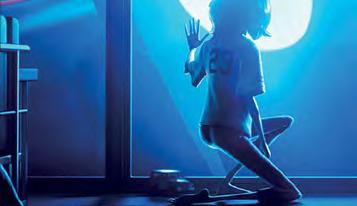
SUNMIN INN
ART DIRECTOR
ULTRAMAN: RISING
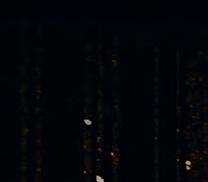
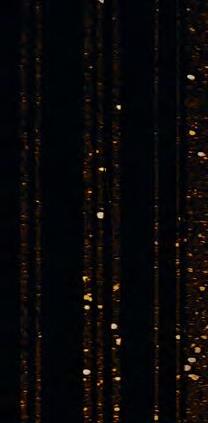
























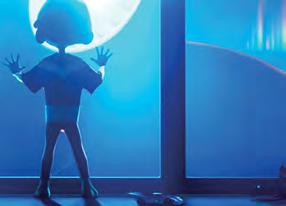

















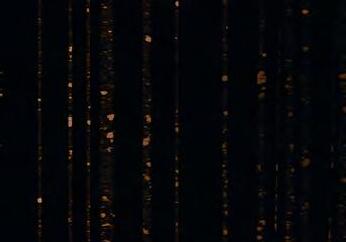
UWE HEIDSCHÖTTER CHARACTER DESIGNER THAT CHRISTMAS


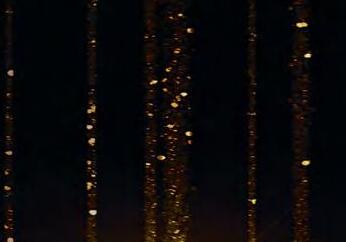

The place where you spent your childhood and called home can keep a magical hold on you throughout your life. Nigeria is the foundation of the new animated Disney miniseries Iwájú, which premiered in February.
Set in Lagos, where Olufikayo Ziki Adeola, the co-founder of the U.K.-based Kugali Media, lived until his mid-teens, the original animated show takes place in a futuristic version of the city and follows Tola, a young girl from a wealthy background, and her closest friend, Kole, who is a self-educated tech expert, as they grow up and learn about the beauty and the dangers of their world. Iwájú weaves the culture and traditions of Nigeria with a sci-fi edge that gives the show a unique look.
Adeola directs the series. Walt Disney Animation’s Christina Chen is producing with Jennifer
Lee, Walt Disney Animation’s chief creative officer, serving as executive producer. The screenplay is written by Adeola and Halima Hudson. Toluwalakin Olowofoyeku is the cultural consultant.
“The primary source of inspiration was my time growing up in Lagos,” says Adeola. “I’m Nigerian and I grew up in Lagos, then I emigrated to the U.K. when I was about 15 years old. Throughout my life in the U.K., I’d always wanted to find a way to share my experience of living in Nigeria with my friends here in the [U.K.] I always knew I wanted to tell a story that was effectively some kind of representation of Lagos because it’s such a really interesting place with so many idiosyncrasies that, I think, are unlike many other places in the world. This is a love letter to Lagos.”
Adeola says he wanted the show itself to be
a realistic representation of the Lagos experience. “Lagos is a beautiful city, but some of these realities are also a little bit harsher,” he admits. “I wanted people to be able to experience that, that medley of life in Lagos, but then also give them an opportunity for escapism, because we want to enjoy the shows we watch. So, that’s where the sci-fi elements come in.”
Award-winning VFX veteran Marlon West (whose long list of Disney credits including The Lion King, The Princess and the Frog, the Frozen movies, Moana and Encanto) adds, “We were we trying to make Lagos today recognizable to anyone who lives there and has visited there. There are flying cars because the show is set in the future, but there are still buses. There is facial recognition and there are robots, but there’s still cash because Nigerians prefer cash to using credit cards. There was an authenticity that we were trying to nail but still make something

'We want the audience to feel those emotions when they see the animation and hear the music. Our story is set in Lagos, but the theme of the innocence of our protagonist against harsher realities is universal.'
— Creator Olufikayo Ziki Adeola
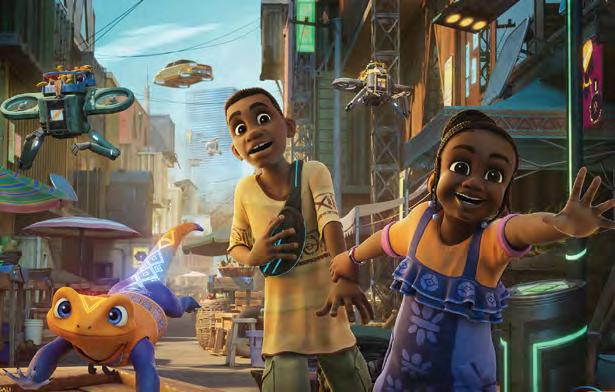
that was fun. The audience is going to be connected to the real world of Lagos but also to these interesting sci-fi elements.”
Animation for the series was done at Cinesite’s Montreal and London locations, while storyboards and preproduction were done at Walt Disney Animation’s Burbank and Vancouver sites. Hamid Ibrahim served as production designer for the show and is also creative director at Kugali Media.
“Our production designer wanted to have kind of a painterly look on things as they receded into the distance,” says West. “We decided to dial in and out of that, because it looked great in some scenes, but we didn’t want to use that painterly look for depth of field. When you’re in a flying car looking over the mainland, you don’t want a bunch of brushstrokes down there because you want to really see the lights of this beautiful world. We also just have the character design a little pushed as far as angles and things, and we kind of let some of the lighting go from one side being lit up to one side being darker in a way. This may not be what we usually do, but [it] was also in support of the world we were trying to make and the visual storytelling our production designer wanted to use.”
In keeping with the realistic portrayal of Nigeria, Adeola wanted to cast actors who could represent the Nigerian accent accurately so that audiences who are from the country wouldn’t be taken out of the story by something that didn’t

FUTURISTIC VISION: Olufikayo Ziki Adeola’s new Disney+ show Iwájú centers on a a young girl named Tola from a wealthy island and her best friend, Kole, a self-taught tech expert who discover the secrets and dangers hidden in their different worlds. Marlon West
seem real. The series stars Simisola Gbadamosi as Tola, Dayo Okeniyi (a Nigerian American actor known for playing Thresh in The Hunger Games and Danny Dyson in Terminator Genisys), Nigerian actor Femi Branch, Siji Soetan as Kole and Weruche Opia (a British Nigerian actor known for her performance in I May Destroy You).
“Disney worked with a casting agent based in Lagos because authenticity is important,” says Adeola. “One of my pet peeves is hearing African accents butchered in various productions. Having a local casting agent based in Nigeria helped us connect with people who are either based there and can really pull off the accent in addition to their acting talent or [those] who are formerly from Africa or have family from Nigeria, because that’s a huge help. They sent me a lot of materials from auditions and, in truth, the ones who we ended up casting stood out the second I listened to them.”
The show creator also wanted music for the series that supported the storytelling and was inspired by Lagos. Ré Olunuga, a Nigerian composer who is known for his work on Shuga and Girl, created the score for the series.
“Disney’s music department had presented some options in terms of who our composer would be and we ended up going with Ré, and I think it was a really solid match because we already had similar visions for the score in the
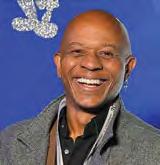
sense that we wanted something that was emblematic of the spirit of Lagos,” says Adeola.
“In addition to the sounds of Nigeria, we needed sounds and music that people are familiar with in other parts of the world. This is also a futuristic show as well, so we need elements of sci-fi and high tech in the score. And lastly, although this is meant to be a love letter to Lagos, it’s important that this story is universal in its ability to be enjoyed. There are some things that you listen to in our series that might remind you of things like The Avengers or science-fiction movies.”
Adeola says the score is kind of a blend of these different elements. “To be honest, I loved the composition process,” he says. “Between the composition and the animation, I’m not sure which was my favorite part, because I think music carries so much emotion and gives such a sense of place. When you go to the studio and you see a full orchestra playing all of these different songs with all these different themes with the show in the backdrop, it really pulls on your heartstrings. We want the audience to feel those emotions when they see the animation and hear the music. Our story is set in Lagos, but the theme of the innocence of our protagonist against harsher realities is universal.” ◆
All six episodes of Iwájú premiered on Disney+ on Feb. 28.
DreamWorks’ Megamind was always ahead of its time, but now he’s back with a new movie and series on Peacock.
- By Jeff Spry -
Due to some apparent temporal anomaly or gross miscalculation of the calendar, it seems that it’s already been 14 long years since a certain blue-skinned, bulbous-head alien baddie tried to dominate citizens of Metro City in DreamWorks Animation’s Megamind. Time does indeed fly!
With a voice cast that included funnyman Will Ferrell as the titular villain, Brad Pitt as the celebrated crusader Metro Man and Tina Fey voicing spunky reporter Roxanne Ritchi, this charming 2010 animated movie invaded theaters during the glory days of our planet’s insatiable appetite for superhero fare and collected a tidy $321 million by the time its theatrical run concluded.
Fans have clamored for a sequel for more than a decade, and now their prayers have been answered thanks to this month’s Megamind vs. the Doom Syndicate. It’s a fresh feature film written by the original movie’s screenwriters that arrives as a springboard event to Megamind Rules!, an eight-episode companion series also arriving on Peacock.
Penned by Alan Schoolcraft and Brent Simons and directed by Eric Fogel of MTV’s Celebrity Deathmatch, Megamind vs. the Doom Syndicate
picks up three days after the first movie’s plot with Megamind trying to fulfill his role of benevolent hero and cosmopolitan protector after Metro Man’s retirement. Chaos erupts when a collective of former henchmen arrives to carry out a diabolical plan to blast Metro City to the Moon.
Vocal duties fall upon the likes of Keith Ferguson (Megamind), Laura Post (Roxanne Ritchi), Josh Brener (Ol’ Chum), Maya Aoki Tuttle (Keiko Morita), Emily Tuñon (Lady Doppler), Talon Warburton (Lord Nighty-Knight), Scott Adsit (Pierre Pressure), Chris Sullivan (Behemoth), Tony Hale (Mel/Mr. Donut), Jeanine Mason (Christino Christo) and Adam Lambert (Machiavillain).
Director Eric Fogel’s funny bone is in full effect here, and as the mirthful maestro behind MTV’s Celebrity Deathmatch claymation shorts, he layers the film with equal amounts of pathos and punchlines. He not only helmed the new sequel but also oversaw the Megamind Rules! writers.
“I always felt that Megamind was an underappreciated little gem out of DreamWorks Animation. I saw so much potential,” Fogel recalls. “There’s such a love for that character that you have so much to gain by diving back in. Knowing that Brent and Alan, the original creators, were going to be involved — that got me all fired up. When do we start? Let’s make this thing!”
“He comes off very pompous at times, but
there’s something very vulnerable at the core of Megamind,” notes Fogel. “When the original film came out, it was almost ahead of its time in the way it was poking fun at the superhero genre. Now it’s interesting to look at what we’ve done here in the wake of the cooling off of the Marvel Cinematic Universe. Superhero movies don’t feel quite as popular as they [once] were, so bringing him back now feels like a really interesting time to re-explore that genre.”
While referencing the first feature, Fogel and his talented posse examined the original models and designs, which still looked beautiful, then rebuilt them working off those early concepts and frameworks. With technology evolving so much, it became necessary to retexture everything.
“Then it was a matter of figuring out how do we get this thing to feel cinematic and have an epic scope within a TV pipeline,” says Fogel. “That was a huge puzzle and a huge challenge to piece it all together. The movie was produced within the episodic pipeline, so we had to approach it almost as a bunch of mini-episodes knowing how we were going to string it together to make the movie. 88 Pictures did the actual animation, and the design through animatics was done with a partner studio up in Vancouver named Doberman Pictures. A large percentage of the production was outsourced for this, and

'When the original film came out, it was almost ahead of its time in the way it was poking fun at the superhero genre.'
— Director Eric Fogel
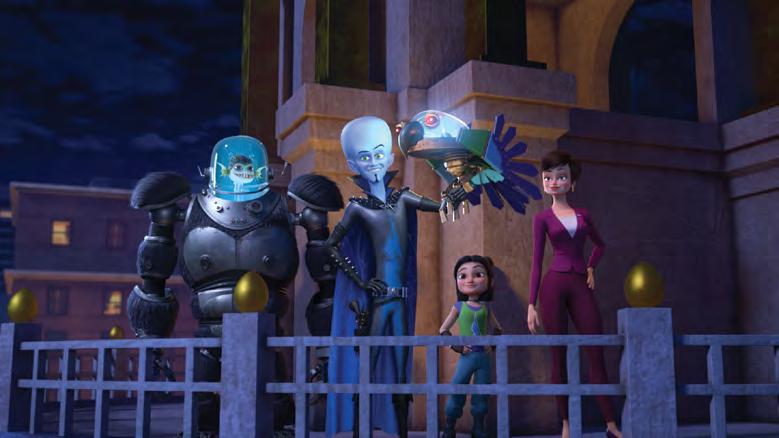
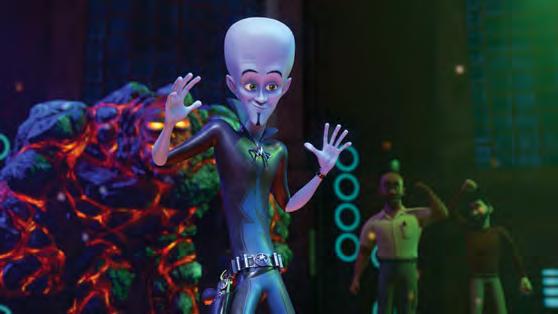
we worked closely with the teams. It all worked really well.”
Since bringing back Will Ferrell to reprise his role as Megamind was not an option due to budgetary issues and scheduling, Fogel was fortunate to have an incredible wealth of vocal talent at his disposal.
“Keith Ferguson, who I believe was Will Ferrell-approved as a voice double, brings so many new layers to that Megamind character,” Fogel says. “He’s such a joy to work with and incredible with improv and gives you everything you need every single time. Laura Post, playing Roxanne Ritchi and replacing Tina Fey — I’d challenge you to even recognize the difference."
“I’m honored that DreamWorks trusted me with this property and there was a lot of ner-
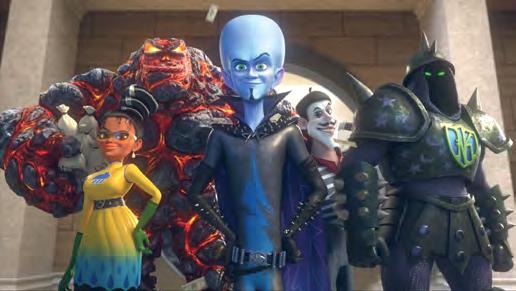
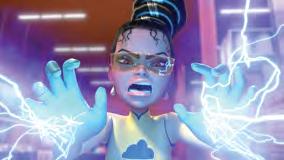
THE MAYOR OF METRO CITY: First introduced in the Tom McGrath-directed 2010 feature, Megamind is back in a new feature (Megamind vs. The Doom Syndicate) and series (Megamind Rules!) on Peacock this month. In the movie, Megamind must re-assemble his friends to stop his former evil team from sending Metro City to the Moon.

vousness and anticipation,” says the veteran director. “Seeing those first fully-rendered shots coming in after you go through all the stages of animation, it’s like going from black-and-white to full color. That’s when you can really see and know if the thing is working. It was such a relief when we saw those final shots and it was gorgeous and it looks like the original, and we knew we’d accomplished the mission.”
To retain the style and wit of the original, DreamWorks Animation retrieved original scribes Schoolcraft and Simons, who plunged straight into that epic supervillain world with unbridled optimism.
“We always have a Megamind mindset,” Schoolcraft tells Animation Magazine. “He’s sort of a cross between Brent and I, so the mentality is
easy to bring back up. We wrote the original spec script in 2003, but it didn’t sell. DreamWorks ended up buying it at the beginning of 2007.”
These creative partners both had day jobs and were struggling as writers at a time when the internet was a novelty and they were fortunate enough to have unlimited telephone minutes.
“Alan was in New York working for the Coen Brothers as their assistant,” adds Simons. “I was in Los Angeles temping, and we wrote together at night over the phone. It ended up getting us representation and jobs, but that was really the most we thought we could hope for. The script had a lot of fans around town, but we were still struggling. Then we got this call that the script sold at DreamWorks and they were going to make it, and we thought it was a prank.”
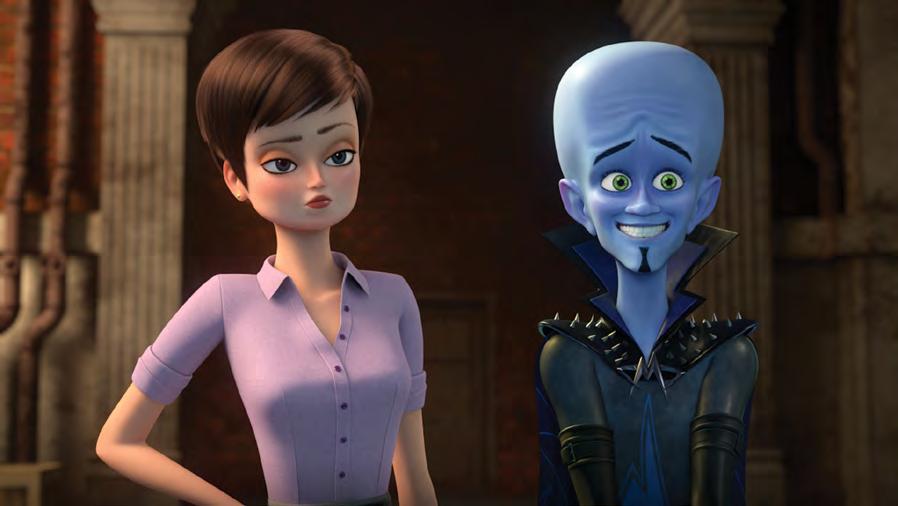

Megamind is a throwback to a very different place and time in modern society, before social media triggered everyone’s hypercritical nature about entertainment offerings and the world seemed far less polarizing. Keeping the character pure was actually quite easy for the writers.
“He’s always been innocent in a way, even though he’s a villain,” notes Schoolcraft. “He’s unaware of the world and all our prejudices. There’s a childlike innocence to him that’s going to be in the sequel and the series. He hasn’t had to deal with emotions his whole life and now he’s trying to be a real person. It’s like a minefield for him, but he does it in a positive way because he’s really excited to be like everyone else. I think that worked back then and it’s refreshing now to not have a cynical main character.”
Animation technology and tools have advanced greatly since Megamind first hit the silver screen and it was essential that the production offered fans an authentic sense of continuity.


“We had the movie to work off of and Tom McGrath, the genius director of the original film [who went on to direct the blockbuster Boss Baby movies] created such a colorful world, so we had a great starting point for everybody,” Simons explains. “When it came to designing new characters, we did our best to go off that. The Canadian team at Doberman, who did designs for new characters and updating of existing ones, did a great job.”
Schoolcraft was inspired by DreamWorks’ reputation as a fertile environment to deliver organic storytelling, engaging visuals and internal momentum for its star slate of animated projects.
“You have to have great characters to make a story,” says Schoolcraft. “DreamWorks has such a great team of artists. Making a movie is a collaborative effort. You put something on the page, but that doesn’t mean anything until you see it on boards, then you see an animatic, then you
see previs and then you can constantly make adjustments. Starting from the character, you pick the journey that best fits this person. It starts small, and then it’s just building out the world.
“Just having Megamind back in our lives was amazing,” he continues. “When you start writing again you realize how much you missed him. It’s so good that he gets a second life again.”
In refining their collaboration between the writing team and the artists, there’s admittedly a “creative dueling banjos” where the crew works to craft something that looks better and better. “Especially when you have a great director at the head of the operation like Tom McGrath or Eric Fogel,” admits Simons. “That’s what we’ve fallen in love with in animation. It’s magical to write something and have a brilliant artist sketch it and put it on a screen the day you wrote it.” ◆
'Megamind has always been innocent in a way, even though he’s a villain … There’s a childlike innocence to him that’s going to be in the sequel and the series.'
— Writer Alan Schoolcraft

The team behind the new Netflix series Bad Dinosaurs take us behind the scenes of the hilarious family show.
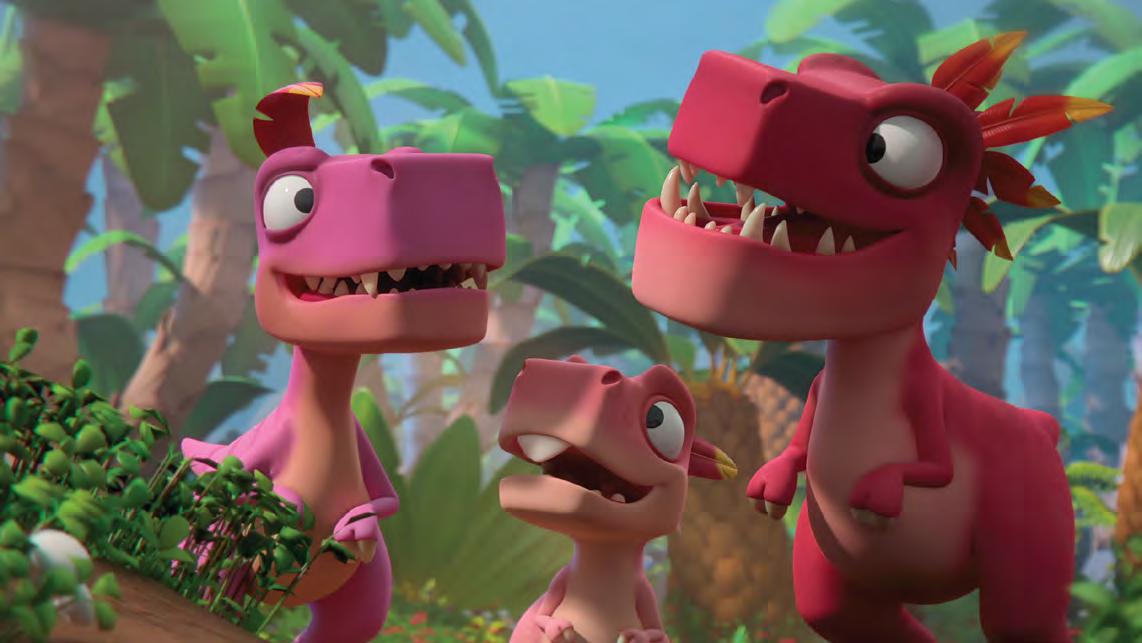
Like many great creative minds, Bad Dinosaurs showrunner and co-creator Joel Veitch (Uncle Wormsley’s Christmas) got the idea for his new animated series while chatting with his friend and collaborator David Shute in a pub. “It was way back in 2014, and we were talking about how the word ‘dinosaur’ translates from Latin as ‘terrible lizard,’” Veitch recalls in an email interview “I felt it would be funny to make some dinosaurs who were ‘terrible’ as in ‘not very good at dinosauring,’ rather than ‘terrible’ as in ‘terrifying and mighty.’ We were then able to flesh out the idea over the course of four shorts with the help of CG Swiss Army knife Alex Mallinson and composer Jamie Robertson, who helped put meat on the prehistoric bones of the idea!”
Produced by Dan Dixon and Paul Schleicher, the new show is the debut animated project from London-based Snafu Pictures and is described as “a high-octane thrill ride through the Mesozoic that follows the hilarious she-
nanigans of a Tyrannosaurus family as they deal with life in the prehistoric wilderness while surrounded by incompetent dinosaurs.” Based on a series of popular online shorts, the show is directed by BAFTA-nominated animation veteran Simone Giampaolo (Only a Child).
From the Napkin to the Screen
Veitch says the mockumentary format was perfect for the initial series of online shorts. “Our narrator had all the wonder and gravitas of Attenborough,” he explains. “This format worked brilliantly for the shorts, but as we adapted it for the series we found that we had the time and space to allow the characters to create deep emotional connections and spend time fooling around, acting stupid. Our characters were able to become more multidimensional, which was very cool.”
The showrunner adds, “It took us 10 years to get it from the back of a napkin to the screen. I created the original shorts with Dave Shute and Alex Mallinson shortly after, and I took
one of the shorts around the festival circuit, with international trips funded by the wonderful British Council Shorts Support Scheme, and while having a delightful time at the excellent São Paulo International Short Film Festival, I met Dan Dixon.”
Dixon says, “There is a great tradition of short, animated storytelling, fueled by anarchic stories full of laughs as well as pathos; and we like to think of Bad Dinosaurs as being part of the lineage. We were fortunate to work with our head writer, Natt Tapley, who had a real affection for this classic medium. He really led the charge on shaping this for our show.”
“Dan and I don’t have a background in kids’ TV, as we have always worked in high-end animation and VFX for games, films and TV,” says Schleicher. “We initially contacted Netflix through their adult animation commissioning exec Julio Bonet. After our initial pitch we were quite quickly asked to undergo a round of funded development, which really helped us to interrogate and find the edges of the

'Our journey with Bad Dinosaurs has taught me that a brilliant idea will eventually find a home, even if it takes a great deal of pushing, heartache and time to get there.'— Showrunner and co-creator Joel Veitch
show we wanted to make, before being greenlit at the start of 2022.”
The show’s animation is handled by Madrid-based Able & Baker. “We built a fantastic team to handle the writing, storyboarding and editing,” says Dixon. “This was vital in allowing us to hand over clearly defined structure to the animation team, and all of these elements were pulled together by the exceptionally talented director, Simone Giampaolo.”
“Able & Baker had produced an episode of Love, Death + Robots called The Dump and we were really impressed with the fidelity of animation they were producing,” says Schleicher. “In particular, as a smaller independent studio, we were convinced that they would be as committed to delivering a great show as we were. And we were proven right; founders Carlos Tschuschke, Ramón Giráldez and their team were fully committed to bringing fantastic talent to the project.”
Veitch believes that the T. rex family are the true heart of the show. “Despite the fact that they are dinosaurs, predatory beasts who do not use language, we have made them a real family with real feelings and a relatable family dynamic,” he explains. “We put a huge amount of thought into making sure that viewers would care about these lovable fools. I have three kids myself, and my years of parenting have gone into this prehistoric tale, along with the joys and frustrations of the
other writers. I hope parents will recognize themselves in these stories, and kids should recognize themselves as well!”
For Dixon, one of the great challenges was the balance of simple and complex storytelling. “Our writing team worked tirelessly to craft an arching story about a slightly dysfunctional family who lose their home, before becoming a fully functioning, although unconventional, unit,” says the producer. “At the same time, each episode needed to have its own beginning, middle and end as well as a clear point of view (lead character). I am very proud of how the writing team worked to craft this delicate balance.”
Schleicher adds, “I would also add my love for the craft and design on the show. I feel like the team really nailed the character design, which is fused by underlying principles of silly, simple shapes and colors, but is [also] built on top of with beautiful texturing and lighting. The world-building is also impressive, and the art direction has been a joy to see being brought to life.”
Veitch believes that although the animation landscape is a crowded market, young viewers are hungry for shows that have great characters that make them laugh. “Like many shows, Bad Dinosaurs looks and sounds great, the design and characters are immediately appealing, and the comedy and journey are engaging,” he says. “But this show’s superpow-

er is the unique vision of the team behind it. We have been incredibly lucky in this process to work with a group of intimidatingly brilliant people who have been focused on helping this show to blossom.”
After all is said and done, Veitch hopes that audiences will tune in and enjoy silly dinosaurs that will make them laugh. “However, once they are pulled in, I want them to become emotionally invested in our characters and join them in their roller coaster journey through the land of Bad Dinosaurs, rooting for them all the way and feeling powerful emotions,” Veitch adds. “I want them to be surprised at every turn; this is not a show that you can easily predict. Most of all, I want them to love our dino-children, who we have expended so very much of our souls to bring into the world!”
He concludes, “We all know that there are serious challenges facing the industry in 2024, and this is a hard time to try and get a completely new show idea away. But our journey with Bad Dinosaurs has taught me that a brilliant idea will eventually find a home, even if it takes a great deal of pushing, heartache and time to get there.” ◆
Bad Dinosaurs premieres on Netflix on March 28.
PREHISTORIC PERFECTION: Bad Dinosaurs is based on a series of original online shorts co-created by show-runner Joel Veitch and Dan Shute. The animation is produced by Able & Baker.


The neurodiverse artists at Brainstorm Productions prepare a special animated anthology.
For the past few years, Torrance, Calif.-based CLU Transitions program has trained talented artists and animators on the autism spectrum to engage as 21st century working professionals. The artists at the program’s companion studio Brainstorm Productions have been working on an animated project titled Dreams Anthology which is slated to debut on the studio’s YouTube Channel in April. We chatted with the project’s consulting producer, animation veteran Bob Harper (co-creator of Prank Boy and animator on Foster’s Home for Imaginary Friends, Lalaloopsy, among others) who gave us a better understanding of this special anthology.
Can you tell us a bit about the Dreams Anthology project and how it all came to be?
Bob Harper: The Dreams Anthology grew from observing the animators at Brainstorm Studio display their passion and excitement to work in animation, which was their dream. They all have a voice that is often overlooked in the industry and have stories to tell which often never get heard. This is their opportunity to share with the world what is on their minds.
When was it launched and how many people are working on it?
We began the initiative in November after the studio finished wrapping up the music video project Purple for singer/songwriter Tim Myers, which premiered at the San Pedro Independent Film Festival. Building on the confidence for a job well done, we decided that the next big project should be more personal and reflective of the studio. There are presently 16 animators who are working on the anthology.
What was the criteria and goals of this project? Each animator was given the prompt of what dreams meant to them. They were then tasked to create a short, based on their interpenetration of the theme. They were given creative freedom with the only direction to make it G or PG rated. Toon Boom Storyboard Pro was used for boarding and animatics, while Adobe Creative suite was used for animation and post.
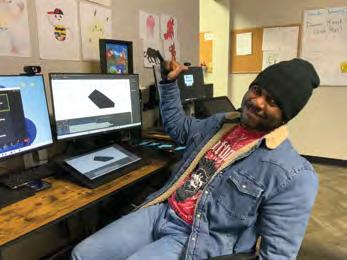
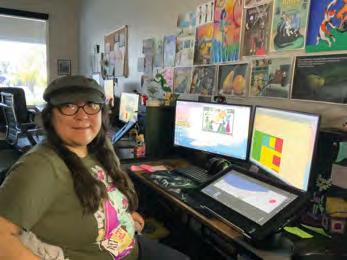


SELECTED SHORTS: The new Dreams Anthology is a collection of animated projects created by the talented neurodiverse artists at Brainstorm Productions, mentored by animation veteran Bob Harper (below left).


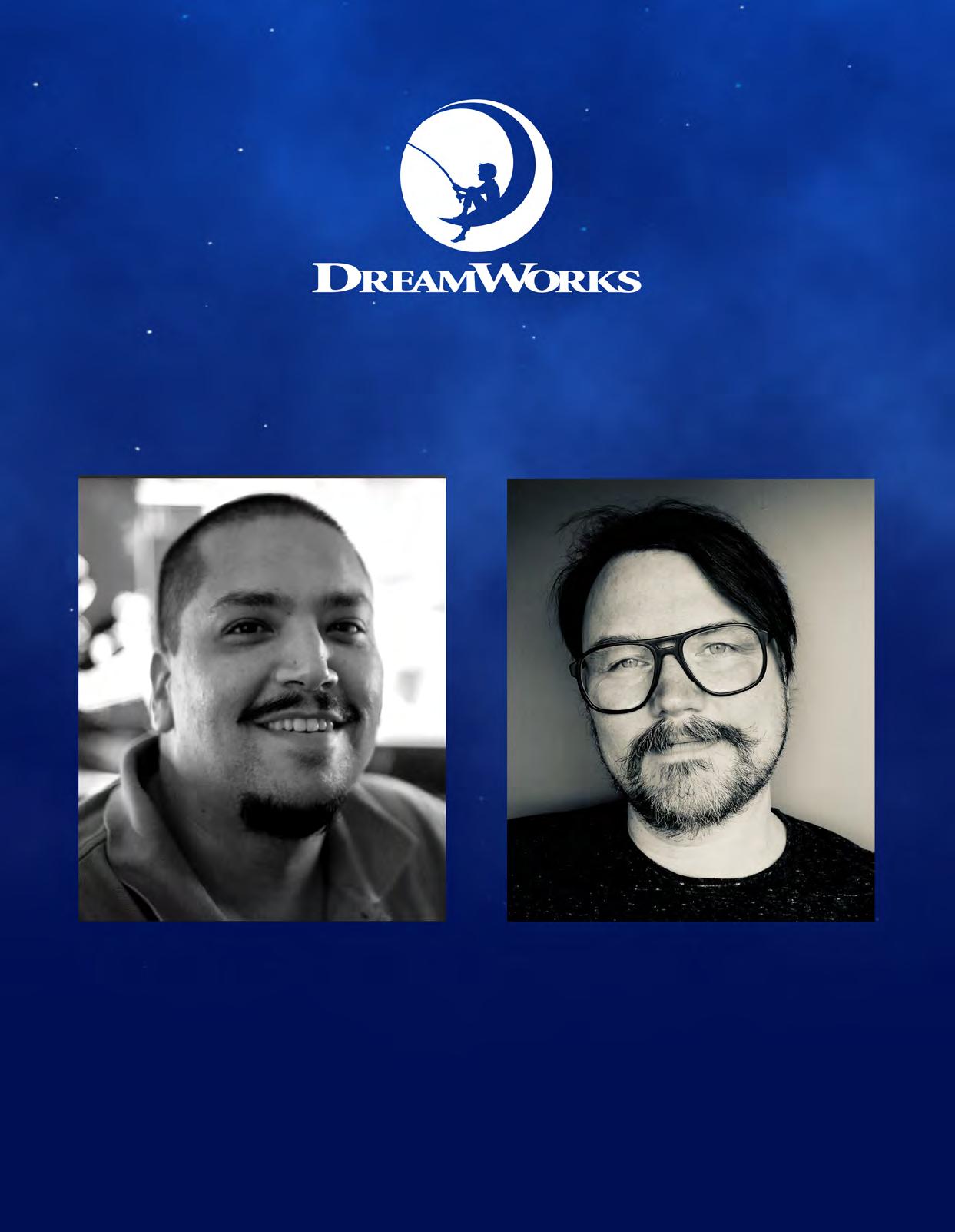


Crunchyroll’s new Cherry Magic! series preserves the charms of the manga and live-action adaptations.
- By Charles Solomon -
A GENDER - BENDING GENRE: Satelight’s Cherry Magic! is a faithful animated adaptation of the 2018 popular manga by Yuu Toyota, which has also been turned into a popular live-action TV series and feature.
The new anime series Cherry Magic! Thirty Years of Virginity Can Make You a Wizard?! (2024, streaming on Crunchyroll) offers insights into the curious and increasingly popular genre of BL or Boys’ Love. These stories depict wistful and sometimes comic romances between attractive young men — but they’re written by women for predominantly female audiences.
Gender-bending entertainment has been part of Japanese popular culture for centuries. In Kabuki, male actors known as onnagata specialize in female roles. During the Edo era, the reigning courtesans and geishas would study their performances to learn how a woman of refinement should comport herself. The hugely popular Takarazuka Revue, which mounts elaborate musical spectacles with young women playing all the parts, was an influence on Osamu Tezuka’s work. The women who portray the heroes have huge followings among teenage girls.
BL originated in Japan in the late ’70s in doujinshi (fan comics), but soon spread to manga, anime and live action. Today, manga and graphic novels with BL themes are being written and sold all over the world, and studios in Japan, South Korea, Taiwan and Thailand are producing

BL series and features. Heartstopper, a British series based on Alice Oseman’s graphic novel, and the feature film Red, White & Royal Blue (available on Netflix and Prime Video, respectively) are among the most recent Western entries in the genre.
Yuu Toyota scored a big hit in 2018 with her Cherry Magic! manga (published in English by Square Enix Manga), which has already been made into a popular live-action TV series (2020) and a feature (2022). At the center of Cherry Magic! is an urban legend that anyone who’s still a virgin on their 30th birthday acquires the magical power to hear the thoughts of whomever they touch. To his considerable chagrin, salaryman and self-described loser Kiyoshi Adachi discovers it’s true.
Although he’s kindhearted, hardworking and helpful, Adachi has never been on a date. The only person who sends him chocolate on Valentine’s Day is his mother. One morning in the elevator, Adachi gets shoved up against Yuichi Kurosawa — and is gobsmacked to discover that the handsome ace of his company’s sales department has a crush on him. Kurosawa is the embodiment of kakkoii (cool, stylish, suave). He wins awards every year; bosses and women adore him; and his desk is buried in chocolate on Feb. 14.
Adachi and Kurosawa exemplify the mismatched pairs at the heart of many BL manga and their adaptations. In I Cannot Reach You (Netflix), handsome A-student Yamato Ohara receives confessions of love from the prettiest girls in his high school and offers from modeling agencies, but he adores his untidy classmate Kakeru Ashiya, who must take makeup exams and sees himself as someone “with nothing to offer.” Melodramatic nerd Aoki and handsome, sensible Ida pursue a maladroit courtship in My Love Mix-Up! (Viki). But despite complications, crises and contretemps, the heroes always end up together.
It’s interesting to compare the new animated series of Cherry Magic! produced by Satelight with the earlier live-action version. The anime
“The anime series is a literal adaptation of the manga. Every flirtation and mishap between Adachi and Kurosawa are there, and the artists faithfully reproduce Toyota’s drawing style.”
series is a literal adaptation of the manga. Every flirtation and mishap between Adachi and Kurosawa are there, and the artists faithfully reproduce Toyota’s drawing style. Ironically, the program’s careful adherence to the original manga is its greatest weakness.
Like many serials, from One Piece to Pinocchio, Cherry Magic! sometimes rambles — and so does the animated program. The writers of the live-action series trimmed and shaped Toyota’s narrative, strengthening the drama and the comedy.
The animated series begins shortly after Adachi’s 30th birthday, so the weird magical power is already part of his world. Kurosawa’s crush is news to him, but he’s already coping with his telepathic talent. The live-action series opens the day before Adachi’s 30th birthday. The next day, he wakes up in his tiny apartment (“Goodbye, 20s. Hello, 30s.”) and on his way to work dis-

covers his new ability — so the audience sees the character’s reactions.
The animators also had to deal with the limits of Toyota’s drawings. Her Adachi and Kurosawa are standard-issue manga types. Adachi’s hair hangs over one eye; Kurosawa is taller with bland, regular features. The extremely limited
projects?
CONTINUED FROM PAGE 30
Why do you think this project is an important venture and we need to have more ventures like this happening?
In this age of inclusion, one population that still has very little representation is the neurodiverse population. More often than not, if these artists are offered any opportunity in the industry, it is usually in a support role. We know these animators can write, direct and produce their own stories and they deserve a platform to be seen and heard.
How is it different from other similar types of
We are delivering nine unique shorts, each written and directed by a neurodiverse animator who also supervised the production with their fellow animators as well as neurotypical staff members who served as support. Ultimately they all learned teamwork and leadership skills and truly finding their creative voices.
What was your biggest challenge?
Scheduling was our biggest challenge, as each animator works at a different pace and many of them are discovering their limitations as well as what they excel at.
What are you proudest of?
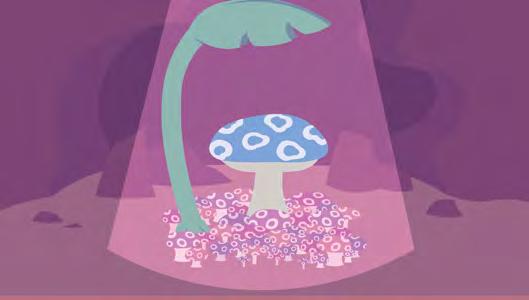
animation doesn’t allow the artists to use much in the way of expressions, gestures or body language to bring their characters to life. All the acting falls on voice artists Chiaki Kobayashi (Adachi) and Ryota Suzuki (Kurosawa), whose performances are adequate, but not extraordinary.
There’s no tradition comparable to BL in America or Europe. An increasing number of gay-themed graphic novels in the U.S. are being created by LGBTQ+ artists. But the growing popularity of Cherry Magic!, I Cannot Reach You, My Love Mix-Up! and other BL manga, and the animated and live-action series based on them, shows there’s an enthusiastic audience for these stories in the West. ◆
Satelight’s Cherry Magic! Thirty Years of Virginity Can Make You a Wizard?! is currently streaming on Crunchyroll.
I love seeing the passion they all put into their art. Seeing them flourish and grow not only as artists but as young adults who are becoming more confident in their abilities, but more importantly confident as people, is truly awe-inspiring.
How do you plan for the public to view this anthology?
We will be debuting them on our YouTube channel throughout the month of April to celebrate Autism Awareness/Acceptance month and then we hope to submit the collection to meaningful festivals afterwards. ◆
For more info, visit brainstormproductions.org.

Every year, we put together our hot list of up-and-coming animation artists whose careers are on fire. Whether they’re directors, storyboard artists, showrunners, production designers or writers, these brilliant creatives know a thing or two about using their immense talents to deliver amazing work that captures our imagination and elevates the art form. We hope you enjoy getting to know this fantastic group as they make their mark on the global animation scene.

Writer, Director, The Spider Within: A Spider-Verse Story (Sony Pictures Animation) Age, Birthplace: 33; Mansfield, OH
I knew I wanted to have a career in animation when: I was around 12 years old, and my mom took me to the movies. She bought some tickets for a kids’ movie, but we decided to sneak into Kill Bill The animated scene about O-Ren Ishii was playing when we sat down, and it blew my mind. The rest is history!
What I love about my current project: Right now, I’m developing my own project at SPA. It’s a dream come true and there’s plenty of work to be done. There is nothing better than working on something you completely believe in and wielding all of your passions to accomplish it.
Toughest challenge: To do this work is a privilege and honor. It can also take an enormous toll on your mental health. It’s tough but important that I remember to honor myself as a hardworking person doing my best — a person worthy of rest, free time, happiness and fun! I want everyone reading this to feel that.
Favorite animated movie or TV show growing up: I was raised on Toonami after school; that was everything for me. American animation was big, but that wave of dynamic/dramatic animation from overseas made me realize what was possible.
Best advice: People will spend your entire life trying to beat that part of you out that wants to do something true to you. There will also be supportive, helpful people around you that understand what you’re trying to do. Ponder the actions of the former but listen more to the latter. Work on your weaknesses, of course, but don’t forget to double down on your strengths. When you focus on your strengths, it tends to make you stand out.

Future plans: I plan to introduce more genre filmmaking and mature stories into the animated space. I just think there’s plenty of room for it. The success of large, animated movies can’t be ignored anymore. I love animation; I know other adults do as well. I’d like to make movies for them.
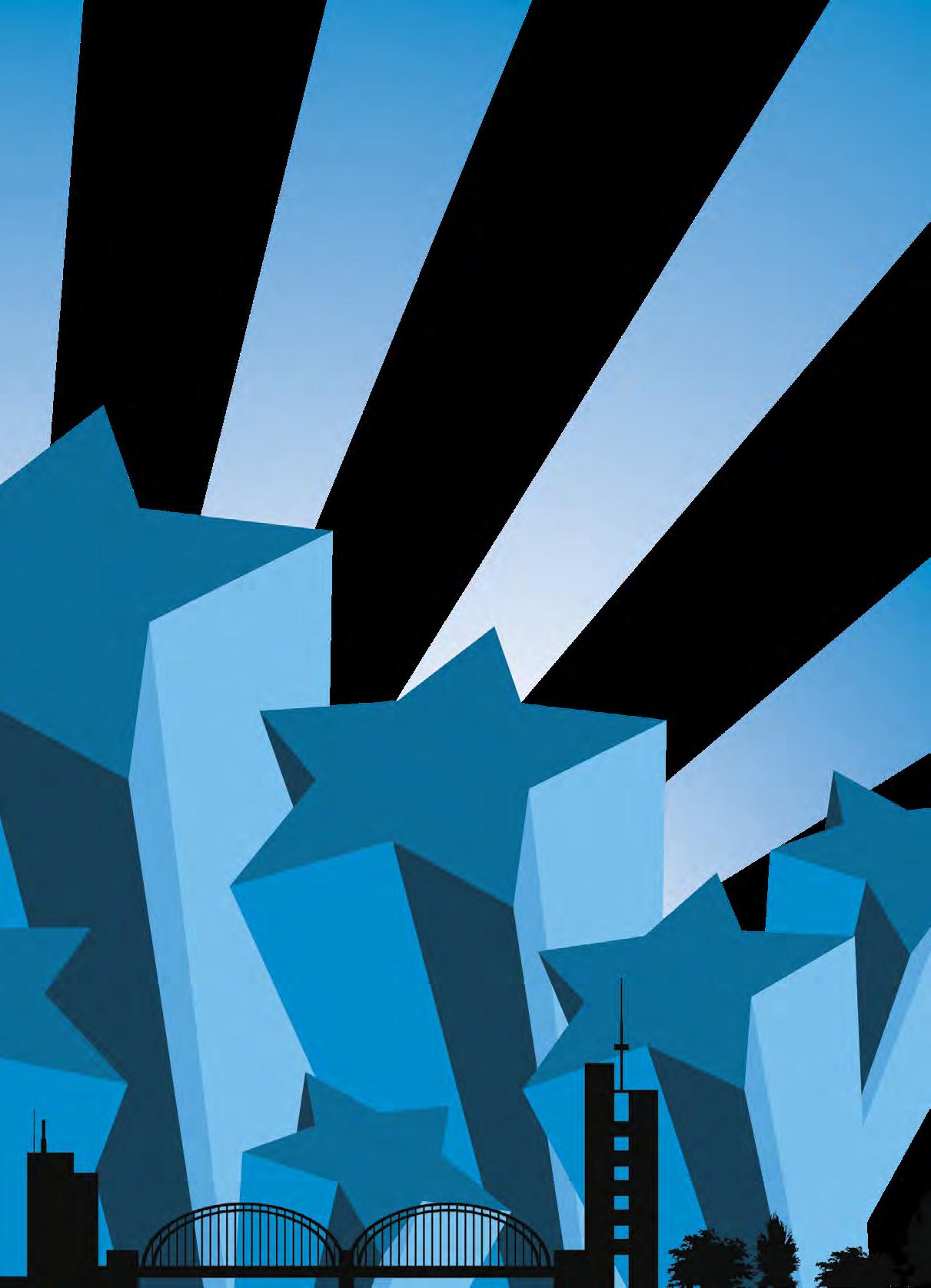
Creator, Showrunner, Writer, The Second Best Hospital in the Galaxy (Prime Video)
Age, Birthplace: 38; San Francisco
School: UC Santa Cruz
First job in animation: I was a child actor in the movie James and the Giant Peach. I had one very important speaking line: “Officer, there’s a boy up there!”
What I love about my current project: I love that we try to interweave fun absurdity with heartfelt emotion. And that everything eats everything else.
Toughest challenge: Days are not long enough to get everything done, so we often have to let things go before we’re ready, which maybe is a good practice for life.
Fave animated movie or TV show growing up: Of course, I loved the classics like Aladdin and The Little Mermaid and anything by Pixar. The weirder ones that I loved were The Point and The Nightmare Before Christmas, and they haunt me to this day.
Role model: I loved Don Hertzfeldt’s short film, World of Tomorrow. Also, Julia Pott voices its main character Emily Prime, and she is my best friend and another animation role model of mine, so it’s a two for one.
Best advice: Sleep and exercise and eat more vegetables. And then tell me how to do those things! Future plans: I would love to hide in a cabin for a while and write, if you know of any cabins.

Art Director, Ariel (Disney Junior)
Age, Birthplace: 35; Sacramento, CA
School: Savannah College of Art and Design
I knew I wanted to have a career in animation when: I always knew that I loved drawing, but I didn’t necessarily make the connection that animation was something one could pursue as a career. I don’t think I ever really considered who was behind the cartoons I was so eager to watch after school or the amount of effort that went into making these series possible. Animation was simply a wonderful, magical thing that I enjoyed. My parents, ever invested in my education, signed me up for a series of college courses one summer that happened to include an introduction to traditional animation. That class completely changed my life.
First job in animation: Character designer on Niko and the Sword of Light. What I love about my current project: I’ve always been a huge fan of stage plays and musicals that put their own unique spin on the source material. I am incredibly grateful that our talented crew, led by the incomparable Lynne Southerland, has an opportunity to do the same with another beloved classic. Seeing all the amazing things our creative team brings to the table week after week is truly a highlight! It feels like everyone is doing their best to make something wonderful, and that’s exciting.
Biggest challenge: Waiting for the series to premiere!
Favorit animated movie or TV show growing up: I was absolutely obsessed with Sailor Moon as a child and still am a huge fan to this day. I remember having to wake up super early in the morning to catch it on TV, since this was pre-Toonami. Probably the earliest and most consistently I’ve woken up by choice.
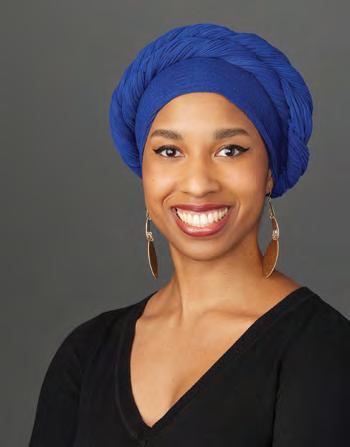
Animation role model: I consider Everett Downing Jr. to have been my unofficial mentor throughout the course of my career. I really admire his storytelling and sense of collaboration among creatives that he brings to all his projects.
Best advice: Everyone’s path breaking into and navigating the animation industry is going to be different. If working in this field is truly your dream, continue to push forward and hone your skills whenever you can. It can also be beneficial to stay open to opportunities that don’t align perfectly with your established goal. You never know where those experiences may lead you.
Future plans: To be a showrunner on an original series that I developed. That would be a dream come true!

Co-Exec
Producer/Co-StoryEditor, The Fairly OddParents: A New Wish (Nickelodeon)
Age, Birthplace: 30s; Seattle, WA
School: Howard University
I knew I wanted to have a career in animation when: I went to school for acting and my dream was (and still is) to create, write and star in my own live-action TV show. Soon after moving to Los Angeles, I started taking sketch writing and improv comedy classes, and I learned to write for myself and others. Then I started performing regularly at comedy theaters around town, and I was invited to participate in character showcases like the CBS Diversity Sketch Comedy Showcase. Performing characters led to voice acting, and voice acting led to writing in animation! Honestly, I pivoted to writing out of desperation for a stable income. I was auditioning and performing full time, and I was tired of being broke!
First job in animation: My first voice-over job was for Marvel’s Avengers
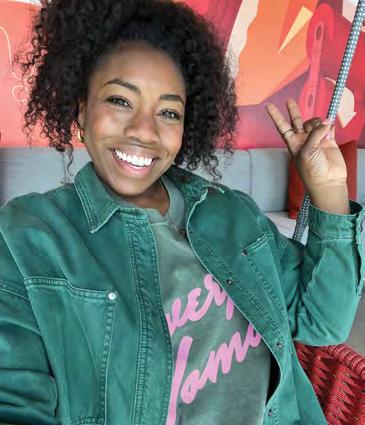
Assemble: Black Panther’s Quest voicing the character Bask, the Queen of Wakanda. Shortly after that, I booked a recurring role on a show called Craig of the Creek voicing the zany creek scientist, Wren. One day, I posted on Facebook that I was looking for writing jobs and the head writer of that show saw my post and, unbeknownst to me, pitched to bring me in. A few days later, I received an email from the show’s supervising producer, Kelly Crews, inviting me to sit in on a couple writers’ meetings and help break stories. My mind was blown … I started freelance writing for Craig of the Creek, and in January of 2020 I was offered my first full-time staff writing position. I still keep a screenshot of that email on my phone because it was such a pivotal moment in my career.
What I love about my current project: I loved creating the world, bringing the characters to life and immersing myself in the writing. I absolutely loved being behind the mic in the recording booth. I love that I get to voice a character (Hazel) that I had a hand in creating! I feel honored to give her voice and share her story! I got to take part in casting the show and I sat in on all the recordings, which was a dream come true seeing some of my favorite voice actors in action. I loved collaborating with our incredible writers, breaking stories, punching up scripts and doing revisions. I loved our design and post-production meetings and so much more.
Toughest challenge: Attempting to accomplish everything I listed above in 24 hours! The work can be overwhelming, so maintaining a healthy work-life balance is crucial. It’s important to carve out time to eat, stay hydrated throughout the day and take short breaks (or a nap!) when necessary. Take care of yourself so that you can take care of others and the show.
Fave animated movie or TV show growing up: My favorite animated movie was The Lion King; I know that soundtrack by heart. For TV shows, I watched a lot of Looney Tunes, Muppet Babies, The Flintstones, The Jetsons, DuckTales, Scooby-Doo, Bobby’s World, Rugrats, The Ren & Stimpy Show and The Pink Panther Show. Oh, and Tiny Toon Adventures!
Role model: Cree Summer; she’s such a legend, and I admire her so much as an actress, a voice talent, a Black woman in animation and as a mama! I just love her free spirit and can only hope to have a career as long and full and as storied as hers.
Best advice: Keep going! Don’t worry so much about “breaking in.” Instead, concentrate on honing your craft and keep finding ways to grow personally and as a creative. Take classes, sign up for workshops, refine your unique voice and lean into you
Embrace your individuality! Embrace the joy in creating and sharing your art with the world!
Future plans: I want to be the Shonda Rhimes of animation, so I guess I’ll just keep making shows?!

Lighting and Compositing Supervisor, Jurassic World: Chaos Theory (DreamWorks TV)
Age, Birthplace: 45; Danville, VA
School: Full Sail University
I knew I wanted to have a career in animation when: It’s more of the first time I knew I could. I always enjoyed creating growing up, but never considered it as a career option. My brother-in-law worked in animation and thankfully encouraged me to pursue it.
First job in animation: My first job in animation was as a lighting artist on Robot and Monster at Nickelodeon Animation Studio.
What I love about my current project: I love that I get to work with incredibly talented and passionate people for Jurassic World: Chaos Theory. They are all making the most of this moment and care a great deal about this story and the team.
Toughest challenge: One of the biggest challenges is meeting my own expectations. Our goal is to create a show that looks cinematic and lives up to the Jurassic World franchise, and it’s always a fun challenge to stretch ourselves and make sure we deliver it on time and on budget.
Fave animated movie or TV show growing up: Some of my favorite animated TV shows and movies growing up were Hanna-Barbera and Looney Tunes cartoons, The Secret of NIMH, The Ren & Stimpy Show and He-Man and the Masters of the Universe
Role model: I was fortunate enough to work with Joel Fajnor as my art director during my time on
The Croods: Family Tree. Joel is a talented artist, gracious, kind and selfless leader. He has had a long, successful career and is respected by all who know him. He is definitely someone I try to model myself after.

Best advice: Stay organized. Keep a notebook and write down your ideas in one place; Learn and practice empathy; Most of all, never be afraid to not know something. Ask for help. People love to teach and share ideas. It will strengthen bonds/build relationships and trust. Future plans: I plan to continue growing in this role, and finding new and inventive ways to help people tell stories. I want to ensure I am creating environments that value respect and trust.
Lead Character Designer, That Christmas (Locksmith, Netflix) Age, Birthplace: 45; Leverkusen, Germany
School: Lycée technique des Arts et Métiers, Luxembourg
I knew I wanted to have a career in animation when: I’ve been into drawing and animation since forever. In third grade, I wrote in my friendship book “trickfilmzeichner (animator)” as my future ambition. Though my goals took a few twists as I grew up, I am fortunate that they eventually circled back to animation.
First job in animation: My animation journey started as a background dancer in an Advocaat commercial. Before attending animation school, I secured a summer internship at a small studio, contributing to a quirky commercial featuring an animated little chicken against live-action footage of silhouetted party people in 1998, sipping Advocaat. While gaining my first animation experience with small in-between work on the chicken, I earned my first paycheck in the animation world — through dancing.
What I love about my current project: That Christmas is a beautiful, funny film with a lot of heart, and I couldn’t be prouder and more grateful to be a part of it. What began as a three-week commitment for early character designs evolved into a rewarding three-year journey with Locksmith Animation, where I had the privilege of shepherding my characters through every stage of the process. Collaborating with Leo Sanchez Barbosa and his team, who skillfully translated my design ideas into CG, was a fantastic experience. The most profound experience was the invaluable time spent observing director Simon Otto at work.
Toughest challenge: Disconnecting from work thoughts on the actual Christmas days.

Fave animated movie or TV show growing up: Disney’s The Rescuers and Robin Hood. When I was a kid, these films weren’t available on home video. Somehow, my godfather managed to snatch copies for me, and I practically wore out those VHS tapes with all the rewinding and replaying. Role model: I don’t have a specific role model in animation. As Stephen Sondheim beautifully expressed in Sunday in the Park with George: “Anything you do, let it come from you. Then it will be new. Give us more to see…”
Best advice: Dedicate yourself to the craft of animation. Work hard, seek out learning opportunities, and always strive to improve your skills. In character work, be it design, storyboard or animation, go beyond the technical aspects.
Future plans: Continuing my journey as a character designer because I absolutely love this job!

Director, Grimsburg (FOX/Bento Box)
Age, Birthplace: 36, born in Mission Hills, Calif. and lived in L.A. county his entire life.
School: I attended the animation program at Cal State Northridge, but left before graduating to start working as a storyboard revisionist at Film Roman.
First time I knew I wanted to have a career in animation: The first job I can remember wanting to have, was to create my own cartoon show. My aunt, Cindy Woodburn, was a producer on animated features like Who Framed Roger Rabbit and Fievel Goes West, so even at four, I knew it was possible. I decided to start my own comic-book company like Stan Lee, so for the next 12 years I devoted myself to comic books, creating my own stable of heroes and my own unique art style.
First job in animation: I was in the intern program at Film Roman for a show called Dan Vs., which aired on the now defunct network The Hub.
What I love about my current job: The genre I love more than any other is film noir. My pantheon is filled with names like David Lynch, Billy Wilder, the Coen brothers and of course, Quentin Tarantino. Now I find myself on Grimsburg, a show that not only talks the talk, but walks the walk with its hard-boiled detective aspirations. The producers and particularly our showrunner Chadd Gindin encourage us to reference detective cinema as often as we reference animated sitcoms. It’s a wonderful balancing act.
Biggest challenge: Finding ways to accomplish our artistic aspirations with the unique constraints of animation. How many backgrounds we can afford directly affects the style of the show. It›s more beneficial to choreograph characters weaving in and out of single shots with longer takes to cut down on design budget. Older movies are the ones to look at. Billy Wilder is a master of composing long takes without sacrificing chills or laughs and is a personal touchstone when contending with the challenges of directing film noir for animation.
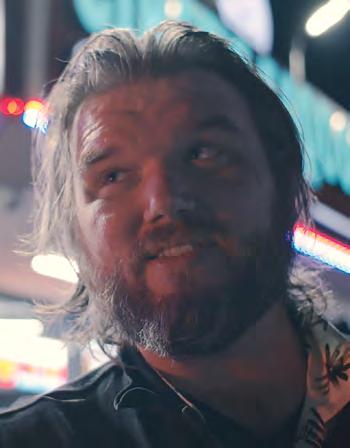
Fave animated TV show or movie growing up: Making this choice took me some time to consider. After a good long think, I realized that Batman: The Animated Series was OUR show, but Batman Beyond was MY show. At 12 I was impressed by the guts it took to create all new villains for the show instead of parading out a clown car’s worth of legacy villain pretenders. There are few creators in American animation out there who can deliver earnest emotion and visceral thrills like Bruce Timm.
Role model: Speaking of Batman Beyond, I was very tempted to put Bruce Timm on this pedestal. However, there is only one name that can rightfully sit there … or should I say two: Doc Hammer and Jackson Publick. The creators, writers and directors of the best show of all time, The Venture Bros. “Brought to you by, SMOKING!” Best advice: The best advice I can give is to make a comic book. Do everything yourself; write it, pencil, ink and color it. If you aspire to create your own show, then create the characters, too. It’s a cheap and simple way to tell a whole story yourself with visuals. It will make you think about what shots to use to tell your story and force you to draw characters repeatedly from multiple angles while acting. Making my own comics was the thing that prepared me best for being a storyboard artist and eventually a director.
Future plans: I’ve got big plans for my future, but my immediate plans are all Grimsburg! This is a great show with characters I love. More than any show I’ve ever worked on, I could see myself living in this world for a long time. I hope you will come along on the ride with me.

Art Director, Ultraman: Rising (Netflix Animation)
Age, Birthplace: 33; Seoul, South Korea
Schools: Art Center College of Design and USC
I knew I wanted to have a career in animation when: My five-year-old mind finally made the connection and exploded by the fact that actual human beings created, wrote, designed, animated and published the animated show I was watching on TV, which was one of the best and [most] influential animated shows ever created: The Ren & Stimpy Show
First job in animation: Visual development artist on a small-budget film called Rock Dog produced by Mandoo Pictures.
What I love about my current project: Beyond the art, I had the privilege of observing and learning from situations and people whom I would never have had the chance to come across. My past years on this project have matured me tremendously and delivered me out of my limited perspective about myself, people, collaboration and animation as a whole. I most likely learned what would have taken me decades to learn in the span of three [years], all thanks to the generosity and patience of the team.
Biggest challenge: Everything outside of the art. After hearing about this phrase, which many of my bosses and mentors for years have said was their biggest challenge, I only knew what it was after I got to see it myself.
Fave animated movie or TV show growing up: The Ren & Stimpy Show
Role model: Winsor McCay


Best advice: What worked for me: Ultimately, whatever we do in life from beginning to end involves people. Instead of the work constantly leading you, it should be the foundation that legitimizes you and your personality as a collaborator. Try to make opportunities to show who you are as a person to a professional, and surprise them with your solid portfolio afterward. After you’ve landed your first job, have a creative project that you own the rights to on the side. It will become the unlimited well that you’ll not only drink water out of, but it will also be plenty enough to cook, clean, share.
Future plans: I’m always looking for new things to try, learn, explore and contribute to, as I am not committed to just animation and visual development. Ideally, I’d like to create new content with new tech at a passionate startup or a small experimental project at an established studio.
Storyboard Artist, Batfamily (Warner Bros. Animation)
Age, Birthplace: 33; Paterson, NJ
I knew I wanted to have a career in animation when: Circa 2014, when my friend helped me realize I could actually do this.
First job in animation: Storyboard revisionist on Star Darlings at OddBot.
What I love about my current project: The crew is awesome. I’m working with a few friends from previous productions and a lot of new folks whose work I’ve admired for a while. It’s pretty dope. Toughest challenge: The art style is tough to get a hang of. I’m out of my comfort zone, but I’m learning a lot.
Fave animated movie or TV show growing up: Maybe an unorthodox answer, but the opening to the Sonic CD game is amazing. And I’ve probably rewatched that opening enough times to fill a movie’s runtime. My current favorite TV shows are still Futurama and Samurai Champloo Role model: Not entirely sure I have one, but I admire a lot of my peers. Shout out to my homies Jeff Trammell, Wynton Redmond, Evan Monteiro, Najja Porter, Tiffany Ford, Ben Levin and Matt Burnett!
Best advice: Watch the things you like and truly understand why you like them. Don’t watch videos telling you why things are good and bad; that’s for you to decide. When you learn that, you’ll learn your voice. That’s an important thing in this industry, I think. We’re all unique and bring something to the table. Make sure you know what you’re bringing.
Future plans: I’ve boarded and even animated for a lot of folks out here. I’m beginning to entertain the idea of doing personal shorts. Don’t hold me to it, though; I prefer lounging around.

Character Development and Animation, Inside Out 2 (Pixar)
Age, Birthplace: 34; Israel
School: Ringling College of Art and Design
I knew I wanted to work in animation when: After a few years of working at a tech company, I wanted to try something new and pursue a more fulfilling career. I went through an extensive career counseling process, where I was told I would thrive in a creative environment, especially in a visual medium. I vividly remember reading about a few Israeli animators that studied animation in Florida and were all working on different projects in some of the top animation studios. I was so inspired by their ambition and journeys that I decided to go for it and apply to Ringling. I got an answer within a couple months and moved halfway across the world to start my new life.
First job in animation: I was lucky enough to join Pixar as an intern after my junior year at Ringling, and eventually come back after graduating and starting full time.
What I love about my current project: Throughout the entire production process, the leadership teams and crew as a whole have been so committed to keeping a balanced, healthy work environment, and making sure we don’t burn out or forget to prioritize our well-being. This thoughtful approach made the whole experience so much more meaningful, especially while working on a movie that highlights the importance of talking about anxiety and dealing with complex emotions.
Toughest challenge: The biggest learning curve, for me personally, was learning to trust the process and make mistakes. Being surrounded by world-class artists, I came in with the false expectation that everyone must get it right on the first try every single time. It’s been so inspiring and humbling to see the level of trust and collaboration that goes into finding the best filmmaking choices through discussion and iteration.

Fave animated movie or TV show growing up: Toy Story, Aladdin, The Lion King, Teenage Mutant Ninja Turtles, Dexter’s Laboratory, Rocko’s Modern Life, SpongeBob SquarePants, Batman: The Animated Series, Animaniacs, 3000 Leagues in Search of Mother
Role model: One of my biggest sources of inspiration is Hayao Miyazaki. I’ve only really learned to appreciate traditional anime in my adult years, and it’s been such a pillar in how I think of filmmaking and performance. Miyazaki’s mastery of draftsmanship, cinematography and character catches me off guard every time I watch one of his films, and with each viewing I find new things I’ve never noticed before.
Best advice: One of the best pieces of advice I got in animation school was to focus on my own path. While it can be tempting to start comparing ourselves to our peers as young artists, it can also be devastating to live with the sense that we are in constant competition with each other. Instead, try to build relationships and help each other grow, and focus your goals on the industry masters whom you look up to and wish to someday work alongside.
Future plans: With the huge shift we’re seeing in the industry, I hope we can find new ways to tell meaningful stories in more creative ways and leverage the amazing tools that are becoming available. Personally, I’d love to keep furthering my animation and acting skills, and hopefully try my hand at more areas of the storytelling process, like leading animation teams, writing and directing.
Art Director, Kung Fu Panda 4 (DreamWorks)
Birthplace: Burbank, CA
Education: Private apprenticeship, studied layout, traditional 2D I knew I wanted to have a career in animation when: Around the time of Hercules and Mulan First job in animation: I was a layout artist on Disney’s Treasure Planet
What I love about my current project: The Kung Fu Panda movies are beautiful; they are some of my favorites. I was working on other projects for DreamWorks while the Panda movies were made, so the opportunity to be art director on Kung Fu Panda 4 and design new environments for Po’s next adventure was incredible. Collaborating with all the teams of artists to tell our story visually, finding problems and solving them creatively, everyone bringing their best to the table and ultimately seeing it all come together is magic.
Big challenges: Set dressing Juniper City was a fun challenge. It’s a massive set built on a hill with uneven ground planes, tons of stairs, storefronts to look lived in, food carts in the streets and boats moving in the harbor. As all the details kept being added, file sizes got so big, it was near impossible to navigate in it. Final layout did great with all of this, prepping everything for animation and crowds. It’s cool to see each department’s work come to life in lighting. I feel that the most difficult shots to build, ended up as some of the most beautiful ones.
Fave animated movie or TV show growing up: Robotech: The Macross Saga, Batman: The Animated Series, The Wind Rises
Role models: Hayao Miyazaki, Marc Davis and my colleagues

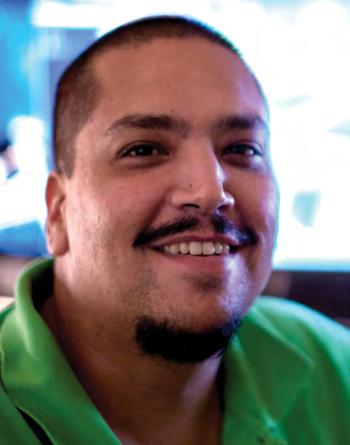
Best advice: Keep working on the fundamental skills — the need for them is always there, and they never go out of style. Explore [and] learn as much as you can about all the things you love; inspiration is everywhere. Be organized. Keep an open mind!
Director, Millie Magnificent (Nelvana)
Age, Birthplace: 43; The Philippines
School: MTM College of Animation, Art and Design in Toronto, Canada
I knew I wanted to have a career in animation when: Although I drew on everything from the moment I could hold a crayon, it was being around my brother, who studied fine arts and started working in animation. I was around 10 when he used to bring his work home, and I’d sit and watch him animate scenes.
First job in animation: Storyboard cleanup
What I love about my current project: Everything! The stories, artwork, crew, music! And how I get to sneak in little things that I love into Millie’s world.
Biggest challenge: Juggling the time between directing and mom duties. If I’m not in a meeting or calling retakes, I’m making dinner or driving my girls to skating or helping with their homework. Fave animated movie or TV show growing up: Just one?!? I’d have to go with Looney Tunes. I learned to appreciate both animation and music by watching Bugs Bunny.
Role model: Just one again??? Brad Bird. The first time I watched The Incredibles, it blew my mind. Best advice: Do what you love so it won’t feel like work; it’s a whole lot of fun instead.
Future plans: Continue directing or storyboarding for as long as I can hold a pencil.


Art Director, Tabby McTat (Magic Light Pictures)
Birthplace: Cape Town, South Africa
School: Durban University of Technology
I knew I wanted to have a career in animation when: Since day one, I have absolutely loved anything and everything creative! My childhood was about drawing, painting, making things, creating worlds, designing puppets from found objects and immersing myself in cartoons and Disney films! Although I didn’t quite intentionally aim for the animation industry, my path led me here and I absolutely love it!
First job in animation: Kellogg’s Coco Pops commercial
What I love about my current project: I love watching how the stories, characters and environments are interpreted and translated from the much-loved children’s books into something living, breathing and magical. Magic Light Pictures pools together an incredible range of talent, which is ultimately the fuel that forms a “dream job.” Working with talented people keeps you motivated and inspired.
Biggest challenge: Knowing when to stop, when to end the day and not continue into the night assuming whatever you are working on will only get better and better! The trick is to learn a lifecareer balance and commit to your time limitations.
Fave animated movie or TV show growing up: Disney’s Alice in Wonderland (1951)
Role model: Again, I have many — but currently and most definitely, Joanna Quinn.
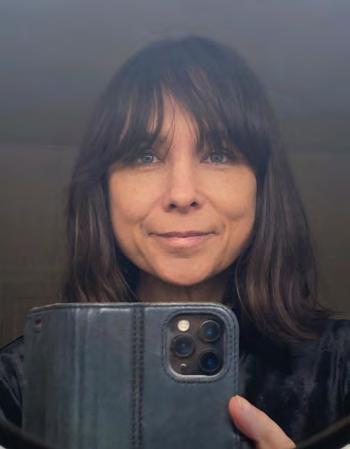
Best advice: Not every young adult gets their dream job straight out of college or even gets the opportunity to go to college, but these days the internet gives everyone a platform to learn, grow and show off their talents to the industry. In my opinion, skills, a solid work ethic, enthusiasm and a dash of humility will bring the “dream job” to you!
Future plans: This year I am art directing for the next Magic Light Christmas special (shhhh!) and will then be excited to see what comes next. There are always new projects, new technologies and different roles to consider, and one never stops learning, adjusting and growing. On the side, my mother and I are also currently completing development on a personal short film and very excited to see where that goes. ◆
This month’s Cartoon Movie event in Bordeaux offers an indepth look at 55 upcoming European animated features.
Global animation veterans look forward to the annual Cartoon Movie event in Bordeaux, France, as much as they anticipate the arrival of spring. This year’s annual parade of upcoming animated movies in various stages of development and production will showcase 55 projects, March 5 to 7.
As has been the case for many years, France has emerged as the leading producer of animated movies in Europe, with 15 projects in 2024. It’s followed by Belgium, Germany and Spain with five each; Norway with four, Italy, Luxembourg and Poland with three each; Czechia, Denmark, Ireland and Sweden with two each; and Finland, Hungary, Netherlands and Portugal with one each. The majority of projects are in the development stage (33, 60%), and most of the pics are aimed at family audiences (31, 54%).
Seasoned directors will present their latest projects at Cartoon Movie 2024, including In Concept works by Alain Ughetto (director of No Dogs or Italians Allowed, 2022) with Rose and the Marmots, or Alessandro Rak (director and co-writer of The Art of Happiness, 2013, winner of the 2014 European Film Award for European Animated Feature Film) with The Little Prince of Shangri-La

In development, attendees will be introduced to Dog my cats! by Alain Gagnol (co-director of Nina and the Hedgehog’s Secret, 2023), Out of Frame by Toby Genkel (director of The Amazing Maurice, 2022), Summer in the Hood by Jean-Pascal Zadi (actor, director and writer) & Louis Clichy (co-director of Asterix: The Mansions of the Gods, 2014), The Wild Inside by Patrick Imbert (writer and director of The Summit of the Gods, 2021).
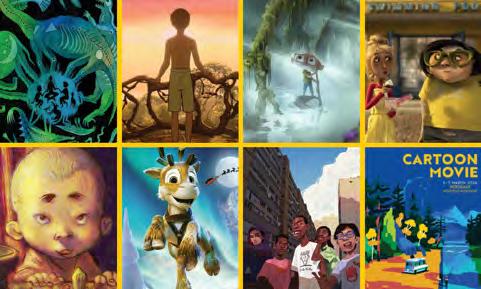
First-look images and footage of films In Production will be shown by Alexis Ducord (co-director of Zombillénium, 2017) & Vincent Parronaud (writer-director of Persepolis) with Into the Wonderwoods, as well as directing duo Kari Juusonen & Jørgen Lerdam (The Incredible Story of the Giant Pear, 2017) with Niko – Beyond the Northern Lights.
And in the Sneak Preview section, audiences will discover Elli directed by Jesper Møller, Piet de Rycker & Jens Møller, as well as Kensuke’s Kingdom (nominated for the Annecy Cristal in 2023) by Neil Boyle & Kirk Hendry, Living Large directed by Kristina Dufková, and SuperKlaus by Steven Majaury (Mission Kathmandu: The Adventures of Nelly & Simon, 2017) & Andrea Sebastiá.
The winner of this year’s Cartoon Tributes will also be announced at the event. The nominees are:
• Animagrad (FILM.UA Group) (Ukraine) for Mavka. The Forest Song
• Fernando Trueba Prod. (Spain) / LolaFilms (Spain) / Les Films d’Ici Méditerranée (France) / Submarine (Netherlands) & Animanostra (Portugal) for They Shot the Piano Player
• Sacrebleu Productions (France) / Take Five (Belgium) & Ciel de Paris (France) for Sirocco and the Kingdom of the Winds
• TAT Productions (France) for The Jungle Bunch: World Tour and Epic Tails
• Eurozoom (France); The Island, Buñuel in the Labyrinth of the Turtles, Cafard
• Films4You (Portugal); Calamity: A Childhood of Martha Jane Cannary, Flee, Titina
• Pro Films (Bulgaria); The Inseparables, The Elfkins – Baking a Difference, Dreambuilders
• Selmer Media (Norway); Epic Tails, My Fairy Troublemaker, Dragonkeeper
• Enzo D’Alò for A Greyhound of a Girl (Italy)
• Isabel Herguera for Sultana’s Dream (Spain)
• Chiara Malta & Sébastien Laudenbach for Chicken for Linda! (France)
• Jérémie Périn for Mars Express (France)
Winners will be announced at the Bordeaux Congress Center on March 7. ◆
For more up-to-date info about the events and the selected projects, visit cartoon-media.eu.
Producer Marc Jousset offers us a sneak peek at the imaginative new movie, Into the Wonderwoods.
Atale of a young boy’s adventures in a magical forest is among the most-anticipated animated movies being showcased at this year’s Cartoon Movie. Based on an acclaimed graphic novel by Vincent Paronnaud, who co-directed Persepolis with Marjane Satrapi, the 2D/3D animated feature is directed by Paronnaud and Alexis Ducord, and is expected to be ready for delivery this May.

“Paronnaud, who is known by his artist’s name, Winshluss, likes to play with the codes and genres of literature and cinema,” says Je Suis Bien Content producer Marc Jousset. “He manages to bring together the elements of children’s stories and genre films, highlighting strong themes such as ecology. Je Suis Bien Content has a long history of producing 2D animated features, so we asked Arnauld Boulard of Gao Shan Pictures, which specializes in CG to co-produce the film with us.”
The film’s central character is an adventurous young boy named Angelo, who dreams of being an explorer and zoologist. When he is accidentally abandoned at a rest stop by his distracted parents on their way to visit his ailing grandmother, he has to find his way through a mysterious forest inhabited by strange creatures.
Jousset, who also produced Persepolis, April and the Extraordinary World and last year’s acclaimed feature Mars Express, says he likes the fact that Paronnaud is allowed to move away from the original graphic novel while retaining his style. “Together with Alexis Ducord, he has achieved in creating an ambitious visual dimension with his multiple references to science fiction and musicals,” says the veteran producer.
Into the Wonderwoods (French title: Dans la forêt sombre et mystérieuse) is billed as a

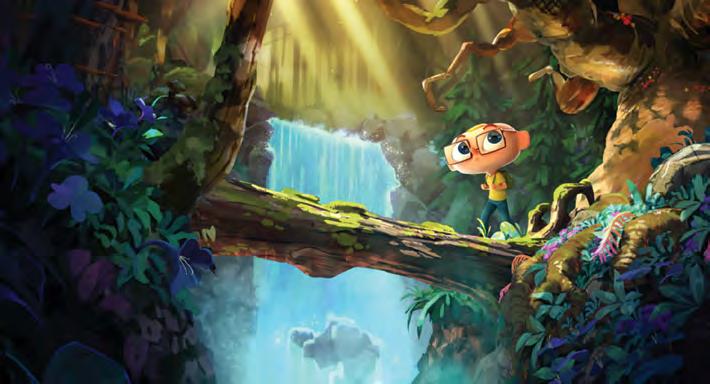
France-Luxembourg co-production with three producers: Je Suis Bien Content in Paris, Gao Shan Pictures on Reunion Island and Zeilt Production in Luxembourg. Beaux et Bien Habillés and Amopix in other French regions completed the production team. The film is billed as a CG-2D animation hybrid. According to Jousset, the filmmakers and art director Luciano Lepinay were able to succeed in creating a singular style by playing with the production’s lighting.
He adds, “One of our great challenges was maintaining visual coherence with these different animation styles. The film is structured in CG, which allows us to go into narrative digressions with the 2D sequences. We also faced a technological challenge, using real-time rendering with Epic’s Unreal Engine.”
When asked about the state of animation in 2024, Jousset tells us, “Well, the market has surely been in better state. However, we’re fortunate to have a very diverse range of films, both in terms of animation techniques and storylines, for both young and adult audiences, as can be seen at Cartoon Movies with films in
development or in production. Studios continue to offer new graphic and narrative styles, while investing in technological developments to meet the needs of audiences always attentive to original projects. We also need distributors, broadcasters, streamers and our other partners to match this ambition with our productions and authors.”
Jousset says he believes that his film’s unique style makes it stand out from many of the animated features aimed at family audiences. “Winshluss has a very particular universe,” he points out. “He’s a well-known author of adult comics. After he became a father, he immersed himself in the great classics of children’s literature and animation to create a comic strip and then a film for children. So there are several levels of reading pleasure for young and old alike. We were lucky to have a very good animation team that succeeded in bringing the characters to life with humor and irony, but also with a great deal of tenderness.” ◆
For more info, visit jsbc.fr and gaoshanpictures.com.
‘We were lucky to have a very good animation team that succeeded in bringing the characters to life with humor and irony, but also with a great deal of tenderness.’
- Producer Marc Jousset
There are so many brilliant and original movies debuting at the event this year, but here are a few titles that grabbed our attention before the show. Visit our website for full coverage of the event in early March.
Among the many movies making a splash at Cartoon Movie is a new project by director Alain Gagnol and producer Jérôme DucMaugé, who collaborated on last year’s pic Nina and the Hedgehog’s Secret. Their new 2D-animated movie Dog My Cats! follows the adventures of a young brother and sister who discover that their visiting grandmother has the ability to talk to cats and dogs.
“We were in the middle of production on Nina and the Hedgehog’s Secret, directed by Alain Gagnol, and I suggested we develop a new project together,” Duc-Maugé tells Animation Magazine. “Unlike his first three films, we didn’t want it to be about a child solving an adult problem, but rather a family comedy. Alain came up with the idea of a grandmother who has the power to talk to cats and dogs and who passes it on to her grandchildren on a road trip.”
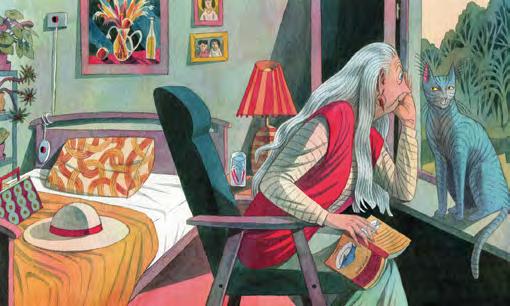
According to the producer, the film’s 2D animation will be produced in France, Luxembourg and possibly in Canada, and it should be ready for theaters by 2026. “Of course, getting cats and dogs to talk to us is a big challenge,” Duc-Maugé says with a smile. “But we’re counting on our lead actress, Josiane Balasko (French Twist, The Hedgehog, Too Beautiful for You), who voices the grandmother, Jeanne. She loves them very much!”
This 2D adaptation of popular Belgian artist Pieter De Poortere’s graphic novel follows the life and mysterious death of a wild and crazy humor icon known as Dickie — from his tumultuous childhood to his rise and fall as a popular comic. Directed by De Poortere himself, with a script by Bill Morrison, this animated mockumentary has a great potential to be a fun spoof of fame culture, some of our favorite movies and annoying Hollywood celebrities. The Belgian-Serbian co-production is currently in development with producers Renaat van Ginderachter, Peter Rogiers and Predrag Joldić (AIMI Studio) attached.
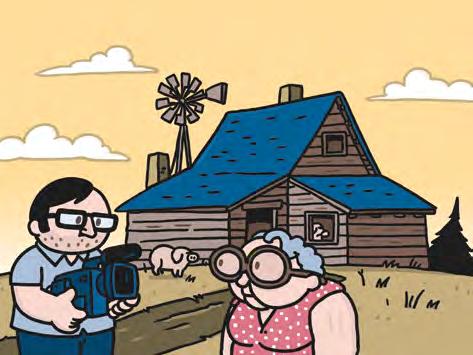
Jesper Møller, Piet de Rycker and Jens Møller are the talented directing trio behind the new CG-animated feature Elli. The charming family film centers on the adventures of a homeless little ghost who finds herself on a mysterious Ghost Train and is befriended by an eccentric group of monsters. However, when she is accidentally spotted by the outside world, she has to team up with her new family to avoid an impending disaster. Based on the book by Klaus Baumgart, the movie is produced by Germany’s Dreamin Dolphin (Lilian Klages) and co-produced by Canada’s CarpeDiem Film (Marie-Claude Beauchamp) and Germany’s Traumhaus Studios (Michael Luda). We see good things materializing for this friendly little ghost.
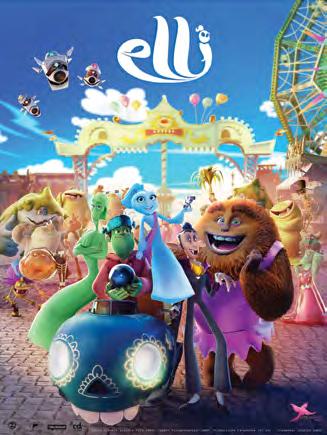
The trials and tribulations of a bullied, overweight 12-year-old is the heart of this highly original movie directed by Kristina Dufková (Fimfarum 3) and based on a book by Mikaël Ollivier (La vie, en gros). Aimed at a teen audience familiar with the challenges of life at the protagonist’s age, Living Large uses a mix of stop-motion and CG animation to tell its heartwarming story. Czech studio Barletta (Matej Chlupacek) is the project’s main producer, along with co-producers Slovakia’s Novinski (Agata Jeleneková) and France’s Novanima Productions (Marc Faye).

Italian writer-director Alessandro Rak, who is best known for such movies as The Art of Happiness, Cinderella the Cat and Yaya and Lennie: The Walking Liberty, is back at Cartoon Movie with a fascinating new project: The Little Prince of Shangri-La centers on the search for the 14th Dalai Lama in Tibet by a small expedition. The ill-assorted team consists of Alexandra, a very young French explorer; Aphur, a young warrior monk; and Kewstang, an elderly and very friendly Lama. Will the trio be able to find the new Dalai and save Tibet? Judging from the eye-catching early illustrations and Rak’s excellent track record, we know it’s going to be a fascinating journey! Italy’s MAD Entertainment is the producer.

Author Michael Morpurgo (War Horse) is having quite a moment. His book Kensuke’s Kingdom was adapted into an acclaimed new animated feature by Neil Boyle and Kirk Hendry, while French studio Xilam is working on another one of his books, Listen to the Moon The lovely 2D-animated movie follows Lucy, a lively girl with extraordinary faculties, who seems out of place among the fishermen of the Isles of Scilly. She discovers a new strength when she befriends a mysterious girl named Milly. The upcoming feature is directed by Olivier Clert, produced by Xilam president Marc du Pontavice (I Lost My Body) and Lucie Bolze
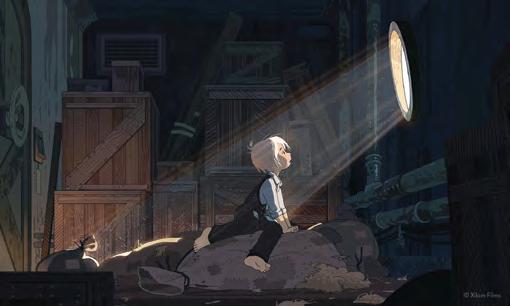
Back in 2018, Milorad Krstic made a big splash with his thought-provoking animated feature Ruben Brandt, Collector. The talented Slovenia-born, Budapest-based artist will be bringing his new project, MouMoush — The King of Plastic, to Cartoon Movie this month. Written and directed by Krstic, the 2D-CG hybrid pic centers on two siblings whose summer break turns into an adventure fighting an evil man who dreams of world domination. After MouMoush and his righthand, Dr. Sinistrad, use a secret potion to turn Paris bridges and the Eiffel Tower into croissant dough, the siblings travel back in time to foil his plans. If you need to learn more about this intriguing venture, you’ll have to get in touch with Krstic and his producer Radmila Roczkov at Hungary’s Mumus Production. Or you can read our report after the presentation online!
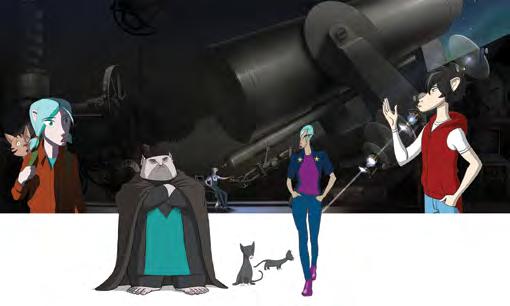
Jean-Pascal Zadi is best known for his César-winning performance in the 2020 movie Simply Black. This year, the talented actor and writer has a new animated project on the horizon. Summer in the Hood is co-written and co-directed by Zadi and Louis Clichy, the latter of whom also helmed Asterix: The Secret of the Magic Potion and Asterix and Obelix: Mansion of the Gods and worked on Pixar’s WALL•E and Up as well. The slice-of-life feature tells the story of 13-year-old Kali who leaves his home in Normandy to spend summer vacation in a housing project outside Paris. Silex Films (Priscilla Bertin) and Douze Doigts (Judith Nora) are the lead producers of the hard-to-resist feature. ◆
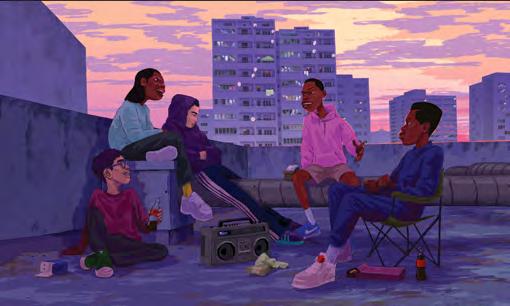
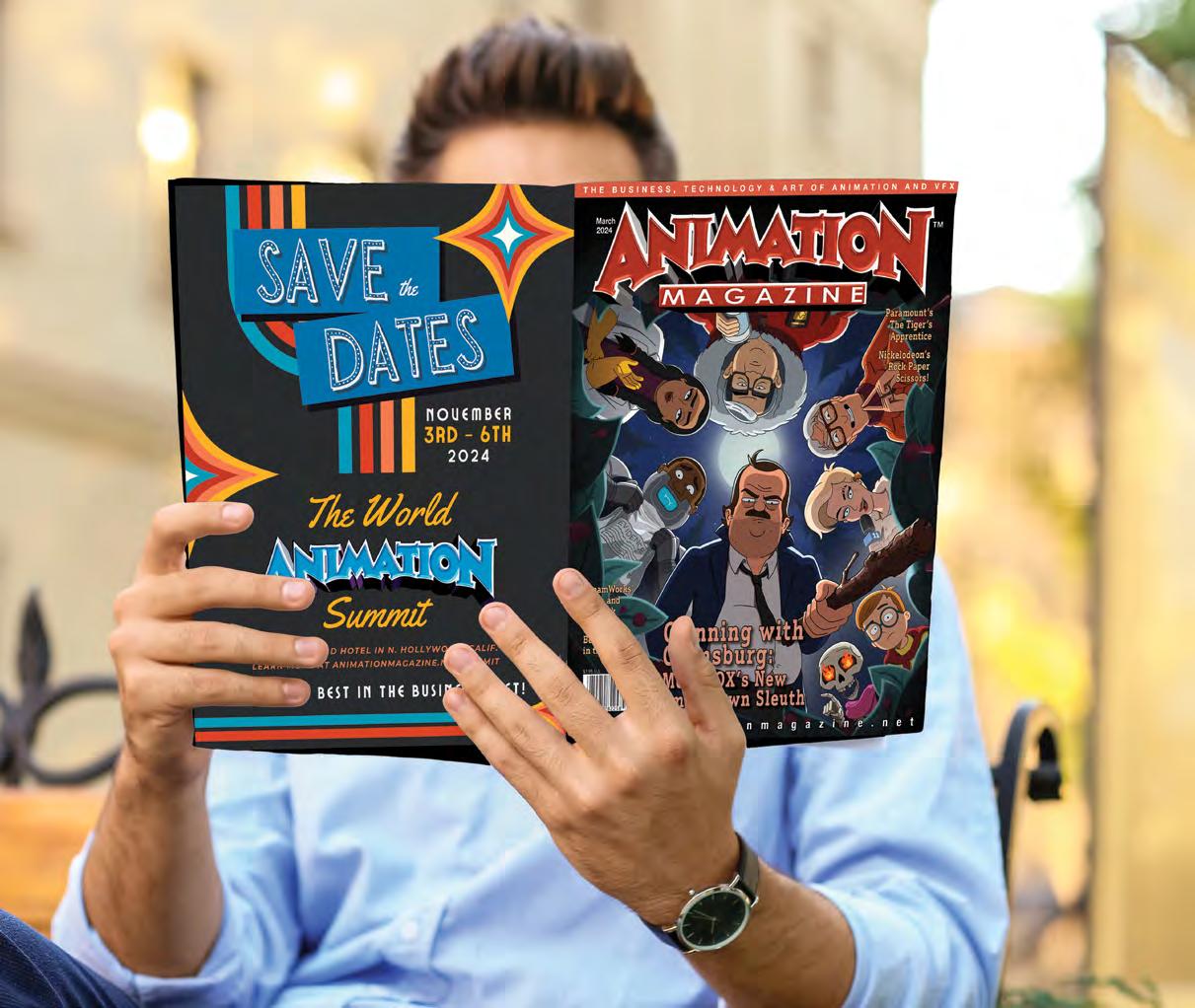
The 61st edition of the spring TV content market MIPTV will take place at the Palais des Festivals in Cannes, April 8-10. Here is an eclectic sampler of the new animated series available for buyers from producers and distributors around the world:
Created by: Clémence Madeleine-Perdrillat and Nathaniel H’limi
Type of Animation/Package: 2D, 6 x 26’
Target Audience: Kids and families
Synopsis: Set in the modern day, the show follows Violette, who at eight years old suddenly becomes an orphan and is sent to live with her uncle Regis, who is a gruff man and works as the caretaker of the Palace of Versailles. After a tough start, Violette finds self-confidence and begins to move on, thanks to Regis, her best friend Malcolm, her kindly social worker Genevieve and all of the new friends she makes.
Stand-Out Qualities: This is a sequel to the multi-awarded TV special of the same name, which has scored 27 international awards and over 50 award nominations, including at the Annie Awards in 2022 for Best TV Production.

Exec Quote: Marc du Pontavice, founder and CEO at Xilam Animation, said, “The original My Life in Versailles special had a remarkable performance on the awards and festival circuit, capturing the hearts of audiences and juries alike with its touching exploration of loss, family and belonging. As we continue to expand our slate of family-targeted animated series, it’s fantastic to collaborate with Films Grand Huit on this project and to bring the next installment of Violette’s story to international audiences.”
Delivery Date: Summer 2024
Website: xilam.com/en
Created by: Marc Brown (Arthur)
Produced by: Epic Story Media / Loomi Animation
Distributed by: Epic Story Media
Type of Animation/Package: 2D, 52 x 11’
Target Audience: Preschoolers, 3- to 6-year olds
Synopsis: HOP is a character-driven comedy that follows the adventures of Hop, a little frog with one leg shorter than the other, and his lovable, quirky friends. Together they show us the powers of friendship and kindness as they navigate the mud puddles of life.

Stand-Out Qualities: In each episode, Hop and his friends deal with a kid-relatable physical, social or emotional issue — exploring how each character’s unique abilities and perspective lead to hilarious and creative problem-solving.
Exec Quote: Creator Marc Brown tells us, “HOP began as a doodle of a frog, and that doodle grew into the world of Fair Village with the help of Peter Hirsch and my son, Tolon. We had no idea how much fun we could have inventing stories for preschoolers! We realized that HOP was also an opportunity to include characters who are underrepresented in children’s media. And why not have characters who act with tolerance, understanding and kindness?”
Delivery Date: Delivers to Max from April-September 2024
Website: epicstorymedia.com
Created by: Adam Goddard and Warren Brown
Produced by: Goddard/Brown
Distributed by: WildBrain
Type of Animation/Package: 2D, 20 x 2.5’
Target Audience: 5- to 8-year olds
Synopsis: Under the glow of a far-out sun, a merry band of colorful characters sing a collection of toe-tapping tunes all about feeling those positive vibes.
Stand-Out Qualities: From the creators of Big Block Singsong and ABC Singsong, this show is a collection of songs that bring together themes like hope, bravery, acceptance, positivity and love as pathways to mental wellness and growth for young audiences and their parents and caregivers.

Exec Quote: Caroline Tyre, vice president of global sales and rights strategy at WildBrain, says, “Songs From the Bright Side is a heartwarming, catchy and joyful collection of exceptionally well-crafted songs we think will really resonate with kids and parents alike.”
Delivery Date: July 2024
Website: wildbrain.com
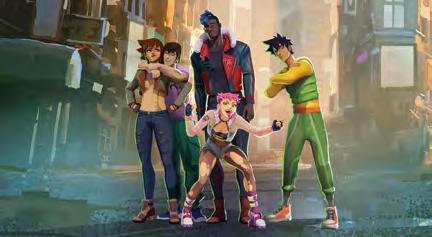
Created by: PJ Accetturo and Ryan Ramsey
Showrunner/EP: Michael Ryan
Director: Thierry Marchand
Developed and produced by: Battle Island (Michael Ramey and Katie Stippec)
Distributed by: DeAPlaneta Entertainment (worldwide except North America)
Type of Animation/Package: CG, 13 x 22’
Target Audience: 16+
Synopsis: In the near-future tech dystopia of San Francisco, the Tournament of Ruin is about to debut a brand-new, fully immersive technology — Neural Reality! Lee wins the opportunity to join the ranks of 100 of the world’s best gamers competing in a team battle royale. He and his friends must survive long enough to crack the secrets of Neural Reality before they lose their minds and become the Ghosts of Ruin.
Stand-Out Qualities: Outstanding quality animation. An all-star voice cast with Rosario Dawson, Justin Long, Nathalie Emmanuel and Tony Revolori. Original music by Hans Zimmer’s legendary collective Bleeding Fingers Music. A great blend of genres (gritty, dystopian, action, horror).
Exec Quote: Carlos Biern, director of content and distribution at DeAPlaneta Kids & Family, says, “We are excited to add such a powerful IP as Ghosts of Ruin, which has so much talent behind it, to the DeAPlaneta Entertainment portfolio. The quality of animation is exceptional, and its story is unique, original and exciting. We are sure it will become a favorite among young audiences, one of the targets we have been focusing on lately.”
Delivery Date: First episodes already available
Website: ghostsofruin.com
Created by: Matt Danner (Muppet Babies)
Produced by: Matt Danner, Sander Schwartz, Bruce Robinson from Free Play Media and Animasia Studio
Distributed by: Lacey Entertainment
Type of Animation/Package: 2D, 20 x 11’
Target Audience: Boys and girls, 6- to 12-year olds
Synopsis: Set in a world inspired by retro video games, this interplanetary adventure follows Jay and Dasha, a.k.a. “The Turbo Twins,” humans living on an alien planet cluster, who’ve gained outlandish superpowers by absorbing “Power Ups” native to their new home. When the Multi-World summons the Turbo Twins for a new mission, can they save the planet from a major threat and finish their homework on time?
Stand-Out Qualities: Super Free Play has a team of leading animation veterans, including Eric Bauza and Sander Schwartz, on board to bring Matt Danner’s original project thrillingly to life on screen. This innovative animation combines the pulsing energy of video games with the excitement and comedic narrative of action superheroes to create a new intergalactic series with universal appeal.

Exec Quote: Matt Danner says, “Super Free Play is the video game show I always wanted to watch. I’m beyond excited to have such a stellar team on board for my first original series.”
Website: superfreeplay.com
Produced by: Submarine (Netherlands)
Created by: Denise van Leeuwen and Tingue Dongelmans
Distributed by: Dandelooo
Type of Animation/Package: CG; 13 x 7’ and 26-minute special
Synopsis: Pol has never seen the forest before. Her friends have never seen a pirate before, especially one so small. But that didn’t stop them from joining her crew and setting sail for adventure. They just love how Pol sees something fun, magical or unexpected in what they always saw as normal and everyday. Or, as Pol likes to call it, a treasure!
Target Audience: Preschoolers, 3- to 6-year olds
Delivery Date: May 2025
Stand-Out Qualities: The series teaches viewers about teamwork, friendship, tolerance, love of nature, creative thinking, mystery-solving and helping each other.
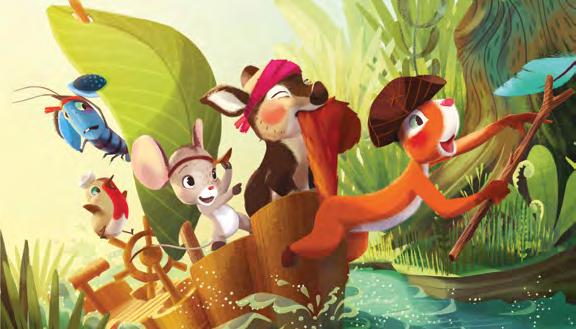
Exec Quote: Emmanuèle Pétry Sirvin, Dandelooo’s producer and head of international, says, “There’s something very special about Pol and her eclectic friends as they look for lost treasures to give back to whichever forest friend they belong to. We particularly love the fact that these five friends each have a slight handicap but form a strong group together in order to help other folks in the forest.”
Website: dandelooo.com
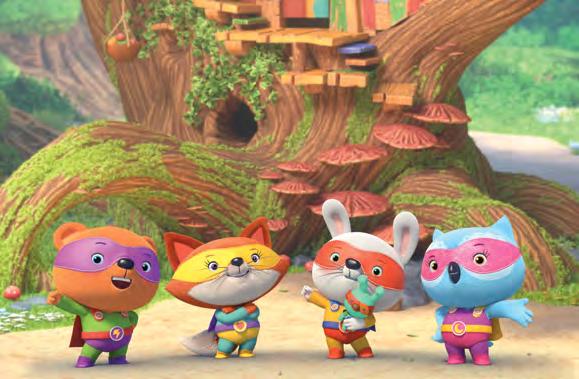
Created by: French publisher Auzou
Produced by: Movimenti Production and MoBo, co-produced by Zodiak Kids & Family France
Distributed by: Banijay Kids & Family Distribution
Type of Animation/Package: 3D, 52 x 7’
Target Audience: Preschoolers
Synopsis: Follows the playtime adventures of four woodland creatures who have mini mega powers. Gabin’s Bunny Hug makes everything better, Gaston’s Beary Bounce and Roll cheers everyone up, Jade’s Foxy Ear helps her communicate with everyone and Juliette’s Owly Eye helps her watch over her friends. When school is over, they put on their “secret” costumes and discover what excitement the woods have in store for them.
Stand-Out Qualities: Miniheroes of the Forest is created by the leading talent from Banijay Kids & Family’s group of producers and uses world-class 3D animation. The series builds on themes of friendship and teamwork, demonstrating empathy and emotional intelligence for preschool viewers. Rai Kids and France TV are already on board this preschool comedy-adventure.
Exec Quote: Giorgio Scorza, CEO of Movimenti Production, says, “We are passionate about Miniheroes of the Forest, which we love for its simplicity, the tenderness of the protagonists and the messages it conveys. The adventures, and those mini mega powers that are in each of us, are sure to captivate audiences immediately. MoBo, with its 3D animation expertise, was the obvious choice to bring on board, and we’re also delighted to welcome our friends from Zodiak Kids & Family France.”
Delivery Date: 2024
Website: banijaykidsandfamily.com
Produced by: Gigglebug Entertainment
Created by: Character designer Said Omar Eshaq and storyboard artist Romain Beuriot, as part of Gigglebug’s internal Ideas Lab
Directed by: Joonas Utti
Package: 52 x 11’
Target Audience: Kids, 6- to 9-year olds
Synopsis: Set in a vast and perilous pond, this comedic series follows the underwater odyssey of Ted and Paula, two seemingly insignificant tadpoles who brave the dangers of the creek as they quest to reach the top.
Stand-Out Qualities: The series is simultaneously produced for linear (horizontal screens) and mobile (vertical screens) viewing.
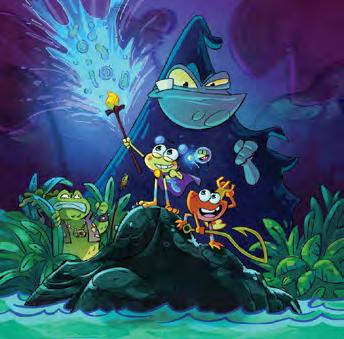
Exec Quote: Anttu Harlin, Gigglebug’s CEO and co-founder, said, “Tadpoles was born of out of us challenging our team to flex their creative muscles and invent a vertical story — and Said Omar Eshaq and Romain Beuriot’s universal concept of kids growing up, while literally venturing upward, immediately stood out. As our two tadpoles take on the dangers of the pond, viewers will also see a unique video gamelike progression of the characters, as they gain abilities and learn lessons along the way. We can’t wait to share it with partners at MIPTV.”
Delivery Date: 2026
Website: gigglebugentertainment.com
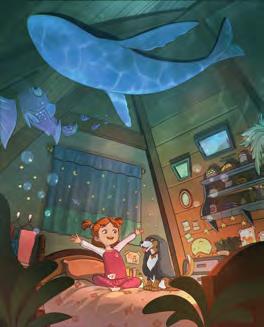
Created by: Sally Marchant
Produced and distributed by: Omens Studios
Type of Animation/Package: CG, 52 x 7’
Key Creatives/Credits: Sally Marchant (123 Number Squad!, Peppa Pig)
Target Audience: 3- to 6-year olds
Synopsis: At the end of each day, six-year-old Lexi snuggles down on her bed and recalls in story form what she’s done that day for her lovable old dog, Lingo. Through Lexi’s vivid imagination and extensive use of synonyms, her creative and funny stories come to life in unexpected and exciting ways which will boost the vocabulary of preschoolers everywhere.
Stand-Out Qualities: The word gap for children is growing at an alarming rate, with an estimated one in five children being behind with their talking and understanding of words. Lexi and Lingo addresses this issue through fantastical storytelling, animation, intonation and music to encourage preschoolers to expand their vocabulary in a fun, exciting and fresh new way.
Exec Quote: Chi Sim Tang, CEO of Omens Studios, said, “We are incredibly excited about Lexi and Lingo and proud to showcase a heartwarming series that combines Lexi’s vivacious, imaginative stories whilst also providing audiences with a broad scope of vocabulary, which has been found to be an essential tool for preschoolers today.”
Website: omens-studio.com
Created by: Hugo Mitoire (storybooks)
Produced by: 25-27 Estudio Audiovisual
Distributed by: Monster! Entertainment
Type of Animation/Package: 2D 4K, 10 x 13’
Target Audience: 6- to 12 year olds
Synopsis: A group of children is absorbed by a mysterious book that transports them to a terrifying world of fears and nightmares. Inside this magical universe, they must face monsters and mythological creatures and learn to fight as a team. They will have the help of Franco, A being of mysterious origin will aid them along the way.
Stand-Out Qualities: The show is ideal programming for Halloween. It’s a highly original, serialized series based on bestselling books
Exec Quote: “We’re so excited to be launching this brilliant, highly original and beautifully animated series for kids who like to be scared at Halloween, or anytime,” says Monster! Entertainment’s Chairman, Andrew Fitzpatrick.
Delivery Date: Immediately
Website: monsterentertainment.tv/?product=tales-of-terror-for-franco ◆
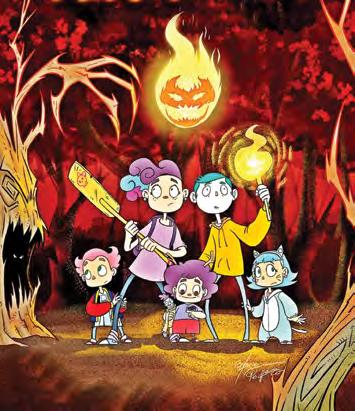
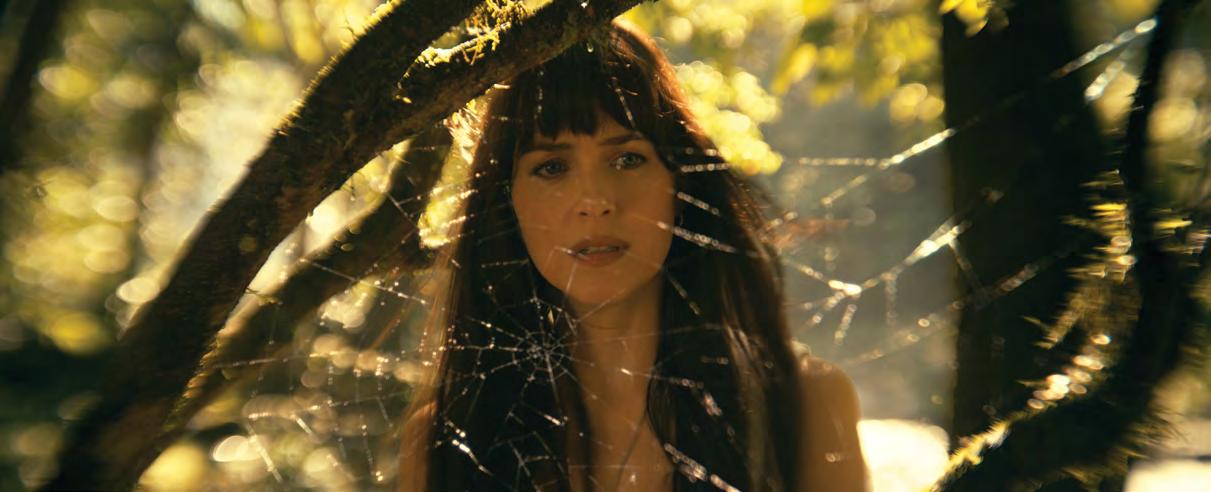
The latest Marvel feature Madame Web offers a new spin on the familiar world of Spider-Man, with a stand-alone tale based on a character that first appeared 44 years ago in The Amazing Spider-Man, issue No. 210. Created by Denny O’Neil and John Romita Jr., the plot centers on a superheroine with clairvoyant powers. The February release is directed by TV veteran S.J. Clarkson and serves up an origin story in which New York City paramedic Cassandra Webb (portrayed by Dakota Johnson) uses her powers to protect three young women with various types of spider-like abilities. Digital Domain, beloFX, One of Us, Outpost VFX and Territory Studio created 1,400 visual effects shots overseen by VFX supervisors Mike Brazelton and Charlotta Forssman.
“It’s almost going to be two years from start to finish for me,” says Brazelton. “The first Spider-Man with Sam Raimi and Tobey Maguire was one of the first films that I ever did. This is a much more grounded story. It’s not relying so heavily on big visual effects pieces as some of those
other Spider-Man films did. There is a different visual language.”
Defining the visual language is also a particular superpower of Madame Web’s (Johnson). “She is able to see into the future and across all of the different metaverses; trying to find a way to show that visually and connect to her character has been cool,” he notes. “The spiderweb in general is intriguing to simulate because each one is different like a snowflake. It’s an interesting thing to use as visual storytelling vehicle.”
Part of the team’s research was to find out how the characters and their powers were portrayed in the comic books. “It’s cool to take something that you’ve seen as a kid and bring it into a three-dimensional space and amplify that storytelling,” Brazelton adds. You can do those things because of where visual effects is right now in the world.”
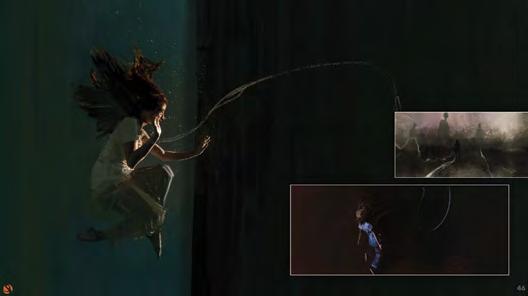
The VFX supe says avoiding the feeling of weightlessness is hard to achieve when you have characters with the ability to defy physics. “Besides the web-slinging, Ezekiel Sims [Tahar Rahim] has a lot of the same superpowers as Spider-Man — like superstrength and the ability to jump and leap,” says Brazelton. “One of the hardest things is showing somebody as [a] human jumping from point A to B — which is a totally unrealistic thing to do — but [also] to give it the characteristics that it takes effort and strength to do it. I can think back to some Captain America shots where there is an unbelievability to the trajectory and weight that he uses to fly. That weightlessness is a constant battle. When you use

‘The problem with a stunt rig is you are assisting someone’s physical strength, so you’re trying to find a balance between using those real stunt performances and taking them over.’
— VFX supervisor Mike Brazelton
stunts and stunt rigs, which we did often, it’s a great starting point, but you can never get the full thing, so you end up taking over. The problem with a stunt rig is you are assisting someone’s physical strength, so you’re trying to find a balance between using those real stunt performances and taking them over.” Astral projection was also given a unique Madame Web spin. “It’s interesting to try to build up that storytelling aspect of it,” observes Brazelton. “This film starts off with Cassandra Webb/Madame Web as an EMT [Emergency Medical Technician] discovering her connection to the Web of Life, how she fits into it and can control it. We definitely referenced Doctor Strange but didn’t want to copy it. Like anything that you’re discovering and developing with the work that we do, you reference, try and test. We had tons and tons of different ideas with various levels of success, and you eventually come to [a] place where it all comes together.”
terrings III, the gaffer, helped to design these double-sided LED strips that were placed on the gloves of Sydney Sweeney, which we would trigger remotely,” reveals Brazelton. “There is a scene later on in the film where one of the stunt performers had LEDs wrapped around where the webs were going to hit him, so we had the interactive light source. We would paint that stuff out and put our effect over the top of it. We definitely took aspects of Tesla coils, lightning bolts and plasma balls. It took us a solid year of concepting and development to get to a place where we felt that
PLANNED PERFECTION: A sampling of the detailed concept art created for Madame Web shows the level of detail the vizdev team worked with to bring the complex sequences to life.
Although the film is set in the New York City of 2003, most principal photography took place in present-day Boston. “What the art department puts in physically is usually limited to the ground floor,” remarks Brazelton. “You go to [a] place and say, ‘We can put posters up for Mariah Carey,’ which people resonate with from 2003. We did some clever planning on where and how we shot. The more distant vehicles we had to touch, but a lot of times the more near vehicles we did not change because we made sure to get 2003 vehicles in place. I went out and shot a bunch of photography of New York from certain buildings, so when we were inside apartment buildings, you use bluescreen to see a view of New York City. We did a lot of research in how that skyline has changed. There are definitely specific buildings that were there or not there. It’s a more naked skyline.”
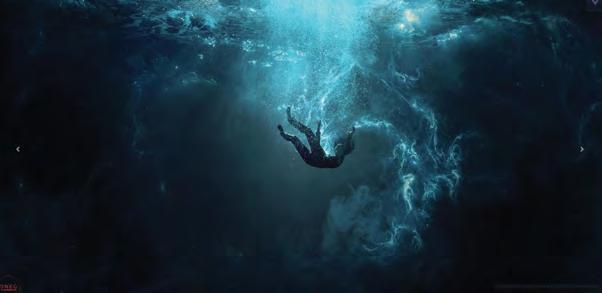
Madame Web befriends a trio of women with their own unique superpowers. “Mattie Franklin [Celeste O’Connor] has legs coming out of her back, and we wanted to do something different,” Brazelton says. “There are definitely moments in some of those Spider-Man films where the legs almost seem to be working in their own accord, whereas Mattie is physically moving her body to motivate and justify what these legs are doing. What’s interesting about her legs too is it’s a mutant power rather than Iron Man tech.”
Julia Cornwall/Carpenter (Sydney Sweeney) stuns her adversaries into submission with electroshock psychic spiderwebs. “Frans We-
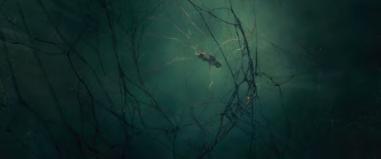
we were doing something unique and new.” Anya Corazon (Isabela Merced) has had various iterations of her character depicted in the comic books. “There are some earlier ones where you have this disc on top of a spiderweb with these spikes that come out of it and that’s what we referenced there,” explains the supervisor. We created this disc that starts off flat with a glow in the center, and as she throws it these spikes come out of it and it can be attached to a spiderweb. The disc has a will of its own and an ability to do things that are not 100 percent realistic. It’s a dangerous, lethal and wicked weapon.”
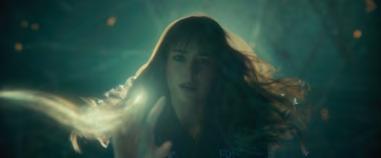
The film’s Web of Life shots were very complex. “The most difficult stuff is when you’re in a bluescreen volume and creating amazing things that have never been established before,” he points out. “There are so many cool things in the film. I’m even proud of the spider we created. Of course, the astral projection sequence has been incredibly difficult, and people are going to love that S.J. Clarkson had a real creative vision to do something that hadn’t been done before, and Charlotta Forssman and I were able to accomplish that.” ◆
Sony’s Madame Web opened in theaters on Feb. 9.

Foundry’s latest release of Nuke 15 (and 14.1) presents a slew of new features, which we’ll get into, but first a note about why there is a dual release of 15.0 and 14.1: There is a transition underway from VFX Reference Platform 2022 to VFX RP 2023, and along with it a replacement of Linux flavor CentOS 7 with Rocky 9. Since migrating operating systems is not trivial, especially in studio environments, Foundry wants to ensure that the transition is as seamless as possible, so projects can upgrade to 14.1 without breaking current projects and then switch to 15.0 when ready to upgrade to Rocky 9. Not the shiniest update, but supremely important.

CopyCat can be distributed across multiple machines, which is analogous to how you’d render frames on a farm. So, you can set up your training, throw it to other machines and get back to your comp while CopyCat learns. Furthermore, CopyCat has been reconfigured to automatically reduce image resolutions early in the learning process, which speeds up the training. On top of that, with Nuke Studio, you can propagate the training across a sequence, where you’re applying the same effects over multiple, similar shots.
Updates to the 3D environment Nuke have been (and still are) in beta as Universal Scene Description (USD) workflows are incorporated. In a similar fashion to the dual version release, Foundry has kept the previous 3D tools active while migrating things over to the newer system. Lots of features have been added in this round based on beta user feedback. There is a new selection system with a dedicated toolbar for interacting with the 3D objects in the scenes, allowing for selections at the object, face and vertex level, plus you can filter what kinds of objects you want to select.
When dealing with large USD scenes, there is a lot more data to manage. You already had
an outliner-type scene explorer window, but it was cumbersome to find, select and apply objects to geo nodes — so Foundry added a pop-up scene graph next to the input field of the node, so you can easily select the object you wish to work with.
GeoMerge has also been updated to include numerous modes in which to merge USD objects into a stage: merging layers, duplicating prims, flattening the layers and flattening to a single layer (for use when exporting USD scenes out to external files).
The new Nukes have been updated to natively support Apple silicon, so running on Macs get a performance boost of up to 20%. This includes timeline and node UX response. In both Nuke Studio and Nuke, Blink scripts, soft effects, CopyCat learning and inference have all specifically been optimized for Apple silicon. Nuke can now apply planar operations, such as distortions, spherical transforms and Cara VR nodes to up to 64K files. This probably doesn’t apply to us mere mortals who do comp work for films and streaming. But for those who work on exhibit installations and ride projects, this is, indeed, an essential update.
I’m running out of space, but to learn about all the new features, head over to the Foundry website to check them all out. Website: foundry.com
Price: $3,469 (annual subscription); see website for additional pricing
Mari 7.0 doesn’t quite have the breadth of new things as the Nuke 15.0 release, but the depth of the features is critical.
Probably the most substantial upgrade: Mari 7.0 has a new feature called “The Bakery,” which is something that Mari users have long been clamoring for. In 3D texture and shader development, artists frequently drive looks with procedurally derived textures that stem from the geometry of the model. In addition, many of these 3D-driven textures are used to apply looks from very high-resolution meshes onto lower-resolution versions — where you would lose all the fine detail that is in the hi-res model.
In the past, this process was most frequently done in Substance, which meant that artists would have to leave the Mari environment, go into Substance, bake out the maps, go back

into Mari, import the maps and apply them. This also meant that the artist would have to learn how to use both Mari and Substance. The Bakery keeps it all in-house. The artist can bake directly in Mari and use the textures directly. Not only that — each exporter in the Bakery has parameters to dial in the look of the maps before exporting, which takes out a lot of the guesswork.
Significant attention has been given to the UX for Mari’s node graph. Decoupling multiple nodes from a network could be tedious before, since you had to detach each pipe. But Mari 7.0 has an edge-sever mode (which looks like a razor) that you can drag across the connections to detach them. Or you can select a group of nodes and detach as a group. Alternatively, just shake the node, à la Nuke or Houdini, to pull the node out of the network. Furthermore, your node parameters highlight in the panel as you click on your node or vice-versa — or you can double-click on a node to bring the parameters to the top of the panel, again, à la Nuke. And, the search tool, accessed via the tab key, is now fuzzy, so typos don’t break the search. You can also get to tools by typing known acronyms instead of typing out the full name of the tool (which is sometimes quite long).
Automatic Project Backups sound like something that has been around for a while, but Mari’s system is a little different as it saves time-stamped iterations, along with thumbnails, and establishes restore points. This is to accommodate for supervisor notes that would require the artist to go back to previous versions. The thumbnails make it easy to find, but to make it even easier, the API has open hooks for the project-management system to access the restored versions and tag the appropriate one with the notes. Once a version is restored, the textures can be baked out and migrated to the newest version of the project.
USD workflows continue to update and stay
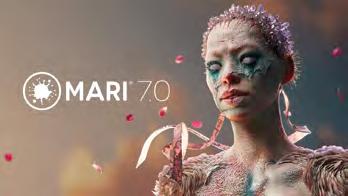
in line with Nuke and Katana. Most of Mari’s USD updates center around the organization of the USD prims. It now uses the scene tree view of a USD stage for visualization of the prims, which you can then select by clicking or even filtering by expressions. You can also switch between model variants, UV sets, mapping types and frame numbers for animated models. Website: foundry.com/products/mari
Price: $54.91 (per month); $749 (quarterly rental license); $2,280 (permanent license)
You might think that Foundry is big on incorporating USD into their ecology — and you’d be right. Katana 7.0’s big updates focus on USD, the UX working with it and how it works with Katana’s native object system when assembling and lighting shots.
The Katana and Nuke 3D systems use the same architecture under the hood, so they perform in the same way. And the interfaces parallel one another, thus the user experience is very similar. This allows artists who work in both packages to feel comfortable in either. Or, even better, when lighting artists and compositors communicate with one another, they are speaking the same language. This same UX feeling is found in Mari 7.0 as well. So, the whole



“But USD has already been in Katana,” you might say. Again, you’d be right. But Foundry has overhauled the USD nodes to conform USD 23.05 with newer USD LIVRPS (Local, Inherits, Variants, References, Payloads, Specializes) standards. The new nodes allow you to establish the order of operations. An additional set of stage manipulation nodes provide non-destructive modifications of the scenes. And there are scheme and TD nodes for establishing paths and data manipulation.
Additionally, Foundry has made it a point to ensure that USD objects and scenes can inhabit the same space as Katana native objects. This is the same philosophy as Nuke’s dual version release or maintaining two 3D systems inside Nuke. Don’t throw away the older system as newer systems are implemented.
Performance and stability have been boosted in Katana 7.0 by taking Live Rendering, which is basically continuous rendering in



make it multithreaded using Geolib3-MT runtime. And you can choose the type of caching that is happening, which Live Rendering uses to optimize memory management and speed. Live Rendering is not even really a choice in modern lighting pipelines. You have to be able to see, in real time, how your changes are affecting the scene, especially when you have things that aren’t represented in the GL viewport very well, if at all. Things like global illumination, reflections and refractions. Speeding up the Live Rendering is critical to an efficient lighting environment and reducing iterations.
Katana has generally been a tool for the larger studios as it once needed a broader pipeline. But as more and more studios have adopted it since Foundry took it over from its Sony Pictures Imageworks days, more and more artists are now familiar with it, so now more studios can utilize the growing base of Katana users.
Website: foundry.com/products/katana
Price: $4,199 (per year); Katana Render $323 (per year) ◆
Todd Sheridan Perry is an award-winning VFX supervisor and digital artist whose many credits include I’m a Virgo For All Mankind and Black





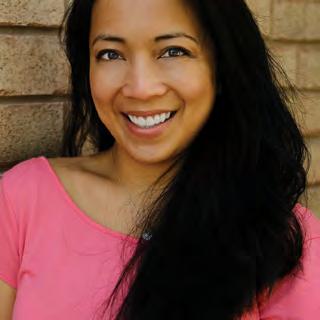
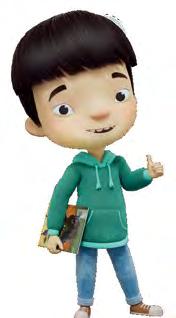

Oscar nominee Yegane Moghaddam tells us how she made her acclaimed short, Our Uniform.
Yegane Moghaddam’s innovative and subtle Our Uniform is the first Iranian animated short to be nominated for an Academy Award. An young girl recalls school-age memories through the wrinkles and fabrics of her old uniform in this inventive project, which uses cloth used for making school uniforms to tell its potent story. Moghaddam’s self-produced seven-minute animation won the Grand Jury prize at Spain’s Animayo Festival and the Jean-Luc Xiberras Award for a First Film at France’s Annecy International Animation Film Festival. Moghaddam, who lives in Iran, is an animator and illustrator who has a strong passion for nature, culture and the world she lives in. In her films, she often tries to find a voice for beings who usually don’t have a voice. She was kind enough to answer a few of our questions via email:
Can you tell us when you started working on the short?
Yegane Moghaddam: I began the project in September 2022. Right after the protests began in Iran following the death of Mahsa Amini, I was so moved and felt the need to do something. I always wanted to make a short film about our school uniforms, and that incident convinced me that this film should be made quite urgently.
How many people worked on the short with you?
I worked almost single handedly. My father was my producer who helped me with the basic necessities. My mom helped me with the embroidery. My brother was a huge help in making the Digital Cinema Package. It was basically a family project!
What was the inspiration for the story?
Our Uniform is essentially a cinematic exercise to represent “Hijab,” a religious practice that is quite foreign to most people who haven’t experienced it. So my real intention was to help the viewers reach out closer to a subject matter that is too far to comprehend. I wanted to articulate the feeling of being a girl student in Iran and what it’s like to have an extra layer of Hijab between you, the world around you and your skin. The main mission here was to represent a certain clothing convention and all the feelings associated with wearing it.
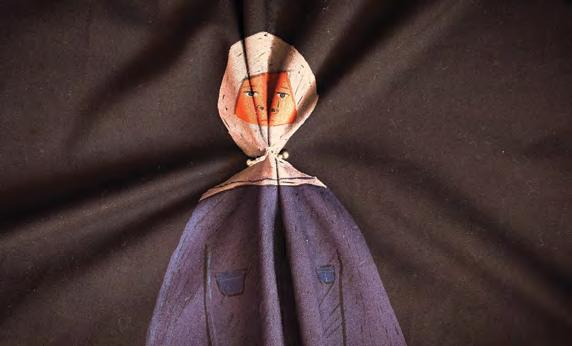

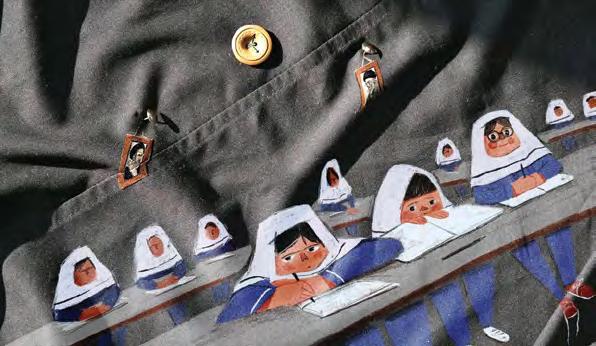
How did you decide on the wonderful visuals for the short? It’s such a clever type of animation.
This is a film about a particular dress-code that is mandatory for girls, so I decided to “veil” the entire film with this piece of cloth to reinforce its obligatory nature. I could never make this film with 2D/3D animation because my narration works hand in hand with the materials used in the background. There’s a constant interplay between the verbal and pictorial and the pictures are made out of fabrics, not 2D or 3D animation.
When did you know you wanted to work in animation?
I studied animation at the University of Tehran. I think I was always obsessed with the idea of “creation”— creating a poem, story, image, sculpture, etc. I found animation to be a very open and welcoming medium to all types of ideas and insanities!
Who are your favorite animation or live action directors?
There are quite a lot. I like to mention the Iranian directors who have been my true sources of inspiration. The one and only Marjane Satrapi [Persepolis], who made me fall in love with the art of comics and storytelling. Also the legendary Asghar Farhadi, who is the first crush of every young Iranian filmmaking student.
What do you hope everyone takes away from Our Uniform?
I don’t mean to convey any sort of message in this film. It’s widely open to all kinds of interpretations. But it’s worth noting that I got completely different feedback from the foreign audience and the Iranians. It looked like an absurd piece of animation to foreigners which made them laugh hard at some scenes. On the contrary, the Iranian viewers, especially girls, found it a sad piece of documentary reminding them of their real school memories. ◆
Our Uniform is one of five shorts nominated for an Academy Award this year. The Oscars will be held on Sunday, March 10, beginning at 4 p.m. (PDT) at the Dolby Theater in Hollywod.







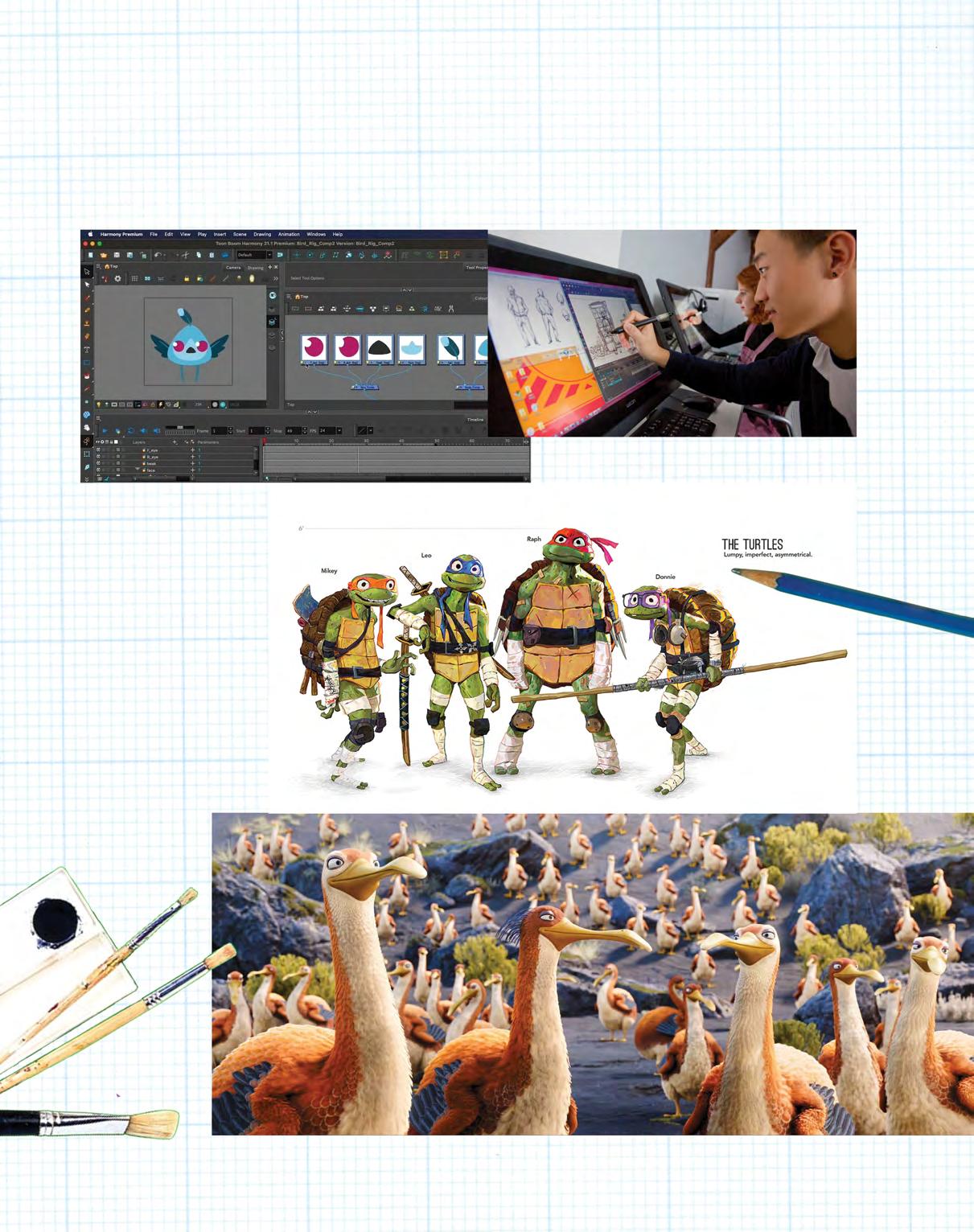
When creativity is the core of who you are, your ability to work with a team, be adaptable, and build networks will propel your journey and bring your ideas to life. Your imagination is your own. It changes your outlook, communicates your confidence and connects your passion and purpose to the world.
Better is education that is bold, and puts you first. animation.sheridancollege.ca

We surveyed six popular classes in different colleges around the country.
- By Ellen Wolff -An “alphabet soup” of new technologies is coursing through college classes these days: AI, AR, XR and VR are affecting curricula in increasingly interesting ways. At popular U.S. animation schools, teachers are reckoning with those impacts on class work and how to nurture the skills needed for good jobs in the modern world. Spoiler alert: Many emerging skills are additive at this point. Foundational abilities remain essential to succeeding in a collaborative industry like animation.
For the past 25 years, Claudia Herbst-Tait has wrangled the evolving toolkit used in Pratt’s animation curriculum. Her 12-student 3D Lighting and Rendering class combines historical context and aesthetic conversation with technical instruction using Maya, 3D Substance Painter and Nuke. “Our technical instruction asks a lot of our students,” she says. “Starting in sophomore year, we ask them to create an individual animated short in 15 weeks, every semester, from storyboard to finish, along with their other course work. The environments they’re lighting in this course will be used in their films.”
“I see diverse approaches,” observes HerbstTait. “Some are cartoonish, some emulate 2D
animation and stop motion. Others have a high degree of realism, but that’s not the Holy Grail anymore. I address different interdisciplinary approaches — so it’s not strictly 3D animation, but sometimes 2D or hand-drawn texture maps.”
Before joining Pratt, Herbst-Tait trained Walt Disney Feature Animation artists in 2D imaging and 3D animation tools. So, she’s taking the arrival of new AI technologies in stride. For example, her students can use AI in the development of textures applied to surfaces. “Sometimes students can use AI for look development and bouncing around ideas,” she notes. “I’m trying to think of AI in a way that aids the process without taking over any of the design principles we want them to learn.
“What I try to relate to them is that training


the eye and being able to make decisions about aesthetics means really understanding the principles of design. It’s ironic, but the most important skills are the least technical. Because what carries over from technology to technology is whether an image is ‘working’ or not. Can we identify its strengths and weaknesses and where we need to make edits? That’s really based on understanding how light and color interact and how to instruct the technology to produce something we want to look at. I’m talking to students about building skills that are relevant currently, but which will also translate into a future where a lot of these processes will be automated.”
She concludes, “I think there’s an awareness that things are coming that will change the landscape. I try to contextualize that and tell


them how the past connects to the future.” She likes to remind them of a quote (often attributed to the composer Gustav Mahler) that “tradition is not the cult of ashes, but the transmission of fire.”
University of Southern California, Los Angeles
At USC’s School of Cinematic Arts, Jordan Halsey has spent the past four years teaching Real-Time Animation using Unreal. His 15-person class, which spans 14 weeks, is open to both undergraduate and graduate students. “It’s pretty varied,” notes Halsey. “We have students from games and animation and computer science and even architecture. But almost everyone in the class is some kind of gamer. The ‘gamification’ of so many things has changed the way they look at things.”
To gain entry, students present their portfo-
lios to Halsey, who prefers they have some 3D animation experience using software like Maya. “It’s rare that we take first-year undergrads,” he notes. “But one kid who went to a performing-arts high school came with knowledge of Blender. He was able to take the class because of those skills.”
A primary goal for Halsey is to give students a foundation in world-building. “One thing that’s exciting about Unreal is that it empowers the user to become a world-builder. We end up building large landscapes. One student built an environment using photogrammetry assets and did all the character modeling in Unreal.”
Another key focus of the class is on cinematic storytelling and helping students understand the relationship between real-world cameras and the Unreal camera. “Gaming technology is changing how we make movies and how we look at them,” he believes. “When


these technologies shifted and changed in the early 2000s, I was surprised at how the film business was slow to embrace game-development methods.”
Because Halsey himself had worked professionally with real-time applications for live events, he came to understand how the workflows differed from more traditional production methods.
“People didn’t understand the pipeline at first,” says Halsey. “Now these worlds are merging, and there’s a diversity of techniques that are being modernized. It’s changing the way we look at production.”
A prime example that Halsey cites is the award-winning HBO show, The Last of Us “That was choreographed and shot like a firstperson video game.” He tells his students in his real-time class that developments coming out of gaming will reinform how we look at filmic language. “And we haven’t even seen the full hybrid experience yet!”


www.animationmagazine.net

Being able to craft experiences in virtual reality is a goal for an increasing number of students, and Ringling is forging a path for them to reach that goal. The Florida college began acquiring VR headsets for its gaming students in 2016, and by 2018 it had launched a VR major headed by longtime Ringling teacher Martin Murphy. “Our VR major is the only high-tech major that’s also available as a minor,” explains Murphy, who occupies an endowed chair as the department head of virtual reality development.
Murphy also teaches Ringling’s VR Thesis Preproduction, a 14-person class designed for juniors who are beginning to focus on what their senior capstone projects could be. Murphy, who previously oversaw senior thesis productions in gaming, saw the need for a thesis preproduction class in VR. “Students in this class receive an early opportunity to practice the skills they’ll need, and also to learn how to create an idea within a viable scope.” Two of his students are working on a VR driving game that will be fully immersive, he notes.
The school has acquired the new Apple Vision Pro headsets, and students are now delving into mixed reality. “We have students building ‘portals in the air’ and creating hand gestures to navigate those worlds,” he says. Murphy’s department worked with SIGGRAPH last year to create the launcher for the conference’s VR theater, and his students have crafted a ‘digital twin’ of Ringling’s campus. “They’re mastering the skills to get things into a realtime graphics engine like Unreal,” he explains. “The convergence with real-time 3D engines
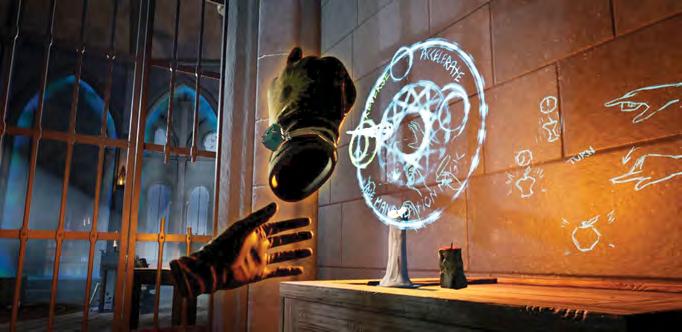
is mind-boggling.”
Murphy thinks students will be motivated by the growing job opportunities arising in very diverse applications for VR. “I’ve had a guest speaker who’s the XR manager at the jet company Gulfstream, and they’re using the technology all across their design and customer configuration process as well as their manufacturing. Walmart has deployed 18,000 headsets in its training programs, and the technology is being used for things you wouldn’t expect, like the Veterans Administration’s use of VR in mental health
programs. I love games, but I’m really excited about all the enterprise applications of VR.”
Ringling’s endowed VR chair was initially funded by health professionals, and Murphy’s students have also worked with the Moffitt Cancer Center to create VR experiences that prepare anxious patients for stressful procedures. “VR isn’t just for entertainment anymore,” he says.
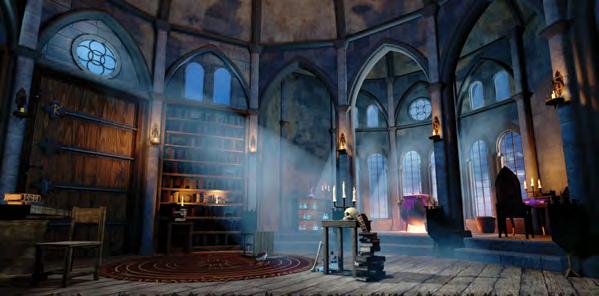
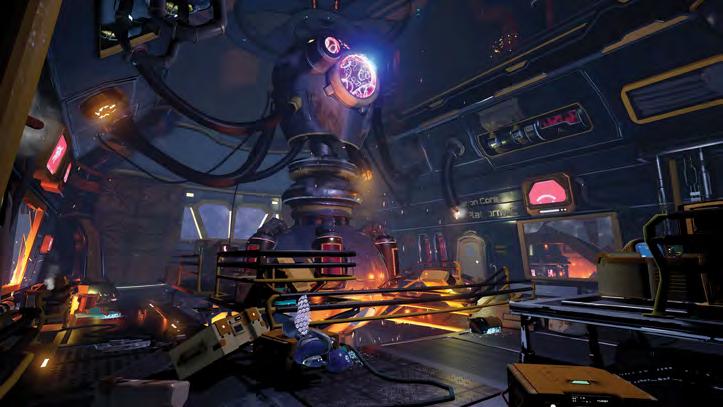

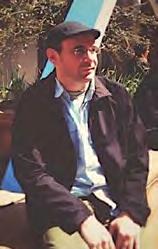
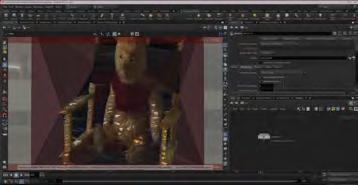
School of Visual Arts, New York City
Opening students’ eyes to the professional world beyond the classroom is a driving force behind SVA’s Production Resources class. This required course places third-year students in conversation with a wide range of pros, who share their experiences working with technologies such as Nuke, Unreal and LED volumes. Many of the speakers are SVA alumni who’ve landed jobs at companies like Pixar, The Mill, Insomniac, Riot Games and The Foundry.
“We cast a wide net,” says Joseph Mulvanerty, who’s overseeing the class for a second time alongside SVA teacher Richard Hagen. Mulvanerty, who’s worked professionally doing “invisible visual effects” for films like Still Alice, explains, “We take a broad view of a pipeline. The idea is to step back and look at the tools in production pipelines as a whole and to humanize the process by using an interview format.” This hourlong class is structured as “A Friday Afternoon Conversation,” he explains. “We don’t want it to feel like a lecture hall with a prepackaged, ‘Here comes the PowerPoint’ presentation.”
Depending upon the size of the junior class each semester, the class could include between 50 to 80 students. It’s run like a livestream, so students can log in from wherever they happen to be. They can jump online to comment in a chat forum or turn on their microphones to ask questions. Or they can choose just to listen. “This is THEIR conversation,” says Mulvanerty, who adds that some of the pros share their contact information so students can follow up with them in the future.
A valuable aspect of the class, Mulvanerty believes, “is showing students that people
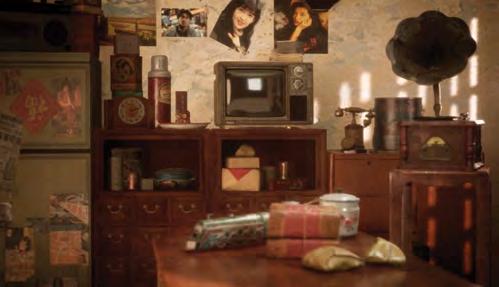
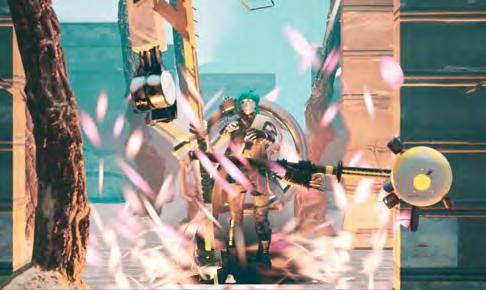
working in the field are also facing the influx of new tools. That never ends, even for professional people working in studios which are adopting new processes they’ll have to learn. And that’s OK.”
Questions raised by students are often provocative, and Mulvanerty cites as an example their conversation with people from The Foundry, marketer of Nuke. “There are lots of tools with Nuke that are neural networkbased — trained on artist data,” he says. “The students could raise ethical questions about that, and nobody shied away from answering!”
The “capstone” of an animation education at SCAD is, literally, a capstone film made in a student’s senior year. The fall semester is preproduction; the winter is production and the spring is devoted to postproduction. “The students have deliverables they have to hit each quarter,” says teacher John Webber, a SCAD professor since 2008 and associate chair of animation since 2017.
Webber describes this 20-student production class as “intense.” He says, “We have a pro-
cess where they pitch ideas for us to greenlight. At around Week Six, everyone must make a five-minute pitch of an idea for a three-minute film. Not one second over.” Then everybody votes on the two films that will be made by groups of 10. “We find that quality rises to the top.” (Although, he adds with a laugh, “Maybe we’ll have just one cat film this year?”)
As a Disney character animator for 10 years, Webber amassed credits that include Pocahontas, Mulan, Hercules and Lilo & Stitch “I was working around giants and trying to keep up,” he recalls. So, he knows the stress of creative competition firsthand.
Webber notes that students make small individual films along the way to their senior capstone project, but the drama begins when they must organize themselves into collaborative teams. Each student presents a PowerPoint that demonstrates their strongest work. “There’s always somebody who’s a fantastic compositor or lighter. Some are great using Blender, or they can program a bit. They have a week to recruit 10 people. They can’t just choose their friends. They have to find people with the right skill sets. It’s a scramble. Not every artist is great with every aspect of the pipeline, even at Disney.”
As the process unfolds, Webber has noticed that “students start training each other. Collaboration is huge.” When the process works well, as it did for the capstone class last year that produced the film, The Sun Is Bad. Webber believes it provides students with a mirror of what the industry is like. “The closer we can get to a studio model, the better,” he says.
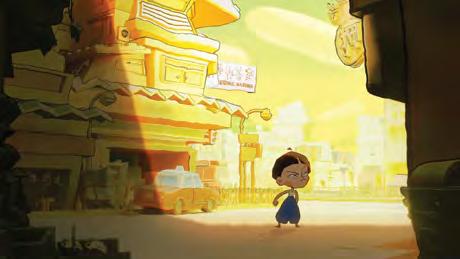
Webber’s students are keenly aware of how important this film is to their chances of attracting job recruiters. “There’s so much competition today that you can be a jack of all trades, but you’d better be a master at something!” adds Webber.
California Institute of the Arts, Valencia, California
Launching students from school to work is a challenge taken seriously at CalArts, where Professional Prep is a required course. Although recruiters have long been drawn to seeing student work at the college’s famed Producers’ Show, preparing the students to face the scrutiny of professionals is the focus of Dawn Yamazi, who’s taught at CalArts for over seven years. “It’s professional prep, so we’re talking business and getting ready for job interviews.”
“I teach third-year students,” she explains. “In their first two years, students are working on their craft. Their third year is when they start thinking about their professional ambitions. Most of them are focused on feature film work, so I highlight some of the trends that are happening.”
Of the 40 students in Yamazi’s current class, there probably isn’t a single one who’s unaware that Pixar’s “brain trust” began at CalArts, but today the waves of change have created a different professional landscape. As Yamazi observes, “The evolution of the industry is a reality they need to understand. Several companies that were steppingstones for

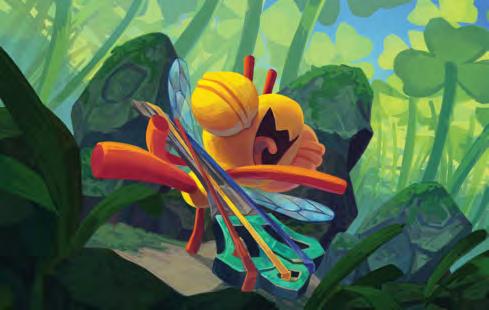
some graduates have dissolved over the past few years, like JibJab. Even four years ago, no one would have said they wanted to work at Netflix. Today, it’s a top choice.”

Another change is the influence of social media. “I noticed that prepandemic, my students knew everything. They didn’t know why they needed to be in my class. They had so much information from the web. But I think the pandemic did make a change. They’re eager to hear about the business today, because what they’re going into is very different.”
Yamazi sees today’s students as “internet savants,” and she gets them to focus on their social media presence. “What they’ve done with their Instagram or LinkedIn accounts prior to

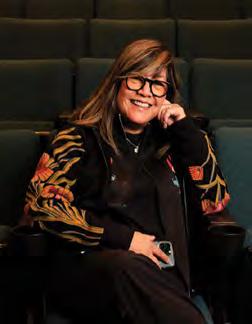
this moment may not be appropriate for the future,” she says.
In a collaborative field like animation, the ability to “play well with others” remains crucial, and Yamazi uses role-playing exercises to prep her students for the crucial interviews that lie ahead. “This industry is not very big. The person you’re sitting next to may be your boss in the future, or the person who gets you a job…or who beats you to a job! So don’t be a jerk. Even though there are brilliant jerks in our industry, don’t be one of them!” ◆
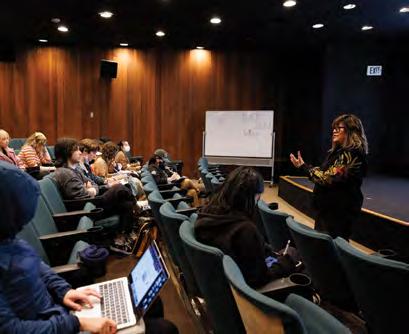
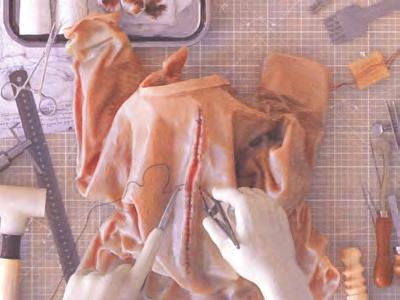

1. Drawing. If you think animation instruction is just learning software, you won’t get very far. Life drawing is the basis that all our technique comes from. When considering whom to hire from a pool of candidates, studios still usually go for the strongest artist. Very few of us are born with all those skills. We must work at it and build it up. Life drawing from the model, anatomy, etc. Go to the zoo and draw animals. When studios look at portfolios, they know your polished work may have used preexisting rigs, AI or hired hands to help. So, they look at the life drawing to see what a candidate can really do.
2. Make friends. The friends you make in animation class now will probably be your friends when you are old and gray. Companies will rise and fall, but these friends will always be there for you. Why? Because you shared the common experience of making a career out of animation. You know each other’s strengths and trust one another. Animation is a very social business; a lot of personal relationships. You are going to get more jobs from friends than applying through the front door or getting an agent. In the beginning George Lucas and John Lasseter hired their old schoolmates to help them.
3. Broaden your horizons. The common refrain I hear from many of my former students is, “I wish I had taken advantage of some other classes when I was there.” While in school, take some courses outside your comfort zone. Many great animation art directors and layout artists studied theater arts. Photography courses help you with your frame composition for storyboards. Sculpture helps you think of your characters in 3D space. Take courses in liveaction direction, cinematography screenwriting, editing, illustration.
4. Acting classes. Take a class in mime, in improv, etc. The art of animation is not just relying on a clever script or a well-delivered speech from a movie star. Good animators are actors. We used to say we are actors with a pencil. Now it’s with
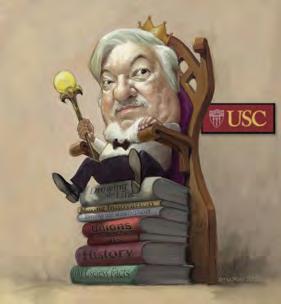
a stylus. Does your character stand on the balls of his feet or on his heels? Elbows out or elbows in? It’s not just about creating movement to the dialogue. Milt Kahl called his scenes a performance.
5. Experiment. School is your time to try things out. How good are you at stop motion? How about 3D rigging? Better to find out if you are good or bad at something now in school than out in the real world. I had a friend who went into college wanting to be a character animator and came out an effects animator. He retired a vfx supervisor on major movies.
6. Do at least one film project all by yourself Even if you already decided you want to be a concept artist or storyboard artist when you graduate, do a project where you complete all the tasks, from concept to final mix. It will give you an understanding of the challenges and difficulties of each job. Have you ever tried 3D modeling and rigging? I have. It’s not the kind of thing I prefer to do. But at least I understand it now. And when my modeler comes to me to explain why something isn’t ready yet, I can understand why. When I did my own college film, I was surprised at how many additional things I had to do even after the last frame was drawn and colored. Ralph Eggleston (1965-2022), who was the top art director-color stylist at Pixar, could write, direct and animate as well. He created his own short, For the Birds, while art directing other projects. It won an Oscar.
7. If the opportunity arises, be open to helping on a friend’s film. You’ll start to develop your professional discipline while working on someone else’s stuff; to adopt their style of drawing; to get things done on a deadline. All that will help you out in the cold, cruel world.
8. Stay on top of the newest technology. Most students
Top Left: Walt Disney sketches two 12-week-old fawns that were models for Bambi in 1938. Below: A young Tom Sito and Bugs Bunny pictured hard at work.
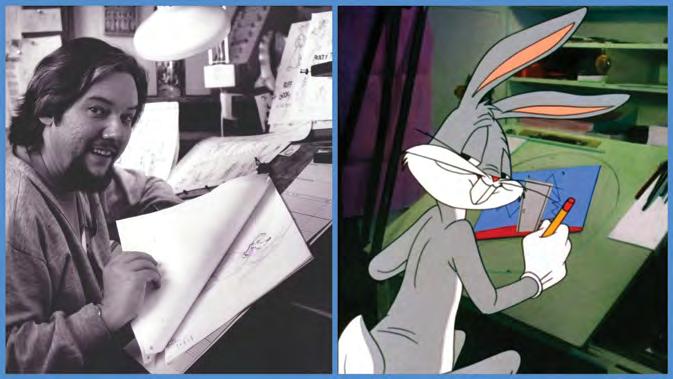
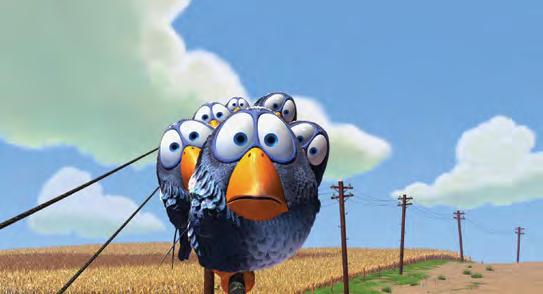
today are further along on this than their teachers.
9. Focus on your class work. It’s OK to start to freelance while finishing school, but don’t let it interfere with your studies. There will be plenty of time to get jobs. But you only go for a degree once (usually). I know professionals 30 years later who regret they didn’t finish and get their degree. One day you might want to teach, and many big universities won’t even consider a candidate without a graduate degree. I never considered teaching when I graduated 48 years ago. I just wanted to be an animator. Today, I am a full professor with tenure at a major university. Never say never.
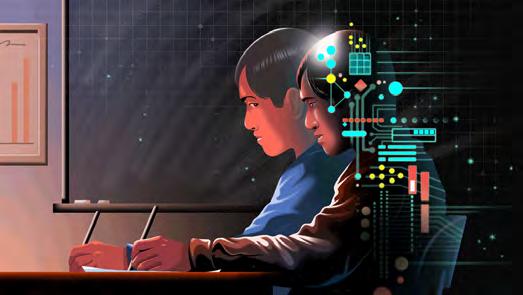
10. Take advantage of your schools’ placement services. Many studios have student internship programs. The studios go to the big schools first before taking someone off the street. A summer job at a studio is a great way to get your foot in the door. You gain practical experience and start to make contacts among the professional community. ◆
Tom Sito is an animation veteran, historian and professor at USC. His numerous animation credits include Who Framed Roger Rabbit , The Little Mermaid , Shrek , Aladdin , Beauty and the Beast , The Prince of Egypt and The Lion King .

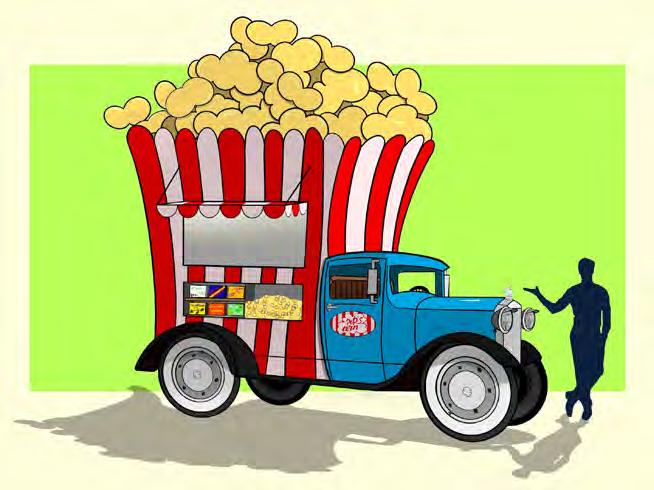
Animation concept by student Nick Shook
John Coven, director of the department of animated film at Gobelins Paris, answers a few questions about the French school’s prestigious program.
Gobelins Paris is known for offering one of the world’s most respected animation programs, which lists the likes of Pierre Coffin (Despicable Me), Bibo Bergeron (A Monster in Paris), Simon Otto (How to Train Your Dragon trilogy) and Pierre Perifel (The Bad Guys) as graduates. We had the chance to speak with the director of the school’s animation program, John Coven, who is a well-regarded storyboard artist and animation and vfx artist with a long list of credits including Chip ’n Dale: Rescue Rangers, The Lion King, Jurassic World, Venom, Logan, Captain America: Civil War and the original X-Men. Prior to Gobelins Paris, he taught filmmaking, storyboarding and entertainment design at such schools as the Art Center College of Design, the Otis College of Art and Design and the Animation Workshop. Here is what he told us:
Can you tell us a bit about your background and impressive work in animation?
Having graduated from art school in France, I returned to Los Angeles, where I grew up, and began storyboarding live-action feature films. I had always been interested in animation, but didn’t start working in animated film until many years later. Having boarded films ranging from The Usual Suspects to The Muppets on paper, I began drawing digitally while working on The Wolverine. I was absolutely amazed by what you could do drawing on a computer tablet. Suddenly, instead of isolated images, I could present my drawings to directors edited into rough animations. This led me to want to animate the characters’ performances and to have more input into the scenes I worked on. About that time, Hollywood started making more and more hybrid films, combining live action and animation. Because of my background in live action and my ability to storyboard animation, I became part of a relatively small group of artists working regularly on hybrid projects. They ranged from films like Jurassic World to Disney’s Alice Through the Looking Glass, The Little Mermaid and Jon Favreau’s The Lion King. Eventually, I became head of story on the upcoming Mufasa: The Lion King.
What drew you to this prestigious position at Gobelins Paris?
Along with filmmaking, I love teaching and, obviously, France. Gobelins Paris is a French school, but the animation program has become international. We teach almost exclusively in English and enroll students from 53 countries. The school came to me to help with this process of interna-
tionalization. Among other things, I work building bridges to animation studios abroad, notably in America. The level of student work, talent and dedication is amazing. So, really, I couldn’t be lending my hand to a better cause. And the campus is in the center of Paris. I live in the Latin Quarter and walk to school... not a bad life!
What was the transition like for you, from a studio professional in the U.S. to a top-ranking academic leader in France?
To tell the truth, this is the first real job I’ve ever had. I spent my entire working life as a freelance artist. As soon as I started a project, I could look ahead and see the end. This is very different. I have a home now and a cause to fight for. Of course, every movie is a cause to fight for too. But therein lies the real difference. Now I am fighting for students and faculty, whereas before I was fighting to help create a work of art. As far as the transition goes, after being at the school for three semesters I am still transitioning. I went to school in France, but never worked here. There is still a lot for me to learn.
What are your biggest challenges at the university?
The biggest challenge for us is the same as for most schools: money. Did I forget to say that another of my responsibilities is fundraising? I have been astounded to find that Hollywood studios often have the impression that Gobelins is an elitist French institution that does not need, or even necessarily want, their support. Nothing could be further from the truth. Through the years, our graduates have ended
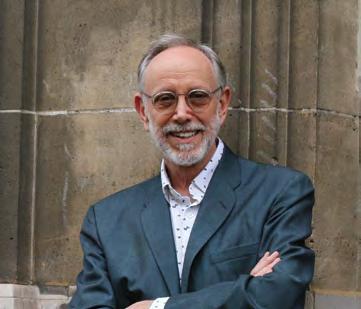
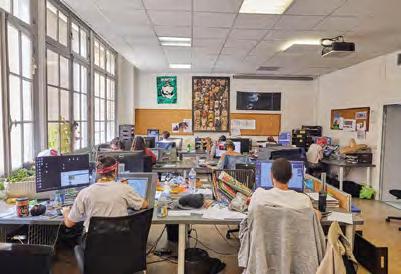
up working at all the major animation studios in America. I want to make it easier for the studios to find, and hire, the outstanding talent coming from Gobelins. I also want to alert the studios that the school and its students need their support in order to continue to flourish in these financially challenging times. This support will also help us promote diversity and inclusion and continue attracting top talent regardless of students’ financial background.
Why do you think Gobelins Paris is such a widely respected institution for animation studies?
Quite simply, the quality of the films our students produce. Now I have to brag a little: Our students’ thesis films have been nominated for the Annie Award for Best Student Film six times in the past five years and won three times... in five years! Gobelins’ films also screen in countless festivals each year and win prizes all over the world. Most importantly, anyone interested in studying animation, or hiring our graduates, can watch the films on our YouTube channel.

Clockwise from top left: Gobelins graduates Yi Liu, Mehrnaz Abdollahinia, Razahk Issaka, Feben Elias and Celeste Jamneck’s The Soloist won the Annie for Best Student Short in 2023. Below: Murales 2023 Annecy spot by Naomi Escoute, Laora Le Bouriscot Bouriscot, Masha Moran, Mia Popovic-Beaume, Yosi Hsu and Lava Hijzelaar. 2024 Annie-nominated short The Human Quest by Mélina Lenco, Lucie Juric, Caroline Leibel, Faustine Merle and Claire Pellet.

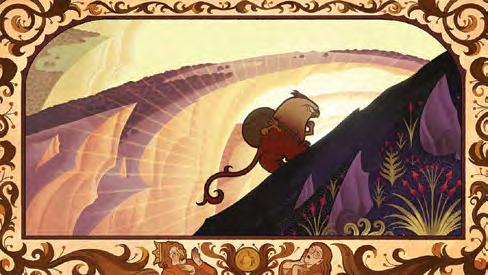
Some of our student films have more than 10 million views. So young people everywhere can see the quality of education we offer, and studios know that, in a very real sense, we work on their behalf as both talent scout and incubator.
What makes it stand out from similar colleges in the U.S.?
There are a number of great animation schools in the U.S. Gobelins has student-exchange programs with several of them. Some schools in the U.S. have teaching strategies that are similar to Gobelins, some not. Groupbased learning is very important to our way of teaching. We teach in modules of varying lengths, rather than semester-long courses. Each module ends with the creation of a project. Students work in groups on virtually all these projects. This way, they learn to work with others, to compromise and often to set aside their egos — important skills in animation. The graduate-level thesis films are made by groups of five or six students. This has the added benefit of ensuring that each film has the labor force needed to achieve the level of excellence associated with Gobelins.
What do you love about your job?
There are so many things to love. Above all, working with the students and our amazing staff. Did I forget to mention that my responsibilities in-
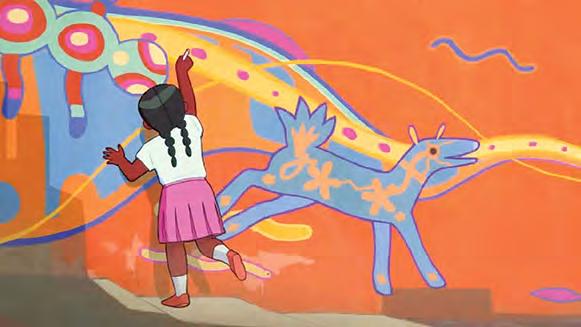
clude teaching? Your readers probably know that Gobelins’ students make 30-second shorts that play at the beginning of each screening at the Annecy Film Festival. I am lucky enough to get to work with both the undergraduate students on their Annecy films, and the graduate-level students on their thesis films. I help them craft their scripts, storyboards and animatics.
What kind of advice do you offer students who want to excel in the animation world?
It depends on their interests. One great thing about animation is that it involves so many different crafts and skills. For our bachelor’s program in Paris, we look for students whose drawings show an understanding of anatomy, movement and perspective. These skills prepare students to learn 2D animation, visual development, character design and storyboarding. People who love animation, but not drawing, can become 3D animators. We have opened a campus in Annecy, in the French Alps, to train 3D animators. We also offer degree courses in Paris in producing animation and visual storytelling. Luckily, there’s no one way to excel in animation.
What is your take on the global animation scene today?
I am hardly an expert, but it seems everyone agrees we are currently experiencing a slump
in the industry due to a range of factors. At the same time, a lot of people seem to think things are going to pick up soon. While I am usually skeptical about predicting the future, there is one thing I do feel pretty certain about: AI is going to have an impact on our industry. Did I mention that my responsibilities include the ongoing development of our curriculum? Among other things, we are working on how to teach the ethical use of AI to our students.
I’m sure many English-speaking students are curious about what it takes to become a student at Gobelins Paris. What would you tell them?
Again, it depends on the student’s interest. The name Gobelins is no longer simply synonymous with 2D animation. Students wishing to study 3D animation don’t need the kind of drawing skills required for our 2D degree programs. Those who wish to enter the graduate program, Master of Arts in character animation and animated film directing, must have studied animation already and/or worked professionally. Those wishing to enter the undergraduate 2D animation program need solid drawing skills. Draw, draw, draw! And remember that all our animation degree programs are now international. You don’t need to speak French! ◆
For more info, visit gobelins-school.com.
Founded in 1861, Orange, Calif.-based Chapman University specializes in offering a personalized education to each of its students. The top-ranking school offers VFX, 2D animation and CG animation tracks, which are part of the world-renowned Dodge College of Film and Media Arts, the No. 4 ranked film school in the country.
As Ruth Daly, Chapman’s director of animation and VFX explains, “Technology and creativity blend seamlessly here as industry standard 3D and 2D animation software is taught alongside art, writing, pitching and filmmaking fundamentals. Our students share classes and projects with film, computer science, producing and screenwriting majors, just to name a few.”
Among the many unique events and student experiences that make Chapman’s offering stand out is the fact that legendary animation directors teach on campus in small groups every week. “Oscar-winning director Brenda Chapman (Brave, The Prince of Egypt), Emmy Award winner Lauren Faust (My Little Pony, DC Super Hero Girls) and two-time Oscar nominee John Musker (Moana, Aladdin, The Little Mermaid) are current mentors in the Pankey Distinguished Artist program at Dodge, instructing senior students for a total of nine hours per week throughout the 2023-24 academic year,” Daly points out. “What really sets us apart is the opportunity for in-depth one-onone tutoring over an extended period with a legendary director who students may only have dreamed of meeting. Lauren, John and Brenda bring the highest caliber of instruction we could ever hope to offer our students.”
In addition, the animation and VFX faculty includes: Chris Bailey, Academy Award-nominated animator and producer (Runaway Brain); Alireza Bidar, animator (Raya and the Last Dragon, Encanto) and Houdini instructor; Graham Cunningham, veteran Blizzard lighter/compositor; Ruth Daly, program director and veteran 2D and 3D animator (The Iron Giant, Night at the Museum, The Golden Compass); David Kuhn, veteran animator (Pocahontas, Hercules, Looney Tunes: Back in Action); John Perez, storyboard artist (South Park) and USC screenwriting fellow; and Jim Schlenker, veteran layout artist, Disney TV.


In 2021, Chapman University became the first university in the United States to open a virtual production facility. With classes in virtual production, VR/AR, motion capture and the integration of machine learning, students are immersed in a fast-paced, challenging and deeply collaborative setting. Seniors work in small groups on thesis films to share their specialized skills and support each other both technically and creatively, accomplishing much more than they could on solo projects, with less burnout.
“Our students also collaborate on larger projects with Dodge film majors, shooting on our virtual production stage, and crafting postproduction VFX, a unique experience that not many programs offer,”
says Daly. “Two such film projects were just completed, an eight-month collaboration between approximately 50 students studying cinematography, directing, animation, VFX and production design.”
Location, Location, Location
The Digital Media Arts Center (DMAC), a gorgeous, modern, award-winning building, is home to the animation and VFX program at Chapman, which is in the heart of downtown Orange. The university is adjacent to Orange County’s gaming industry, just 10 minutes away from Disneyland and an hour away from Hollywood. Studio tours, internship opportunities and world-renowned experts are all close by.
In addition, Chapman provides academic credit for internships and the Dodge Career Center offers both job placement support and career advice in cooperation with animation faculty. Students are regularly chosen as interns at DreamWorks Animation; several 2023 graduates also landed jobs there. Other recent internship opportunities have included those at the Academy of Motion Pictures Arts and Sciences, Blizzard, Nickelodeon and NBC Universal. Class of 2023 graduates were also hired by The Third Floor, Nickelodeon and Titmouse.
Among Chapman’s most popular recent animaton and VFX courses are:
• Caricaturing for Animation with John Musker: Create caricatures with an animation legend!
• Pitching and Showrunning with Lauren Faust: Faust coaches as our students pitch their original IPs.
• Simulations for VFX: A dedicated Houdini class where students can conjure fire and floods along with simulations of large environments, crowds, hair, cloth and more.
• Unreal Engine for Filmmakers: Game engine technology with film and animation students together on a virtual production stage.
• Writing for Animation: This class brings screenwriting and animation students together, a collaboration not offered in many animation programs.
• Summer travel courses: This year, students will travel to Paris to participate in a visual storytelling course at the renowned Gobelins, the world’s leading school for animation. ◆
For more info, visit www.chapman.edu/dodge
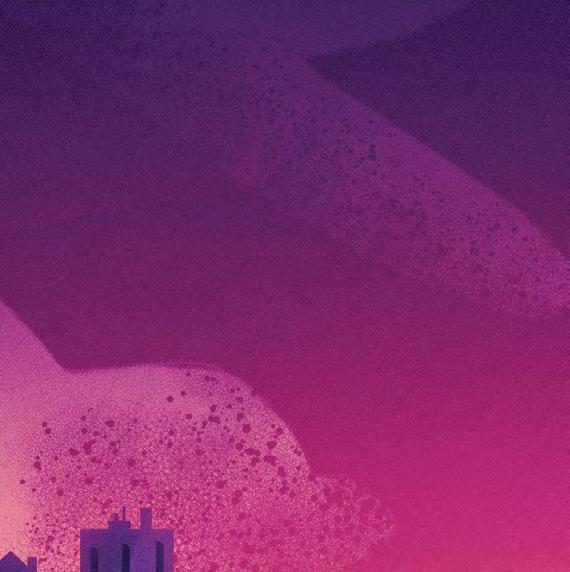
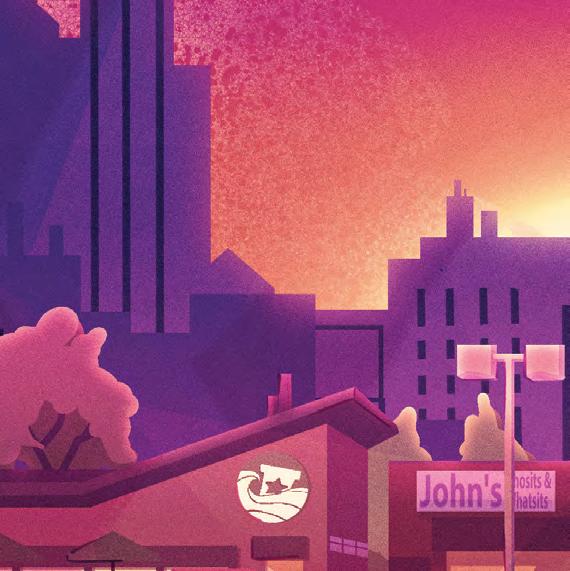






















f you have ever considered getting a handson education in animation and visual effects in the heart of Los Angeles, you should consider The L.A. Film School’s rich programs. Kenneth Norman, animation and vfx program specialist and Bre Roberts, program manager of the animation online program at The Los Angeles Film School, answered a few of our questions about their school:
Can you tell us a bit about The L.A. Film School’s Current Animation and VFX offerings.
We offer four animation concentrations at The Los Angeles Film School. On our Hollywood campus, we provide Visual Effects and Game Art. We offer Character Animation, Environment and Character Design, and Visual Effects for our online students.
What makes the concentrations stand out from other similar fare?
Our Animation degree has some unique features that set it apart from others. First, our faculty members have at least four years of experience working in the animation industry, making them a valuable asset to our program. Many faculty members maintain active employment within the industry while teaching, allowing them to bring our students the most up-to-date learning experience. Second, our curriculum is designed based on the pipelines currently used in the animation industry. Our program’s design is another unique feature as we begin with a flipped curriculum for online concentrations, emphasizing the quality of the final output. Initially, we focus on camera, composition, and rendering using production-quality assets to build confidence, give students a better understanding of the high-quality assets they should aim to produce, and demonstrate their ability to create such assets.
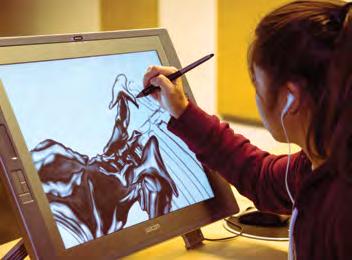

What are some of the most popular classes in your program?
Courses where students have the most artistic freedom to explore their ideas are the most popular. Story-driven animation, Crowd Animation, Visual Effects for Games and Film, and Character Design are among our students’ most popular courses in our animation degree program. Students love opportunities to bring their own stories to life.
What are the most important skill sets that will be taught in your program?
The Los Angeles Film School’s Animation concentrations aim to equip students with diverse skills to succeed in the animation industry. Here are some key skill sets commonly taught in animation concentration programs:
Animation Principles: Understanding the core twelve principles of animation and how to implement them into 3D animation.
Character Design: Creating visually appealing and unique characters that fit within the context of the animation project.
3D Modeling and Animation: Utilizing industrystandard software for creating 3D models and animating characters and scenes.
Visual Effects (VFX): Incorporating visual effects into animations or live-action films to enhance the overall visual appeal.
Rigging: Understanding the process of creating skeletons and controls for 3D character models, enabling realistic movement.
Texturing and Lighting: Learning to apply textures to 3D models and effectively use lighting to enhance the visual quality of animations.
Industry Software Proficiency: Becoming proficient in industry-standard animation software such as Autodesk Maya and Unreal Engine.
Portfolio Development: Crafting a strong portfolio showcasing various final projects and demonstrating proficiency in the student’s chosen career interests and styles.
Professional Development: Understanding the business aspects of the animation industry, including networking, job searching, and staying updated on industry trends.
What kind of advice would you offer prospective students who want to enroll in your program?
Your well-being should always come first. Trying to learn something new without a balanced lifestyle can significantly impact your concentration and health. Your mind and body need nourishment, sleep, and emotional support to absorb new learning content effectively. Our student advising team is available when life inevitably happens during our students’ 36-month experience within The Los Angeles Film School.
The key to learning is to communicate appropriately and be open-minded. Most students come from a standardized learning background where they complete a project, accept the grade, and don’t necessarily follow up on what they could have done better. They should think of college as more of a mentorship and push to understand the relevance behind what they are learning and how it aids them in their goals.
Find an organizational and time management paradigm that works for you. Set a particular time and place to work in your home. Understand you’re not perfect, and we all slip up. Learn from

it, course correct, and rebalance your time. Remember, every person you meet is an opportunity to connect and network. We offer multiple community events on campus and online, including game nights, seminars, and art jam sessions. Surrounding yourself with people who have similar interests will keep your motivation and engagement high. These connections could help you find opportunities after graduation as well. ◆
For more info, visit www.lafilm.edu

3D Training Institute
New York, NY, U.S.A.
3dtraining.com
Email: info@3dtraining.com
Academy of Animated Art New York, NY, USA (Virtual-Online) academyofanimatedart.com
Email: info@academyofanimatedart.com
Degrees/Certificates offered: Course
Completion Certificate
Number of students in animation program:
200
Cost of program: $1999
Head of animation: Jasmine Katatikarn (jasmine@academyofanimatedart.com)
Head of admissions: Jasmine Katatikarn (jasmine@academyofanimatedart.com)
Time of year offered: year-round
Application deadline: rolling enrollment
Animation Apprentice London, U.K. animationapprentice.org
Email: info@animationapprentice.org
Animation Mentor Emeryville, CA, U.S.A. animationmentor.com
Phone: +1 877 326 4628
Email: admissions@animationmentor.com
Animation Resources Pacoima, CA, U.S.A. animationresources.org
Email: sworth@animationresources.org
AnimSchool Provo, UT, U.S.A. animschool.edu
Phone: 801 765 7677
Email: admissions@animschool.edu
Degrees/Certificates offered: 3D Animation Certificate Program, 3D Character Certificate Program
Number of students in animation program: ~500
Cost of program: $1,620 per term
Head of animation: Manuel Bover
Head of admissions: Joshua Little
Time of year offered: Quarterly
Application deadline: Last week of March, June, September and December.
CG Master Academy (CGMA)
Online Worldwide cgmasteracademy.com
Phone: +1 800 959 0316
Email: registration@cgmwonline.com
CG Spectrum Online Worldwide cgspectrum.com
Email: admissions@cgspectrum.com
Degrees/Certificates offered: Beginner, intermediate and advanced certificates in: 2D animation, 3D animation, 3D modeling, game art, concept art, digital illustration, game design, game programming, VFX compositing, FX & simulation, real-time 3D & virtual production, and architectural visualization.
Number of students in animation program:
200
Cost of program: $7,999
Head of animation: Scott Claus
Head of admissions: Elena Zavitsanos
Time of year offered: Monthly intakes
Application deadline: The 25th of each month
Equipment available: All software is included. Courses are held entirely online, so students
are responsible for their own hardware.
Notes: CG Spectrum is a global top-ranked training provider for the film, game and creative industries. Offering specialized programs and personalized mentorship from industry professionals, CG Spectrum trains individuals and supports major studios with upskilling their teams. All programs are 100% online and offered worldwide. CG Spectrum is an Unreal Authorized Training Center, Unreal Academic Partner, Unreal Connector, SideFX
Certified Training Provider and Toon Boom
Authorized Training Center.
CGTarian Animation & VFX
Online School Vilnius, Lithuania cgtarian.com
Phone: +370 65 905 905
Email: info@cgtarian.com
The Happy Producers Canada thehappyproducers.com
Email: lp@thehappyproducers.com
Degrees/Certificates offered: Production Coordinators course, Production Management and Line Production course, Scheduling course
Number of students in animation program:
Unlimited
Cost of program: From $1,444 USD
Head of admissions: Virginie Lavallee
Time of year offered: Year-round
Application deadline: None
Equipment available: One year access to our pre-recorded programs, access to monthly Q&A session, one hour of coaching one-on-one, downloadable workbooks.
Notes: The Happy Producers provide training and coaching solutions that promote wellbeing in animation production. As animation producers with over 20 years of experience in the industry, we know how challenging it is to provide training and support while leading a full-time production! But we also know firsthand how important training and growth are to our team’s productivity, motivation and efficiency.
That’s why we created e-Courses and tools to teach coordinators, project managers, line producers, and team leads the mindset and skillset for everyday low-stress, high-efficiency film and television animation production.
Silver Drawing Academy
Los Angeles, CA, U.S.A. (Online)
silverdrawingacademy.com
Email: info@silverdrawingacademy.com
Degrees/Certificates offered: N/A
Number of students in animation program:
unlimited
Cost of program: $299 for the year
Head of animation: Stephen Silver
Head of admissions: Stephen Silver
Time of year offered: Year round
Application deadline: No deadline unless signing up for specific 8 week Character Design course with one on one feedback from Stephen Silver
Studio Arts
Los Angeles, CA, U.S.A.
studioarts.com
Phone: (323) 227 8776
Email: office@studioarts.com
VANAS Burnaby, BC, Canada (Live Online & Combined) Blaine, WA, U.S.A. (Live Online) vanas.ca
Phone: +1 833-437-3872
Email: info@vanas.ca
Degrees/Certificates offered: 2D Computer Animation Diploma, 3D Computer Animation
Diploma, Advanced 3D Modeling Diploma, Animated Short Films Diploma, Concept Art Diploma, Digital Matte Painting Diploma, Effects Animation Diploma, Esports Diploma, Video Game Design Diploma, Virtual Reality Design Diploma; Digital Entertainment Art Foundations, Digital Entertainment Technology Foundations, Introduction to Digital Arts, Professional Career Development, Writing for Animation Canada.
Number of students in animation program: Eight per class
Cost of program: $18,500
Head of animation: Calvin Leduc
Head of admissions: Sonia Bolduc
Time of year offered: Winter, Spring, Summer, Fall
Application deadline: 10 days before session starts
Equipment available: Students are responsible for supplying their own computer software and hardware. Academic discounts are available to our students.
Vertex School Austin, TX, U.S.A. vertexschool.com
Email: admissions@vertexschool.com
Visual Arts Passage Online visualartspassage.com
Phone: (323) 366-7053
Email: hello@visualartspassage.com
Academy of Animated Art New York, NY academyofanimatedart.com
Email: headmasters@academyofanimatedart. com
Academy of Art University San Francisco, CA, USA academyart.edu/
Phone: 1-800-544-2787
Email:admissions@academy.edu
Degrees/Certificates offered: Animation & Visual Effects
-AA - BFA - MA - MFA - CERT
Number of students in animation program: 944
Cost of program: https://www.academyart. edu/finances/cost-of-attendance/
Head of animation: Catherine Tate
Head of admissions: Jeremy Confer
Time of year offered: Fall, Spring, Summer
Academy of Interactive Entertainment Lafayette, LA & Seattle, WA Aie.edu
Email: lafayette@aie.edu, seattle@aie.edu
Phone: (206) 428-6350
FAX: (206) 428-6354
The Animation Academy Burbank, CA theanimationacademy.com
Email: theanimationacademy@gmail.com
ArtCenter College of Design Pasadena, CA, USA artcenter.edu
Phone: (626) 396 2373
Email: admissions@artcenter.edu
Degrees/Certificates offered: Bachelor of Science in Entertainment Design (Animation,
Concept Design, Game Design). Bachelor of Fine Arts in Illustration
Number of students in animation program: 200
Cost of program: Undergraduate (two term)
Tuition: $50,606 per year
Head of animation: Paul Taylor
Head of admissions: Tom Stern
Time of year offered: Fall and Spring
Application deadline: Fall Term: February 1, Spring Term: October 1
Equipment available: Software: Maya, Adobe Suite, Substance Designer, Blender, Marvelous Designer, ZBrush, Toon Boom Harmony, Toon Boom Storyboard Pro, Dragonflame, Perforce, Unreal Engine, Unity.
Facilities: Eight fully equipped computer labs outfitted with Cintiqs (150+ workstations). Dedicated stop-motion room, Rokoko motioncapture suit and dedicated capture studio, game room, Immersion Lab with the latest in AR/VR technology including HTC Vives, Oculus Rifts, Oculus Quests, Microsoft HoloLens and Mixed Reality headsets, 360 cameras, Leap Motions and mobile motion-capture suits. Extensive maker-oriented labs offering the latest professional equipment required to complete projects in 3D printing, woodworking, metal fabrication, vacuum forming, plastic sheet fabrication, fiberglass and composite fabrication.
Notes: Come to the entertainment capital of the world and learn how to combine theory with real-world practice using industry standard software, pipelines and techniques. Our faculty are working professionals from the AAA movie, animation and gaming industries. Learn from talented peers as you strengthen your design, aesthetic and teamwork skills. Collaborate with students across multiple programs at ArtCenter including Animation, Illustration, Game and Concept Design to make entertaining, personal and socially relevant art, games and animated short stories. Faculty and former students have gone on to work for industry giants such as Disney, Dreamworks, ILM, Sony, Insomniac Games, Riot Games, Warner Brothers, Marvel, Aardman, Nickelodeon, Fox Pictures, LAIKA, Universal, Blur Studio, Blizzard, Sony Santa Monica Studio and many others.
Austin Peay State University Clarksville, TN apsu.edu/art-design
Email: art@apsu.edu
Degrees/Certificates offered: BFA Art concentration in Animation + Visual Effects Number of students in animation program: 75 Cost of program: $8,790 per year in-state, $14,358 per year out-of-state
Head of animation: Scott Raymond
Time of year offered: Fall/Spring
Application deadline: Rolling application for Fall/Spring. https://www.apsu.edu/admissions/ Equipment available: Animation + Visual Effects has a dedicated Mac computer lab with access to Autodesk Maya, Adobe Creative Cloud, Toon Boom Harmony, Dragonframe, and The Foundry’s Nuke, Mari, and Modo. The lab is a versatile space that also includes a green screen wall and Cintiq Pro workstations. Additional lab equipment includes five Rokoko motion capture suits, Oculus Quest VR headsets, Dragonframe keypads, a DJI drone, and filming/lighting equipment. The department also manages The Vault, where students can check out equipment for personal use such as Wacom Intuos Pro tablets, Cintiq Companion tablets, portable green screen and lighting equipment, smartphone Stedicams, projectors, DSLRs, and audio recording equipment. The department MakerSpace features additional equipment such as a CNC
router, laser etcher, and MakerBot 3D printers.
Notes: In Fall of 2017 the department moved into a new $21.3 million dollar, 46,000 square feet Art + Design Building, featuring custom studio space for all the concentrations. With the help of The Center of Excellence in the Creative Arts, we are able to bring in industry professionals each year to meet with students and classes.
The Bakshi School
Silver City, NM thebakshischool.com
Phone: (575) 534 9291
Email: info@thebakshischool.com
Bloomfield College Bloomfield, NJ bloomfield.edu
Phone: (973) 748 9000
Email: admissions@bloomfield.edu
Bowie State University Bowie, MD bowiestate.edu
Phone: (301) 860-4000 / 1-877-77-BOWIE
Email: webmaster@bowiestate.edu
Bowling Green State University School of Art Bowling Green, OH www.bgsu.edu/
Phone: (419) 372 2231
Fax: (419) 372 2544
Email: artschool@bgsu.edu
Degrees/Certificates offered: BA in Digital Arts, BFA in Digital Arts, MFA in Digital Arts, Minor in Digital Arts
Number of students in animation program:
213
Cost of program: $13,125
Head of animation: Bart Woodstrup
Head of admissions: choosebgsu@bgsu.edu
Time of year offered: Traditional academic year (Sept. - May)
Application deadline: July 15
Equipment available: Three 20-seat computer
labs: One PC-based 20-core/32GB/Nvidia
Quatro p5000 3D animation lab, one PC-based 18-core/32GB/Nvidia Quatro k5000 imaging/ illustration lab with 22” 4k Cintiq tablets at each seat, and one Mac-based 12-core/32GB/ AMD Duel AMD FirePro D700 video lab. Stop-motion animation studio with 10 iMacs running Dragonframe, equipped to teach sand, paint on glass, puppet, cut paper, object, pixilation, rotoscoping, hand-drawn, clay and mixed-media animation.
Software: Autodesk Maya, 3DS Max, MotionBuilder, ZBrush, Mudbox, Adobe Creative Suite with Sapphire Plugins, Corel Painter, Unity 3D, Processing and Dragonframe.
Production Studio equipped with pro level lighting (Flash Packs, LEDs, Softbox Lighting and a small infinity Wall).
Students have access to the staffed Media Center which provides professional audio and video recording equipment (DSLR cameras, HD camcorders, omnidirectional camera and light kits), large-format printing, and VR/AR gear. Students also have access to the integrated fabrication studio with a plotter, multiple (6-8) 3D printers, a CNC router, a CNC plasma cutter and two Laser cutters.
Brigham Young University Provo, UT animation.byu.edu designdept.byu.edu/ animation
Phone: 801 422 4636
Email: designdepartment@byu.edu
Degrees/Certificates offered: BFA in Animation, BS Computer Science with an Animation Emphasis
Number of students in animation program: 80
Cost of program: $6,500 a year for LDS students, $14,000 a year for Non-LDS students
Head of animation/admissions: Sam Nielson
Time of year offered: Fall Semester
Application deadline: June 1
Equipment available: Four labs of 20+ workstation grade machines with Cintiqs, Unreal Engine, Maya, Houdini, Nuke, ZBrush, Toon Boom Harmony and Storyboard Pro, TVPaint, Adobe suite of products.
California College of the Arts
San Francisco & Oakland, CA cca.edu
Phone: 800 447 1ART [1278]
Email: info@cca.edu
California Institute of the Arts
Valencia, CA calarts.edu
Phone: (661) 255 1050
Fax: (661) 253 7710
Email: admissions@calarts.edu
California State University Fullerton Fullerton, CA fullerton.edu/arts/art
Phone: (657) 278 3471
California State University Long Beach Long Beach, CA csulb.edu
Phone: (562) 985-4111
California State University Northridge Northridge, CA csun.edu
Phone: (818) 677 1200
Email: admissions.records@csun.edu
Cañada College
Redwood City, California, USA canadacollege.edu/digitalartanimation
Phone: 650 306 3330
Email: naasp@smccd.edu
Degrees/Certificates offered: AA: Digital Art & Animation, AA: 3D Animation and Video Game Art, Certificate of Achievement Digital Art & Animation, Certificate of 3D Animation & Video Game Art
Design Number of students in animation program: Over 200
Cost of program: Degree/Certificate students: Free. Lifelong learners/skill builders: $50/unit
Head of animation: Paul Naas
Head of admissions: Hyla Lacefield
Time of year offered: Fall and Spring
Application deadline: Students can enroll up to the first class meeting, and can join with instructor permission once classes begin.
Equipment available: Three fully-equipped studios: PC and Mac (digital art studio), Mac (3D studio), traditional animation desks with digital shooting stations (traditional animation studio).
● Wacom Cintiq and Intuos Pro tablets
● Neat Boards for online synchronous classes
● Oculus VR equipment
● Software: Maya, Adobe Suite, Toon Boom Harmony, Rough Animator
Notes: The Cañada College Digital Art & Animation program provides a cost-effective, professional level of training to its students. All faculty are industry-experienced, working at studios like Disney, PDI/DreamWorks and Maxis.
Our alumni have landed jobs at Disney Television Animation and DreamWorks, Apple, Zynga, Sony Gaming, Big Fish Games and Agora, to name a few.
Student artists have won local and national awards for their work and have had their short films screened at the Cannes Film Festival
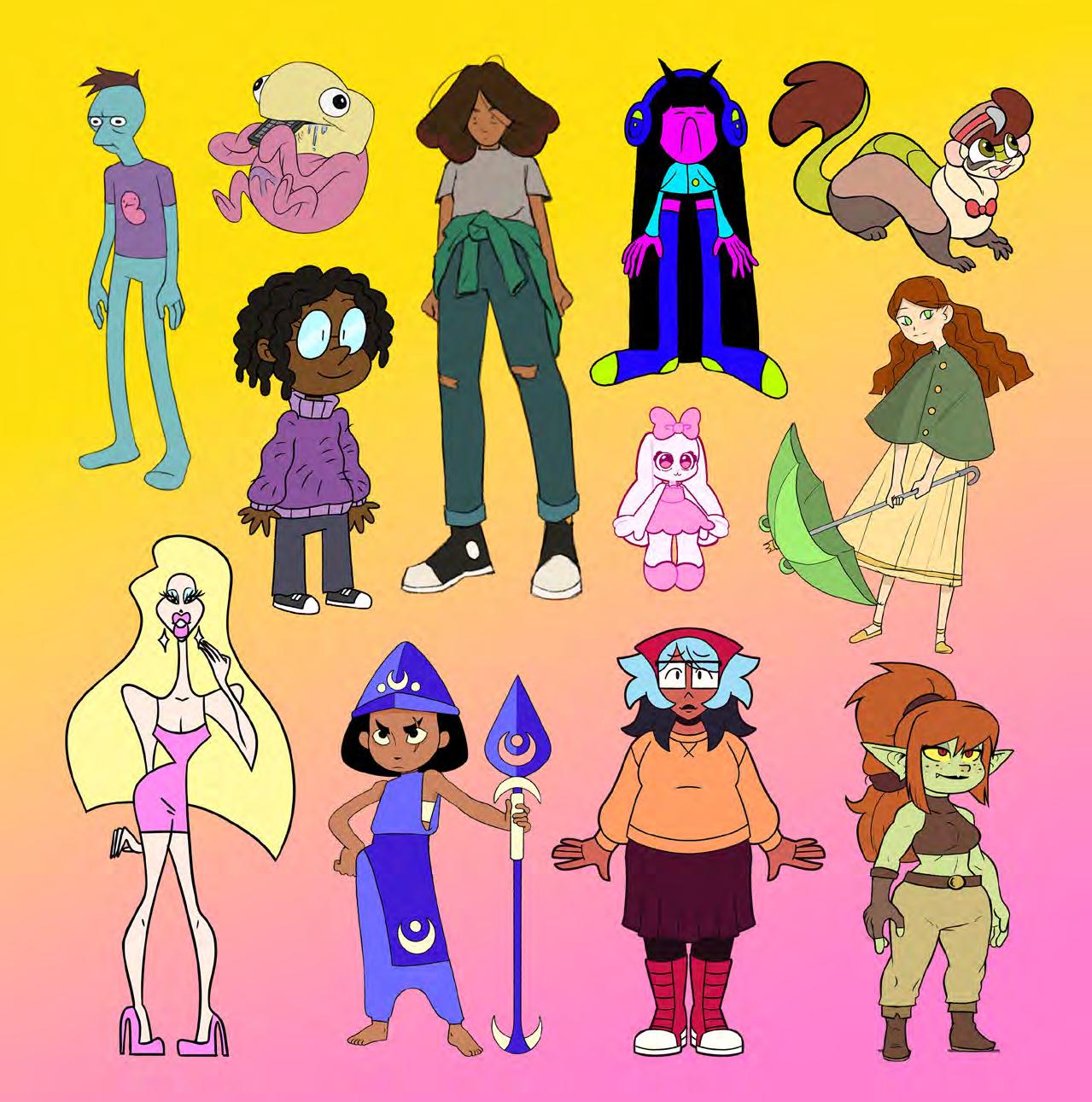
So does developing resilience, curiosity, empathy, a sense of authorship, and the ability to communicate through storytelling. Our rigorous BFA animation coursework advances the whole student while they study, collaborate, and play. Students graduate with the 21st century
skills that they need to pursue their goals, and the confidence of seeing the wide applications for those same skills open up new opportunities before them. Indeed, we’re not just drawing cartoon characters here, (but we do a lot of that too).
Current Student Artwork: uarts.edu
several years in a row.
Cañada College: From here, you can go anywhere!
Chapman University
Dodge College of Film & Media Arts Orange, California, USA chapman.edu/dodge
Phone: (714) 997 6765
Email: dodgecollege@chapman.edu
Degrees/Certificates offered: Animation and Visual Effects BFA
Number of students in animation program:
125
Cost of program: $64,580 per year
Head of animation: Ruth Daly, Director of Animation and VFX
Head of admissions: Priscilla Campos, Director of Admissions
Time of year offered: Fall start
Application deadline: At this time, there are no deadlines. The school currently operates on a first come first serve
Equipment available: A virtual production stage with LED wall; labs that are open 24 hours a day with Adobe Suite, Nuke, Unreal Engine, Maya, Blender, Houdini, Zbrush and Substance Suite
Clemson University
Digital Production Arts Clemson & Charleston, SC clemson.edu/dpa
Email: dpa@clemson.edu
Cleveland Institute of Art Cleveland, OH
cia.edu
Phone: (216) 421 7418
College of DuPage Glen Ellyn, IL
cod.edu
Phone: (630) 942 2800 (Main); (630) 942
3000 (Student Services)
Email: campuscentral@cod.edu
Columbia College Chicago Interactive Arts and Media Chicago, IL colum.edu/iam
Phone: (312) 369 7750
Email: admissions@colum.edu
Degrees/Certificates offered: Animation (BA), Computer Animation (BA and BFA), Game Art (BA), Game Design (BA), User Experience and Interaction Design (BA), Programming (BA and BS), Traditional Animation (BA and BFA)
Number of students in animation program:
320
Cost of program: Columbia’s tuition and fees — $31,026 for ‘22-’23 — are among the most affordable of all private arts and media colleges in the nation.
Head of animation: Joseph Cancellaro
Head of admissions: admissions@colum.edu. (Undergraduate); gradstudy@colum.edu. (Graduate)
Time of year offered: Students typically begin in the fall semester, but may be able to start in the spring or summer semester as well.
Application deadline: Apply by Wednesday, March 29, 2023, to receive an admissions decision prior to May 1.
Equipment available: Wacom tablets, computer towers, Stop-Motion Lab, Maquettes Lab Columbus College of Art & Design Columbus, OH
ccad.edu
Phone: (614) 224-9101
Email: admissions@ccad.edu
Daemen University Amherst, NY USA
daemen.edu
Phone: 800-462-7652
Fax: (716) 839 - 8229
Email: admissions@daemen.edu
Degrees/Certificates offered: BFA in Animation
Number of students in animation program: 86
Cost of program: $31,000 per year
Head of animation: Mike Jones
Head of admissions: Megan Beardi
Time of year offered: First year Fall; Transfer Fall and Spring
Application deadline: Rolling admission
Equipment available: Three state-of-the-art animation labs running Maya, Harmony, Storyboard Pro, etc. All lab workstations have 16” Cintiqs. The senior lab has 17 workstations with 22” Cintiqs. Traditional 2D animation desks lab. Plus a greenscreen room, sound lab, stop-motion lab and a 60 seat screening room. Industry based instructors with over 65 years of professional experience.
Notes: A number of Daemen University graduates are working for major animation studios throughout the United States.
The DAVE School -The Digital Animation & Visual Effects School Orlando, FL dave.nuc.edu
Phone: (407) 385-1100; (407) 449-0346
Email: admissions@daveschool.com
Degrees/Certificates offered: Game Production Diploma Program
The Game Production diploma program is designed to give each student practical exposure to complete each of the major disciplines needed for game art content creation. This includes games produced by both major game studios working on AAA titles and independent production houses working on mobile gaming and other applications. Students will learn the proper tools and techniques used by industry professionals.
Visual Effects Diploma Program
The Visual Effects Production diploma program gives students a broad range of skills which allows them to pursue jobs in the computer graphics industry, including feature film and television effects, game art, print advertising, architectural visualization and military simulation.
Virtual Production Diploma Program
Include both Game Production and Visual Effects Productions Diplomas
Number of students in animation program: 100
Delaware College of Art and Design
Wilmington, DE dcad.edu
Phone: (302) 622 8000
Fax: (302) 622 8870
Email: info@dcad.edu
DePaul University
Jarvis College of Computing and Digital Media Chicago, IL cdm.depaul.edu
Phone: (312) 362 8381
Email: admission@cdm.depaul.edu
DigiPen Institute of Technology Redmond, WA digipen.edu
Phone: (866) 478 5236
Text: (425) 414 3633
Email: outreach@digipen.edu
Drexel University Philadelphia, PA drexel.edu
Phone: (215) 895 2000; 800 2 DREXEL [373935]
Email: enroll@drexel.edu
East Los Angeles College Monterey Park, CA elac.edu
Phone: (323) 265 8650
Elite Animation Academy Orlando, FL eliteanimationacademy.com
Phone: (407) 459 7959
Email: twest@eliteanimationacademy.com
Emile Cohl Atelier Los Angeles, CA cohl.art
Phone: (323) 315 2323
Email: contact@cohl.art
Degrees/Certificates offered: MFA
Number of students in animation program: 17-30
Cost of program: $44,305 (First-Year Tuition and Fees)
www.animationmagazine.net
Head of animation: Sheila M. Sofian
Head of admissions: Neelam Savla
Time of year offered: August-May
Expanded Animation Research + Practice/ University of Southern California Los Angeles, CA expandedanimation.usc.edu
Phone: (213) 764-3332
Email: expandedanimation@cinema.usc.edu
Degrees/Certificates offered: MFA
Number of students in animation program: 17-30
Cost of program: $44,305 (First-Year Tuition and Fees)
Head of animation: Sheila M. Sofian
Head of admissions: Neelam Savla
Time of year offered: August-May
Fashion Institute of Technology
New York, NY
fitnyc.edu
Phone: (212) 217 7999
Email: fitinfo@fitnyc.edu
Ferris State University College of Business Big Rapids, MI
ferris.edu
Phone: (231) 591 2000
Email: cob@ferris.edu
Forsyth Technical Community College
Winston-Salem, NC forsythtech.edu
Phone: (336) 723 0371
Fullerton College
Fullerton, CA
fullcoll.edu
Phone: (714) 992 7000
Email: pdimitriadis@fullcoll.edu
Full Sail University
Winter Park, FL / Online fullsail.edu
Phone: 800-226-7625; (407) 679 6333
Email: admissions@fullsail.com
Gnomon
Los Angeles, CA
gnomon.edu
Phone: (323) 466 6663
Email: info@gnomon.edu
Fax: 323.466.6710
Grossmont College
Digital Art Program
El Cajon, CA
grossmont.edu
Phone: (619) 644 7000
Hampshire College Amherst, MA hampshire.edu
Phone: (413) 549 4600
Email: admissions@hampshire.edu
Kansas City Art Institute Kansas City, MO, U.S.A. kcai.edu/academics
Phone: 800-522-5224
Email: animation@kcai.edu
Degrees/Certificates offered: BFA Animation
Number of students in animation program: 120
Cost of program: $40,000
Head of animation: Doug Hudson
Head of admissions: Darcy Deal
Time of year offered: Fall & Spring Semesters
Application deadline: May 1, 2023
Equipment available: Adobe Creative Suite, Cinema 4D, Blender, Maya, Dragonframe, dedicated stop-motion studios, Edelkrone motion-control systems, traditional animation lightbox lab, digital pencil testers, sound mastering studio, Oculus Rift S, Rokoko Smartsuits Y
Notes: Starting with classical, experimental and analog techniques and then advancing through contemporary 2D & 3D digital/hybrid industry standards, students are exposed to the
full range of approaches without any one taking precedence over another. Instead, we lead our students to carve their own path through our unique mentor-based studio-instruction model. While creating, learning and collaborating alongside peers and dedicated faculty, our approach allows students to accumulate and master the necessary skills while receiving personal support from professionals and world-class visiting artists.
Our department produces animators who define rather than recite, lead instead of follow, and go on to enjoy fully sustainable creative careers.
Kennesaw State University Kennesaw, GA, USA
https://find.kennesaw.edu/master-degrees/ art-design/
Phone: 470 578 6138
Email: graduatearts@kennesaw.edu
Degrees/Certificates offered: Master of Arts in Art and Design (MAAD):
Art Education — 100% Online
Digital Animation — 100% Online Museum Studies — 100% Online
Number of students in animation program: N/A
Cost of program: https://www.kennesaw.edu/ admissions/graduate/financial-information.php
Head of animation: Pete Hriso ( Graduate Coordinator)
Laguna College of Art + Design (LCAD)
Laguna Beach, California, USA lcad.edu
Phone: 949-376-6000
Fax: 949-376-6009
Email: admissions@lcad.edu
Degrees/Certificates offered: Animation, Drawing + Painting, Drawing + Painting w/ Illustration Emphasis, Drawing + Painting w/ Sculpture Emphasis, Entertainment Design, Experimental Animation, Game Art, Graphic Design + Digital Media, Graphic Design + Digital Media w/Action Sports Emphasis, Graphic Design + Digital Media w/Illustration Emphasis, Illustration.
Number of students in animation program: 186
Cost of program: $35,650/year
Head of animation: Dan Boulos - Animation and Glen Miller - Experimental Animation
Head of admissions: Christopher Brown Time of year offered: Fall and Spring
Application deadline: Rolling
Equipment available: Adobe PhotoShop, Adobe Premiere, Adobe After Effects, Adobe Animator, Toon Boom Storyboard Pro, Toon Boom Harmony, OpenToonz, Maya, ZBrush, TVPaint.
Lansing Community College Lansing, MI
lcc.edu
Phone: (800) 644 4522; (517) 483 1957
Email: lcc-recruitment@lcc.edu
Lesley University Cambridge, MA
lesley.edu/animation
Phone: (617) 868 9600
Email: admissions@lesley.edu
Living Arts College
Raleigh, NC
creative.living-arts-college.edu
Phone: (919) 488 8504
Los Angeles Academy of Figurative Art
Van Nuys, CA
laafa.edu
Phone: (818) 708 9232
Email: contactus@laafa.edu
The Los Angeles Film School
Los Angeles, California, U.S.A. lafilm.edu
Phone: (323) 860-0789; Toll Free: 888-6885277
Email: animation@lafilm.edu
Degrees/Certificates offered: The Los Angeles Film School offers a Bachelor of Science in
Animation with a concentration in Visual Effects or Game Art on campus and Visual Effects, Environment & Character Design or Character Animation for online students. The concentrations focus on the 12 principles of animation used by professional studios and students learn to apply that knowledge to their creations. Additionally, they build on the real-world animation pipeline in an experiential learning environment.
In 2023, the Film Program introduced new programming in the Animation/VFX Program that allows shared classes with the Film Program, so students can develop on-set skills for visual effects artists and supervisors. The L.A. Film School also partners with several virtual production studios, giving students access to real-time production processes while also expanding the students’ professional networking opportunities. Additionally, concentrations are 120 credit hours and typically take 36 months (about 3 years) to complete.
Number of students in animation program: The animation program, in four concentrations, consists approximately of 600 students.
Cost of program: Due to the variability of costs associated with each degree, please visit lafilm.
edu Head of animation: Campus: Robert Rowles, Associate Program Director; Online: Ken Norman, Program Director
Head of admissions: Ernesta Mensah
Time of year offered: Monthly
Application deadline: Year-round open enrollment
Equipment available: Los Angeles Film School’s Animation TechKit® includes animation student’s own MSI GE76 Raider laptop with Unreal Engine, Python, Autodesk Maya, Pixologic ZBrush and Nuke. Animation students also receive the entire Adobe Creative Suite, as well as a Wacom 16 Cintiq, Stealth Trooper backpack, gaming mouse and headset.
Loyola Marymount University
School of Film and Television
Los Angeles, CA sftv.lmu.edu
Phone: (310) 338 2700
Email: sftv_info@lmu.edu
Lynn University
Boca Raton, FL lynn.edu
Phone: 800 994 LYNN [5966]
Email: admissions@lynn.edu
Miami Animation & Gaming International Complex (MAGIC)
at Miami Dade College Miami, FL magic.mdc.edu
Phone: 305 237 3560
Email: magic@mdc.edu
Degrees/Certificates offered: Industry-focused “Animation & Game Art” and “Game Development & Design” academic programs; college credit certificate in “Virtual and Augmented Reality Technologies”
Number of students in animation program: 768
Cost of program: $7,093.20
Head of animation: Mauricio Ferrazza
Head of admissions: Sandye Palacios
Time of year offered: Fall Term
Application deadline: Registration begins April 5, 2023
Equipment available: MAGIC is a 9,000 square feet, state-of-the-art facility designed to mirror a working animation studio. The entire facility is wireless and committed to achieving a nearly paperless status. The open lab space features 30 workstations, each with a Cintiq HD 2200 Touch. Students have access to a creative tool set that allows them to draw characters, convert the work to vector art, and work with 3D animation, compositing, modeling, simulation and rendering. The pre and post production suite includes an audio engineering booth for recording sound. The motion-capture studio has a greenscreen, motion-capture equipment and motion tracking. All classrooms have workstations equipped with industry standard technology
and software. One classroom has 36 stations where students engage in project-based learning infused with the latest in the creative industries, animation, video game development, VR and AR technologies.
Notes: MAGIC was inaugurated in 2015 and is the first facility of its kind at a public higher education in Florida. Modeled after a feature production studio, MAGIC has positioned itself as a new animation and gaming industry hub and has gathered enthusiasts, studio executives, software specialists, artists and others from around the country to collaborate in different initiatives.
In 2018, The Aspen Institute and the Siemens Foundation awarded the MAGIC program at Miami Dade College with the Siemens-Aspen Community College STEM Award, in recognition of the outstanding preparation and education the program provides students seeking careers in science, technology, engineering and math.
Michigan State University
School of Journalism
East Lansing, MI comartsci.msu.edu
Email: jrn@msu.edu
Phone: (517) 3555-1855
Degrees/Certificates offered: Animation and Comics Storytelling Minor; Digital Storytelling Bachelor of Arts with Animation Concentration Number of students in animation program:
300
Cost of program: In-state tuition $15,000+ for two semesters, out of state tuition $41,000+ for two semesters
Head of animation: Professor Stacey Fox
Head of admissions: Dr. Kari Lopez
Time of year offered: Year-round, all online Application deadline: April 27, 2023 for Fall semester
Notes: The animation program at MSU is all online. With courses in 2D, 3D and stop-motion animation as well as scoring music for animation. Each course is offered twice a year in Fall or Spring and all courses are offered in the summer. The program is open to any enrolled undergraduate student.
Middle Tennessee State University Murfreesboro, TN https://www.mtsu.edu/
Phone: (615) 898-5196
Fax: (615) 494-8694
Email: kevin.mcnulty@mtsu.edu
Degrees/Certificates offered: B.S. in Animation; B.S. in Video and Film Production, concentration in Motion Design
Number of students in animation program: 220
Cost of program: $9,754 in-state/$28,256 out-of-state for academic year tuition; in-state tuition available in certain states through the Academic Common Market (https://www.mtsu. edu/acm/programs.php) and major discount offered to qualifying students in the Regional Scholars program (https://www.mtsu.edu/ financial-aid/scholarships/regional-scholars.php).
Head of animation: Kevin McNulty
Head of admissions: admissions@mtsu.edu
Time of year offered: Semester-based, four-year Bachelor of Science degree.
Application deadline: Fall applications are accepted through July 1 (must submit all admissions materials by December 1 for freshman guaranteed academic scholarships and February 15 for transfer guaranteed academic scholarships for the following fall). Spring applications are accepted through December 15.
Equipment available: Three high-end computer labs (Boxx and Dell) dedicated exclusively to animation, render farm, 24-inch and 32-inch Wacom Cintiq Pros, new XR stage (utilizing Disguise VX2 Media Server and Mo-Sys Startracker), Blackmagic Pocket Cinema 6K Pro cameras, 4K cameras, DSLR cameras, light kits, drone cameras, audio kits, greenscreens, HTC Vive, Oculus Rift, PlayStation VR, Hololens, Magic Leap, Virtuix Omni, large-scale LED video wall systems, video/film production studios, Autodesk Maya, Toon Boom Harmony, Autodesk Mudbox, Arnold, RenderMan, Zbrush, Adobe CC software, Unreal Engine, Unity, Red Giant Suite, Cinema 4D,
Redshift, Substance Painter, Substance Alchemist, Substance Designer, Krita, Davinci Resolve Studio, Final Cut Pro, Avid, Ross XPression CG & Graphics System, and SyncSketch.
Notes: MTSU’s Animation program was one of the first in the nation and is ranked among the best in the U.S. at a public school or university.
An on-campus ACM SIGGRAPH Student Chapter is only one of 15 in the world. Other relevant student organizations include the MTSU Esports varsity league, VR-AR Club, Film Guild and Cinema Club. Students have full access to LinkedIn Learning, faculty-led extracurricular programs, collaboration with outside clients, opportunities at worldwide competitions and conferences, student film screenings, and portfolio reviews. The program is NASAD and SACS accredited.
MTSU alumni have worked for the likes of Walt Disney Animation Studios, DreamWorks Animation, Blue Sky Studios, Industrial Light & Magic, Activision Blizzard Entertainment, Titmouse, Wētā FX , Warner Bros., ShadowMachine, Sony Pictures Imageworks, Netflix Animation, WB Games, Sony Interactive Entertainment and Rhythm & Hues, including on an Oscar winner. Students progress through advanced digital tools and techniques for careers in 3D animation, 2D animation, motion graphics and visual effects in films, series, video games and more. Rated among the best colleges in the U.S. by Princeton Review, MTSU is located in the Nashville metropolitan area.
Minneapolis College of Art and Design
Minneapolis, MN
mcad.edu
Phone: (612) 874 3700; (800) 874 3701
FAX: 612 874 3701
Email: info@mcad.edu
New Jersey Institute of Technology
Newark, New Jersey, USA
njit.edu/
Phone: (973) 596 3000
Email: martina.decker@njit.edu
Degrees/Certificates offered: BA Digital Design, MS Digital Design, MFA Digital Design
Number of students in animation program: 125
Cost of program: $18,512/year for in-state and $34,972/year for out-of-state students
Head of animation: Richard Thompson
Head of admissions: Stephen Eck
Time of year offered: Fall/Spring/Summer
Application deadline: Rolling admissions for Fall and Spring
Equipment available: Animation labs, VR technology, motion-capture studio, physical fabrication spaces and various software needed to design, create and animate.
Notes: NJIT’s Hillier College of Architecture and Design is a comprehensive design school, in a top-tier research university, dedicated to creative design and making in physical and virtual worlds.
Academy New York, NY
nyfa.edu
Phone: (212) 674 4300; (800) 611 FILM [3456]
Email: film@nyfa.edu
New York Institute of Technology New York, NY nyit.edu/programs/digital_art_design
Phone: (212) 261 1508; (800) 345 6948
Email: admissions@nyit.edu; asknyit@nyit. edu
New York University
Tisch School of the Art
Kanbar Institute of Film & Television New York, NY tisch.nyu.edu/film-tv/animation-area
Email: dean.lennert@nyu.edu
Phone: 212 998 1900 (Undergraduate); 212 998 1918 (Graduate)
Degrees/Certificates offered: Bachelor of Fine Arts in Film & Television
Number of students in animation program: 1,165
Cost of program: $87,450 per year
Head of animation: Dean Lennert
Head of admissions: Courtney Malenius
Time of year offered: Fall/Spring
Application deadline: Early Decision 1November 1, Early Decision 2 - January 1,
Regular Decision - January 5
Equipment available: Adobe Creative Cloud CC, Toon Boom Harmony 20, Toon Boom Storyboard Pro 7, Dragonframe, Autodesk Maya, Pixologic ZBrush, Foundry Nuke, Houdini Online services (Houdini FX) (licensing), Cinema 4D Studio, Unreal Engine, V-Ray, e-on VUE. Plugins: Marvelous Designer, Trapcode, Plexus, Paint & Stick.
Hardware: Cintiq Pro 13” and 16” Mobile Studio Pro 13” and 16” Cannon 7D cameras and a selection of lenses, Lowel omni light kits, Inkie lights, fluid head tripods, Oculus Headsets and controllers, Samsung Gear VR headsets.
Northern Michigan University Marquette, MI art.nmu.edu
Email: art@nmu.edu
Phone: 906 227 2194
Degrees/Certificates offered: BFA Art and Design, BS Art and Design, BA Art and Design (Digital Cinema and Computer Art)
Number of students in animation program: 20
Cost of program: $6,000-$8,500/semester for full-time course load
Head of animation: Stephan Larson
Head of admissions: admissions@nmu.edu
Time of year offered: Fall/Spring semesters
Application deadline: Aug. 20; Jan. 4
Equipment available: Apple computers/ laptops, Maxon Cinema 4D, ZBrush, Adobe Suite, lighting studio, greenscreen stage, RED camera, DSLR video cameras, portable light kits, wireless microphones, scanners, Wacom tablets.
Otis College of Art and Design
Los Angeles, CA otis.edu
Phone: (310) 665 6800; (800) 527 6847
Email: digitalmedia@otis.edu
Pennsylvania College of Art & Design
Lancaster, PA pcad.edu
Phone: (717) 396 7833; (800) 689 0379
Email: admissions@pcad.edu
PennWest Edinboro Edinboro, PA edinboro.edu
Phone: (814) 732 2000; 888 846 2676
Email: admissions@pennwest.edu
Platt College
San Diego, CA
platt.edu
Phone: (619) 265 0107
FAX: (619)265 8655
Email: info@platt.edu
Point Park University
Pittsburgh, Pennsylvania, United States pointpark.edu/animation
Phone: (800) 321-0129
Email: jtrueblood@pointpark.edu
Degrees/Certificates offered: BFA in Animation, BA in Cinema Arts with concentration in Animation
Number of students in animation program: 70 Cost of program: $44,420. With scholarships, the average cinema arts student pays $21,134.
Head of animation: Jonathan Trueblood
Head of admissions: Troy Centofanto
Time of year offered: Fall and Spring semesters
Application deadline: Rolling application
Equipment available: Two state-of-the-art animation labs each with 20-25 PCs sporting high-end Nvidia graphics cards, top-quality Intel processors and XP-Pen 21” tablets.
Software available: Adobe Suite, Maya, Cinema 4D, Toon Boom Harmony, Dragonframe. Four private animation suites and four editing suites. Sound editing and color editing rooms.
Greenscreen stage for visual effects.
Notes: Cinema arts has rolling admissions; however, space is limited in the program. Due to the competitive nature of our offerings, we
strongly encourage applicants to submit their materials before February 1, 2023 to ensure the highest level of consideration for Conservatory merit-based scholarship(s).
Candidates will be notified by email and letter of their artistic admission and possible achievement award as the academic and artistic decisions are made.
Pratt Institute
New York, NY
pratt.edu
Phone: (718) 636 3600
Email: admissions@pratt.edu
Rhode Island School of Design Providence, RI risd.edu
Phone: (401) 454 6233; (410) 454 6100
Email: admissions@risd.edu
Sarasota, Florida, U.S.A. ringling.edu
Phone: 941-351-5100
Email: info@ringling.edu; admissions@ ringling.edu
Degrees/Certificates offered: Degree programs include Business of Art and Design, Computer Animation, Creative Writing, Entertainment Design, Film, Fine Arts, Game Art, Graphic Design, Illustration, Motion Design, Photography and Imaging, Virtual Reality
Development and Visual Studies.
Number of students in animation program: 340
Cost of program: $52,836
Head of animation: Jim McCampbell
Head of admissions: Dr. Jason Good
Time of year offered: Fall, Spring
Application deadline: November 1 (Early
Action), January 15 (Regular Application
Deadline)
Equipment available: Software: Adobe
Creative Cloud Suite, Unreal Engine, Maya, Rhino, ZBrush, SketchUp, Red Giant,
TouchDesigner, Avid, et al.
Hardware: Labs with 550 Macintosh computers, 319 PCs, Cintiq Tablets, high-resolution laser printers, 3D printers and laser cutters. Much of this access is available 24 hours in person or remotely through the cloud-based Ringling College Athena Initiative, with high-resolution support, 3D graphics capabilities and maintained digital pen sensitivity. Students also have access to large-format printing and can use the digital checkout system to utilize high-tech gear like game consoles, video cameras and digital projectors. 3D Render Farm and data center on campus.
Notes: Since 1931, Ringling College of Art and Design has cultivated the creative spirit in students from around the globe. The private, not-for-profit, fully accredited college offers a Bachelor of Fine Arts degree in 11 disciplines and a Bachelor of Arts in two. Ringling is the only institution in Florida dedicated exclusively to teaching art and design. Many of our programs are ranked among the best in the nation, including Computer Animation (#1 in the world), Motion Design (#2 in the world) and Game Art (#3 in the world).
Rochester Institute of Technology
Rochester, NY rit.edu/artdesign/school-film-and-animation
Phone: 585 475 2411
Email: artdesign@rit.edu
Rocky Mountain College of Art and Design (RMCAD)
Lakewood, CO rmcad.edu
Phone: 800 888 ARTS [2787]; 303 753 6046
Email: admissions@rmcad.edu
SAE Institute
Multiple Campuses Nationwide Usa.sae.edu
Phone: 1 800 872 1504
San Francisco State
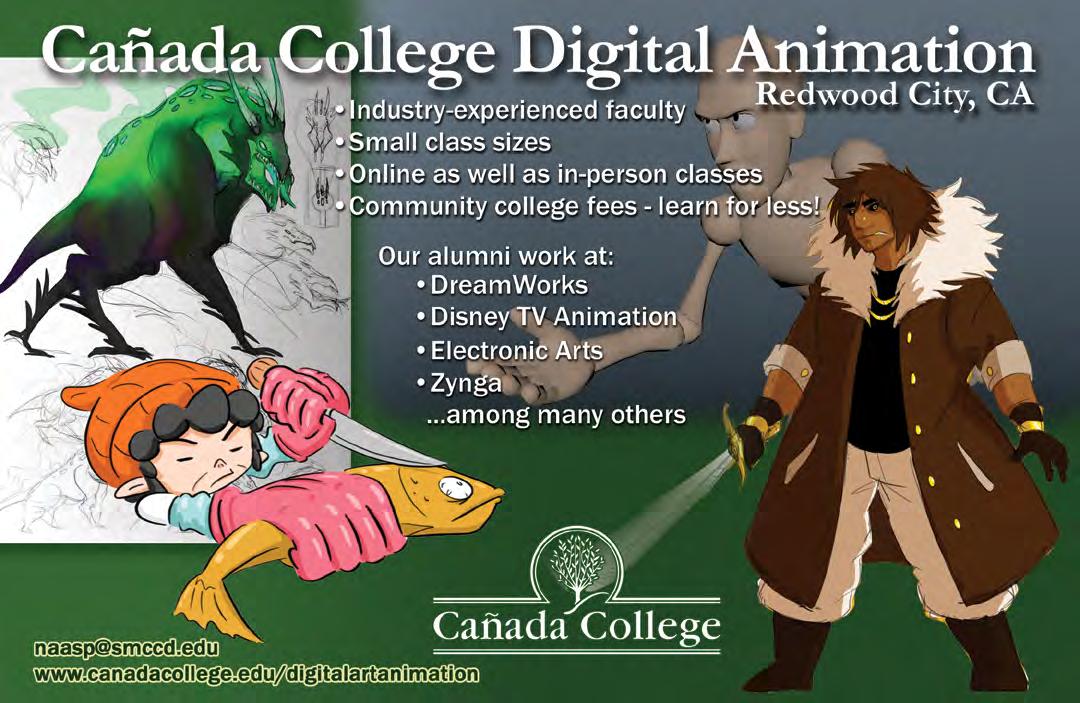
University
San Francisco, CA
cinema.sfsu.edu/minor-animation
Phone: (415) 338 1629
FAX: (415)338-0906
Email: cinema@sfsu.edu
Degrees/Certificates offered: BA Cinema
Number of students in animation program: 60
Cost of program: $8,6000.00 /year
Head of animation: Professor Martha Gorzycki
Head of admissions: ugadmit@sfsu.edu
Time of year offered: Fall and Spring
San Jose State University
San Jose, CA
sjsuai.com
Phone: (408) 924 1000
Email: design@sjsu.edu
Savannah, GA , Atlanta, GA in US and Lacoste, France scad.edu
Email: admissions@scad.edu; contact@scad.
edu
Phone: 800 869 7223
Degrees/Certificates offered: B.F. A. Animation, M.A. Animation, M.F.A. Animation
Number of students in animation program:
2313
Cost of program: $40,095/year
Head of animation: Danyl Bartlett. Dean, School of Animation and Motion
Head of admissions: Steve Mineo, SVP of
Admissions
Time of year offered: Year-round
Application deadline: Rolling admission
Equipment available: Software: Adobe CS5, Autodesk Maya, Autodesk MotionBuilder. Scripting taught in both majors using Python and MEL.
Facilities: Vicon Blade motion-capture studio, dedicated Cintiq homework labs, Maker lab for fabrication with 3D printing and soldering stations, recording stage with 12-bay Foley stage, recording booth and isolation booth in view of a 20-seat classroom and Pro Tools sound board; Avid editing classroom; TV and film studio with greenscreen synch wall, professor’s projector and freight elevator for large sets.
Animation software: Dragonflame, Shotgun, Toon Boom Harmony, Toon Boom Storyboard Pro.
Animation facilities: 45 traditional drawing desks, stop-motion fabrication room and shooting stages (10 at Savannah, six at Atlanta), Stratasys fused deposition printer and PolyJet 3D printer.
Notes: Create new worlds with animation: Be a powerhouse in an industry that spans film, TV, video games, AR/VR and more Illuminate fantastical realms and characters that launch careers, bring joy to fans, and take the world by storm. Named a top animation program in the U.S. year after year by Animation Career Review, SCAD provides every resource to help you develop your signature style in 2D, 3D and stop-motion animation, digital modeling, rigging, lighting and look development. As you work with top companies and peers, you’ll become a pro at collaboration — just like in the real world.
School of Visual Arts
New York, NY, U.S.A.
sva.edu
Phone: (212) 592 2000
Email: admissions@sva.edu
Degrees/Certificates offered: BFA Animation; BFA 3D Animation and Visual Effects; MFA Computer Arts
Number of students in animation program:
BFA Animation: 396; BFA 3D Animation and Visual Effects: 366; MFA Computer Arts: 102
Cost of program: 2023-2024 BFA Programs
Tuition: $24,570 per semester; 2023-2024
MFA Computer Arts Tuition: $27,520 per semester
Head of animation: Hsiang Chin Moe, Chair of BFA Animation; Jimmy Calhoun, Chair of BFA 3D Animation and Visual Effects; Terrence Masson, Chair of MFA Computer Arts
Head of admissions: Matthew Farina
Time of year offered: Year-round; Fall, Spring and Summer semesters
Application deadline: BFA Programs: Rolling admissions; MFA Computer Arts: January 15
Equipment available: Software: Adobe CC Suite, Autodesk Suite (Maya), Toon Boom Animation Software, TVPaint, Nuke, Houdini, REDCine-X, Final Cut, AVID Media Composer, DaVinci Resolve, VDMX, Dragonframe, plus an array of video effects plugins.
Facilities: Computer labs with HP and Mac workstations with Wacom Intuos and Cintiq tablets, greenscreen production room with motion capture and the latest VR equipment; sound mixing room, recording booth with foley pits, and color grading suite.
Equipment: Blackmagic Cinema and 4K production cameras, Canon DSLR cameras, Zeiss and Canon lenses, extensive lighting and audio equipment. Stop-motion workshop for fabrication and staging. MFA students have access to the Visible Futures Lab featuring digital fabrication tools including a 3D scanner, 3D printers, laser cutter, UV printer and CNC router.
Notes: SVA alumni are employed by prestigious studios including Industrial Light & Magic, Pixar, DreamWorks, Disney, Sony Pictures Imageworks, Rhythm & Hues, Digital Domain, Blue Sky Studios, MTV, Electronic Arts, Warner Bros. Animation, Cartoon Network, Sesame Workshop and Nickelodeon. Others have opened their own animation companies, such as Plymptoons, Titmouse and Augenblick studios.
Named “Top Animation School in the World” by the Rookies, SVA students have earned awards in major international competitions including Student Academy Awards, Adobe Design Achievement Awards, YouTube Awards, Prix Ars Electronica, SIGGRAPH, Electronic Theater and Art Show, Webby Awards, ISEA and the Leonardo Awards for Excellence. Student works have appeared in Cannes, Tribeca, Sundance, Annecy, Ottawa and New York festivals, among many others.
School of Visual Arts
Division of Continuing Education New York, NY
sva.edu/ce
Phone: (212) 592 2050
Email: ce@sva.edu
Sheldon’s Art Academy
Oak Park, CA in the USA sheldonsartacademy.com
Phone: (818) 706-9444
Email: sheldonsartacademy@sbcglobal.net
Degrees/Certificates offered: Get your TRADITIONAL Fundamentals prior to pursuing a degree or certificate in Animation. No degree or certificates, but Sheldon’s Art Academy does prepare students in developing a well round strong portfolio not only to apply to college, but also for the work force.
Number of students in animation program: no limit
Cost of program: varies
Head of animation: Sheldon Borenstein
Head of admissions: Robyn
Time of year offered: year around
Smorgasbord Productions Animation Collaboration
Los Angeles, CA smorgasbord.tenzeroseven.com/class
Phone: (323) 825 1306
Email: projects@smorgasbordproductions.com
SMU Guildhall Plano, TX smu.edu/guildhall
Phone: (214) 768-4278
Thomas Jefferson University Philadelphia, PA jefferson.edu
Phone: 215 951 2800
Email: enroll@jefferson.edu
Universal Arts School Hollywood, CA / Valencia, Spain / Online ua.school
Phone: +1 213 910 2161 / +34 963 532 069
Email: usa@ua.school / spain@ua.school; contact@uarts.school
University of the Arts Philadelphia, PA, USA uarts.edu
Email: admissions@uarts.edu
Phone: 215 717 6000
Degrees/Certificates offered: BFA Animation, BFA Game Art, BFA Film & Animation
Number of students in animation program: 167
Cost of program: $54,010
Head of animation: Chris McDonnellAnimation, Erik Van Horn - Game Art, Karl Staven - Film & Animation
Head of admissions: Angela Jones-OBrien
Time of year offered: Fall/Spring
Application deadline: Rolling admission
Equipment Available: Software: Software: Adobe Creative Cloud, Autodesk Maya, Toon Boom Harmony and Storyboard Pro, TVPaint, Dragonframe, ZBrush, Houdini. Three studios with Cintiq workstations, a fourth with wide monitor workstations, a fifth for traditional media and stop motion, individual working suites with Cintiq workstations, 5,600-squarefoot Center for Immersive Media featuring a motion-capture stage and VR workstations, 3,500-square-foot digital and traditional Makerspace, stop-motion studios with computer controlled lighting grids, one with cyclorama corner wall, a Master Oxberry camera stand, downshooters/traditional animation stands, sound design labs and recording studios, foley studio, equipment room with cameras, microphones, and other current A/V equipment needed for production.
Notes: Our accomplished alumni work in animation, film, games, and adjacent disciplines utilizing their fundamental skills, creativity, and resilience honed during their time in our rigorous programs. Our graduates include series creators/showrunners, internationally renowned filmmakers, and professional artists and entrepreneurs. The curriculum encourages authorship: Animation students direct and produce at least three films while exploring traditional, digital, and immersive media tools and techniques. Students can participate in our exciting extracurriculars such as the LA Experience trip, the Ottawa International Animation Festival trip, the Animation Exhibition, the POV juried showcase, our student clubs, and the end of year screenings. Our faculty are active practitioners in addition to being mentors, with feature, series, music video, and game credits, best-selling books, and internationally screened films. Our almost half-century old Animation program inspires students to realize their power as visual communicators and collaborators in our unique and urban University setting where dancers, musicians, actors, designers, writers, painters, filmmakers and more share classes, experiences, and our collective vision to advance human creativity.
Philadelphia, PA, USA uarts.edu
Email: admissions@uarts.edu
Phone: 215 717 6000
Degrees/Certificates offered: BFA Animation, BFA Game Art, BFA Film & Animation
Number of students in animation program: 167
Cost of program: $54,010
Head of animation: Chris McDonnell - Animation, Erik Van Horn - Game Art, Karl Staven - Film & Animation
Head of admissions: Angela Jones-OBrien
Time of year offered: Fall/Spring
Application deadline: Rolling admission
Equipment Available: Software: Software: Adobe Creative Cloud, Autodesk Maya, Toon Boom Harmony and Storyboard Pro, TVPaint, Dragonframe, ZBrush, Houdini. Three studios with Cintiq workstations, a fourth with wide monitor workstations, a fifth for traditional media and stop motion, individual working suites with Cintiq workstations, 5,600-square-foot Center for Immersive Media featuring a motion-capture stage and VR workstations, 3,500-square-foot digital and traditional Makerspace, stop-motion studios with computer controlled lighting grids, one with cyclorama corner wall, a Master Oxberry camera stand, downshooters/traditional animation stands, sound design labs and recording studios, foley studio, equipment room with cameras, microphones, and other current A/V equipment needed for production.
Notes: Our accomplished alumni work in animation, film, games, and adjacent disciplines utilizing their fundamental skills, creativity, and resilience honed during their time in our rigorous programs. Our graduates include series creators/ showrunners, internationally renowned filmmakers, and professional artists and entrepreneurs. The curriculum encourages authorship: Animation students direct and produce at least three films while exploring traditional, digital, and immersive media tools and techniques. Students can participate in our exciting extracurriculars such as the LA Experience trip, the Ottawa International Animation Festival trip, the Animation Exhibition, the POV juried showcase, our student clubs, and the end of year screenings.
Our faculty are active practitioners in addition to being mentors, with feature, series, music video, and game credits, best-selling books, and internationally screened films.
Our almost half-century old Animation program inspires students to realize their power as visual communicators and collaborators in our unique and urban University setting where dancers, musicians, actors, designers, writers, painters, filmmakers and more share classes, experiences, and our collective vision to advance human creativity.
University of California Los Angeles (UCLA)
School of Theater, Film & Television Animation Workshop Los Angeles, CA animation.filmtv.ucla.edu
Phone: (310) 206 8441; (310) 825 421
Email: info@tft.ucla.edu
University of Central Florida School of Visual Arts and Design Orlando, FL svad.cah.ucf.edu
Phone: (407) 823-2676
Fax: (407) 823-6470
Email: svadadvising@ucf.edu
University of Silicon Valley San Jose, CA usv.edu
Phone: (800) 264-7955
University of Southern California, School of Cinematic Arts
John C. Hench Division of Animation + Digital Arts
Los Angeles, CA, United States animation.usc.edu cinema.usc.edu
Phone: (213) 821-4396; (213) 764-7959
Email: admissions@cinema.usc.edu; animation@cinema.usc.edu
Degrees/Certificates offered: BFA in Animation & Digital Arts, MFA in Animation & Digital Arts, Minor in 3D Animation in Cinematic Arts, MA+P Interdivisional Media Arts & Practice PhD (interdivisional).
Number of students in animation program: 170
Cost of program: classes.usc.edu/term-20241/ tuition-and-fees/
Head of animation: Teresa Cheng, Chair
Head of admissions: Neelam Savla (Admissions Program Manager)
Time of year offered: Fall admission only
Application deadline: Freshman (first year) applicants & Transfer Applicants - December 1;
Graduate applicants - November 15
Equipment available: Cintiq lab, IMAX theater, motion-capture stage, professional grade sound production facilities, VR goggles, industry standard 2D and 3D animation software.
Notes: Faculty include top industry professionals from TV and feature animation, visual effects, motion graphics and design studios. Animation students collaborate with other film students within the School of Cinematic Arts and across the USC campus with the Thornton School of Music, the Roski School of Art and Design, the Glorya Kaufman School of Dance, the Viterbi School of Engineering, the School of Dramatic Arts and the School of Architecture on creative projects. Students have opportunities to interview with recruiters from major studios on Studio Day, an
annual career event. Graduates work at Pixar, DreamWorks, Netflix, Sony Pictures Animation, Disney, Cartoon Network, Nickelodeon, Digital Domain, The Third Floor, Motion Picture Company, Oculus VR, Buck, Logan, Elastic and Blizzard.
Vertex School Orange County, CA vertexschool.com
Webster University
School of Communications St. Louis, MO webster.edu/communications
Phone: 800 981 9801
Email: admissions@webster.edu
Woodbury University Burbank, CA woodbury.edu
Phone: (818) 252 5221
Email: admissions@woodbury.edu
Alberta University of the Arts
School of Continuing Education & Professional Development Calgary, AB auarts.ca/continuing-education
Email: coned@auarts.ca; infodesk@auarts.ca
Phone: 403 284 7600
FAX: 403 289 6682
Degrees/Certificates offered: Various
Animation Micro-Credentials, MicroCertificates, & Animation Certificate
Number of students in animation program: 30+
Cost of program: $1,000 - $7,500
Head of admissions: Melissa Kern
Time of year offered: All year
Application deadline: Ongoing
Algoma Art Academy
Sault Ste. Marie, Ontario, Canada algomaartacademy.com
Phone: 4174938016
Email: algomaartacademy@gmail.com
Degrees/Certificates offered: Although working towards an accredited Art and Animation School, Algoma Art Academy is a newly established educational facility that currently offers certificates and awards in creative achievements in visual arts and animation. Certificates for Portfolio Development, including reviews and critiques, for students looking to apply to accredited colleges and universities are also offered.
Number of students in animation program: On campus enrollment accommodates up to 100 students. Online classes will accommodate up to 200 students, initially.
Cost of program: Fees vary depending on the student’s age and the desired course. Classes are open to children, teens, adults and post-secondary students. More information will be available soon on our website.
Head of animation: Maureen Shelleau
Head of admissions: Maureen Shelleau
Time of year offered: Year round courses. Fall and Winter Semesters, plus Summer School.
Application deadline: At this time, there are no deadlines. The school currently operates on a first come first serve
Capilano University
North Vancouver, BC gradshow.com
Phone: (604) 983 7516
Email: animation@capilanou.ca
Collège Boréal
Sudbury, ON collegeboreal.ca
Phone: (705) 560-6673, (800) 361-6673
Email: info@collegeboreal.ca; liasion@ collegeboreal.ca
École NAD
Université de Québec à Chicoutimi Montréal, QC nad.ca
Phone: (514) 288 3447
Email: info@nad.ca
Emily Carr University of Art + Design
Vancouver, BC, Canada ecuad.ca
Phone: (604) 844 3800
Email: admissions@ecuad.ca; reception@ ecuad.ca
InFocus Film School
Vancouver, BC
infocusfilmschool.com
Phone: 604 915 6900
Email: admissions@infocusfilmschool.com; info@infocusfilmschool.com
Degrees/Certificates offered: One-year diploma
Number of students in animation program: 8-12
Cost of program: $24,950 CAD (Canadian Students) / $34,950 CAD (International Students)
Head of animation: Selman Kantarci
Head of admissions: Laura Nault
Application deadline: August 2023
ISART Digital
Montréal, QC / Paris & Nice, France / Tokyo, Japan isart.com
Phone: (438) 382 7466
Email: contact@isartdigital.ca
LaSalle College Vancouver Vancouver, BC
lasallecollegevancouver.com
Phone: (604) 683 2006; 877 847 7902
Email: admissions@lasallecollegevancouver. com
Max the Mutt College of Animation, Art & Design Toronto, ON maxthemutt.com
Phone: (877) 486 6888; (416) 703 6877
Email: info@maxthemutt.com
MTM College
Toronto, ON Canada maxthemutt.com
Phone: 416-703-6877
Email: info@maxthemutt.com
Degrees/Certificates offered: Animation, Concept Art, Illustration for Sequential Arts Number of students in animation program: 58
Cost of program: $12,500 CAD
Head of animation: Steve Millard (smillard@ maxthemutt.com), Joshua Pinker (joshuapinker@maxthemutt.com)
Head of admissions: Azadeh Keshvardoust (admissions@maxthemutt.com)
NBCC MIramichi Campus Miramichi, NB nbcc.ca
Phone: (506) 460 6222; (888) 796 NBCC [6222]
Email: nbcc@nbcc.ca
Seneca College Toronto, ON senecacollege.ca
Phone: (416) 491 5050
Email: admissions@senecacollege.ca
Sheridan College Oakville, Brampton & Mississauga, ON sheridancollege.ca
Phone: (905) 845-9430
Email: admissions@sheridancollege.ca; infosheridan@sheridancollege.ca
Think Tank Training Centre North Vancouver, BC, Canada & Online tttc.ca
Phone: (604) 990-8265, (888) 990-8265
Email: info@tttc.ca
Vancouver Film School
Vancouver, British Columbia, Canada vfs.edu
Phone: (604) 685 5808
Email: admissions@vfs.com
Degrees/Certificates offered: Advanced Production Diploma in 3D Animation & Visual
From interactive design and game development to immersive reality, animation, and visual effects, SCAD offers the superpowered tech and degree programs to level up your creative career. Join SCAD graduates working at companies like Adobe, Apple, Electronic Arts, Microsoft, and more.


4
alumni employment* 99% 475+ first-place student wins in 2022–23 100 degree programs
Effects, Advanced Production Diploma in Animation Concept Art, Advanced Production Diploma in Classical Animation
Number of students in animation program: 345 students in 2023
Cost of program: 3D Animation & Visual
Effects: C$35,950 (domestic); Animation
Concept Art: C$25,950 (domestic); Classical Animation: C$25,950 (domestic)
Head of animation: Colin Giles
Head of admissions: Gija Williams
Time of year offered: 3D Animation & Visual
Effects: 2024 – April 29, June 24, August 26, October 21; 2025 – January 6, March 3, May 5, June 30; Animation Concept Art: 2024 –February 26, June 24, August 26, October 21; 2025 – March 3, June 30, September 2;
Classical Animation: 2024 – February 26, April 29, August 26; 2025 – January 6, March 3, May 5, September 2
Application deadline: U.S./International: Eight weeks before start date. Canada: Three weeks before start date.
Equipment available: Dell Precision 5820, Intel Xeon W-2245 CPU @ 3.90GHz (8 cores), NVIDIA Quadro RTX 5000, Wacom Cintiqs XP-Pen Drawing Monitors.
Software: Houdini, Maya, ZBrush, Nuke, Substance Painter, Marvelous Designer, Faceware, Unreal, Adobe Creative Suite, Digicel, Toon Boom Harmony, Toon Boom Storyboard Pro.
Vancouver Institute of Media Arts (VanArts)
Vancouver, BC, Canada
vanarts.com
Phone: 604-682-2787; 800-396-2787
FAX: 604-684-2789
Email: info@vanarts.com
Degrees/Certificates offered: ANIMATION-
RELATED:
2D Character Animation Diploma, 3D Character Animation Diploma, Game Art & Design Diploma, Visual Effects for Film & TV Diploma, Art Foundation Certificate
OTHER:
Professional Photography Diploma, Acting for Film & TV Diploma, Web Development & Design Diploma
Number of students in animation program: approx. 75
Cost of program: Domestic Tuition Range: $22,750 CAD to $34,750 CAD -- International
Tuition Range: $29,750 CAD to $41,750 CAD
Head of animation: Wayne Gilbert
Head of admissions: Ken Priebe
Time of year offered: March & September
Application deadline: Rolling admissions
Equipment available: 3D Animation: PC workstations equipped with Maya & Adobe Suite. 2D Animation: PC workstations equipped with Toon Boom Harmony & Adobe Suite, plus Huion Kamvas 22 Plus tablets. Other gear for Game Art/VFX: VR, motion capture, greenscreen
Aardman Academy
Bristol, U.K. academy.aardman.com
Email: academy@aardman.com
The Animation Workshop Viborg, Denmark animationworkshop.via.dk
Phone: +45 8755 4900
Email: studieplads@via.dk; taw@via.dk
Animum Creativity Advanced School Málaga, Spain / Online animum3d.com
Phone: +34 952 330 270
Email: hello@animum3d.com
ARTFX School
Montpellier, Lille & Paris, France artfx.school/en
Phone: Montpellier +33 (0) 4 99 77 01 42 | Lille +33 (0) 3 62 84 02 35 | Paris +33 (0) 1 85 76 68 80
Email: communication@artfx.fr
Arts University Bournemouth Poole, Dorset, U.K.
aub.ac.uk
Phone: +44 1202 533011
Email: hello@aub.ac.uk; international@aub. ac.uk
Ballyfermot College of Further Education
Dublin, Ireland bcfe.ie
Phone: +353 1 6298500
Email: info@bcfe.cdetb.ie
BAU Design College of Barcelona Barcelona, Spain baued.es
Phone: +34 93 415 34 74
Email: info@bau.cat Bellecour École Lyon, France
bellecour.fr
Phone: +33 478 929 283; +33 988 288 127
Email: info@bellecour.fr
Bournemouth University Bournemouth, U.K. bournemouth.ac.uk/ncca
Phone: +44 (0)1202 524111
Email: futurestudents@bournemouth.ac.uk
Buckinghamshire New University
High Wycombe, England, U.K.
bucks.ac.uk
Phone: 01494 522 141; +44(0) 1494 605060
Email: admissions@bucks.ac.uk
CDCFE
(Coláiste Dhúlaigh College of Further Education)
Dublin, Ireland
cdcfe.ie
Phone: 01 848 1400
Email: coolock@cdcfe.cdetb.ie
ECAS
École Cartoucherie d’Animation Solidaire Bourg-Lès-Valence, France
ecas.fr
Phone: 04 28 08 02 06
Email: info@ecas.fr
Degrees/Certificates offered: Formation professionnelle rémunérée. (Paid vocational training.)
Number of students in animation program: 30 per year
Cost of program: No cost
Head of admissions: Ludovic Guerin
Time of year offered: 10 months
École MOPA
Arle, Provence, France ecole-mopa.fr/en/3d-animation-school
Phone: +33 4 76 41 83 22
Email: contact@ecole-mopa.fr
Degrees/Certificates offered: Five-year state-accredited advanced diploma in 3D animation (Expert en Conception, Réalisation et Animation 3D) divided into two Study
Cycles: Study Cycle 1 (three years) provides artistic and cinematographic foundations and 3D skills/mastery of the animated film production process. Drawing, sculpture, character design, film analysis, storyboard, scriptwriting, video, rigging, sound design, acting for animation, animation software (ZBrush, V-Ray, Nuke, Substance, Marvelous, etc.). Cycle 1 culminates in the production of a solo one-minute film by each third year student.
Study Cycle 2 has students specialize in the fourth year on image production or 3D animation and they deepen their skills in those areas with tools such as Maya, Arnold, Yeti, Speedtree and Houdini. The fifth year graduation films are completed in groups, a project that spans the academic year. Tuition is in French.
Number of students in animation program: 280
Cost of program: Preparatory Class 5,920€ / First Year & Second Year 7,750€ / 3rd, 4th & 5th year 8,350€. In addition to the tuition fees, there is a registration fee of 400€ (new student joining MoPA) or a re-registration fee of 150€. For non-EU students, a 700€ administration fee is added to the tuition and registration fees for the first year.
www.animationmagazine.net
Head of animation: Jean-Baptiste Trullu
Head of admissions: Stephanie Delobelle
Time of year offered: The academic year starts in September of each year. The entrance exam for the First Cycle is open from NovemberFebruary is several sessions each year. The entry into the 2nd Cycle (3rd year, 4th year) is open in Spring of each year. Application deadline: The entrance exam for the First Cycle is open from NovemberFebruary is several sessions each year. The entry into the 2nd Cycle (3rd year, 4th year) is open in Spring of each year. Write to admissions@ecole-mopa for exact dates.
Equipment available: The computer pool is renewed regularly, each student has a dedicated workstation, all essential tools are present (3ds Max, Maya, Nuke, Substance, Houdini, Marvelous, Adobe...) and MoPA is partnered with Chaos Group. The Deadline computational management tool has been integrated into the school since 2016; the 280 student machines as well as a computational farm participate in the production of all films, this computing power is measured at 10 THz. Deadline also handles power management of all computers to save energy. The school has remote tools to schedule courses with external lecturers, to allow students to work from home on the school’s machines or to allow sick students to continue to follow courses during the day. A stop-motion room is also made available with 12 Rostrum camera setups, this facility includes the Dragonframe software.
Notes: MoPA student films are regularly selected for and awarded prizes in international festivals such as Siggraph, Academy Awards, VES Awards, Monstra, etc, with the 2020 graduation film Louis’Shoes notably recently winning the Student Academy Awards. Recent MoPA alumni are currently working as: Houdini FX artist, animator, lighter/ compositor, character animator, character rigger, creature FX, FX lead, look developer, storyboard artist, concept artist, previs, surfacing artist, TD, et al. Alumni have worked on productions like Man of Steel,His Dark Materials,The Grinch,The Swallows of Kabul, Life of Pi,Despicable Me,Zombillenium,Star Wars:The Last Jedi,Thor: Ragnarok,Doctor Strange,The Super Mario Bros.Movie,Black Mirror and many more.
London, England, U.K. escapestudios.ac.uk
Email: hello@escapestudios.ac.uk
Phone: +44 (0) 203 4411 303
Degrees/Certificates offered: BA (Hons)/MAr t The Art of Computer Animation (2D), BA (Hons)/MART
The Art of Compuer Animation (3D), BSc (Hons) MSci Character for Animation, Games & VFX, MA Character & Creature Creation, MA 3 Animation
Number of students in animation program: Eight in MA and 160 in BA
Cost of program: £9,250 per year (Undergraduate), from £15,450 (Postgraduate)
Head of animation: Paul Harrison
ESMA
École Supérieure des Métiers Artistiques
France & Canada
esma-3d.com (English)
esma-3d.fr (French)
Phone: +33 (0) 467630180
Email: contact@esma-montpellier.com
Degrees/Certificates offered: CG Animation & FX Master Degree - RNCP level 7 (equivalent to a french Bac + 5); CG Director Designer and Special Effects. Five years of study for the entire program.
Number of students in animation program: 1,400
Cost of program: 7,680 euros per year
Heads of animation: Benjamin Meyer, Baptiste Lebouc, Yann Pannetier, Anthony Voisin
Head of admissions: Stéphanie Legrou
Application deadline: Year-round
Equipment available: Computers, licenses (Houdini, Maya, Zbrush, Affinity, Autodesk, Marvelous Designer, Software Yeti), motion capture, amphitheaters, film studio, gym, drawing rooms, terrace, auditorium…
Notes: The Lyon and Montpellier campuses offer the program in English. Foreign students
who speak English can follow the first year, the preparatory year (during which French courses are given), in France before joining the CG Animation & FX Master Degree in English for the next four years. Students can enter the second year directly (without going through the preparatory year) if their drawing skills are sufficient. This will be determined with an admission officer. Interviews can be done remotely and will be conducted in English.
Estonian Academy of Arts Tallinn, Estonia artun.ee/en/home/
Email: lyza.jarvis@artun.ee; artun@artun.ee Phone: +372 6267301
Degrees/Certificates offered: Animation MA is the one we would like to promote.
Number of students in animation program: 8 per school year
Cost of program: 3000eur for EU students. 3800eur for non EU students
Head of animation: Ülo Pikkov
Head of admissions: admissions@artun.ee
Time of year offered: Fall Semester admissions
Application deadline: March 4, 2024
Equipment available: Puppet film studio space and equipment, multiplanes, computers and drawing cintiques, array of animation programs.
Filmakademie BadenWuerttemberg Animationsinstitut Ludwigsburg, Germany animationsinstitut.de/en
Email: study@animationsinstitut.de
Degrees/Certificates offered: Diploma
Number of students in animation program:
110
Cost of program: 0€ (per semester) for first degree students from the EU, 650€ (per semester) for second degree students from the EU (excluding postgraduate courses which are free of charge for EU citizens), 1.500€ (per semester) for non-EU citizens
Head of animation: Jan Pinkava (Director of the Animationsinstitut)
Head of admissions: Constanze Bühner, Riccarda Rüttler
Time of year offered: Winter
Application deadline: February 15
IDEA Academy
Rome, Italy
idea-academy.eu
Phone: 06 4201 3420
Email: info@idea-academy.it
L’IDEM Creative Arts School
Le Soler, France / Barcelona, Spain lidem.eu
Phone number: +33 468 92 53 84 / +34 934 854 550
Email: pole-formation@lidem.eu; scolarite@ lidem.eu
ISART Digital
Paris, France isart.com
Phone: +33 1 48 07 58 48
Email: informations@isartdigital.com Lightbox Academy S.L Madrid, Spain lboxacademy.es
Phone: +34 917 520 510
Email: gestion@lboxacademy.es; hablamos@ lboxacademy.es
Degrees/Certificates offered: - Two-Year Training Programs (from elementary to advanced) Doble Máster in: Animation, 3D Modeling, VFX, Illustration & Concept Art, Motion Graphics, Video Games.
- One-Year Training Programs (from elementary to advanced) Máster Superior in: 3D Animation, 2D Animation, 3D Modeling & Animation, 3D Modeling & VFX, VFX, Motion Graphics, Illustration & Concept Art, Video Games.
- Five-Month Elementary Training Programs, Máster in: 3D Animation, 2D Animation, 3D Modeling with Maya, Organic Modeling with ZBrush, Blender, VFX, FX with Houdini, Video Games, Unity, Unreal, Illustration & Concept Art, Storyboard, Motion Graphics.
- Five-Month Advanced Training Programs, Máster Avanzado in: 3D Animation, 2D Animation, 3D Modeling, VFX, FX with Houdini, Video Games, Illustration & Concept Art, Motion Graphics.
- One - to Four-Month Specialized Training
Courses: Rigging, After Effects, Cinema 4D.
Number of students in animation program: 15 face-to-face students and five online students (per class). 387 total students in 2023.
Cost of program: 8,000 € per year
Head of animation: Enrique Gato, Animation
Film Director.
Head of admissions: Virginia Corralo
Time of year offered: October and March
Luca School of Arts
Brussels, Genk, Gent & Leuven, Belgium
luca-arts.be
Phone: +32 89 30 08 50; + 32 2 250 11 00
Email: info@luca-arts.be / internatinoal@
luca-arts.be
Lucerne School of Arts, Film & Design Emmenbrücke, Lucerne, Switzerland animation-lucerne.ch/
Phone: +41 41 248 6464
Email: animation@hslu.ch
Degrees/Certificates offered: BA Animation, MA
Animation
Number of students in animation program: 30/ Year BA, 8/Y MA
Cost of program: approx. 2000 CHF per year
Head of animation: Prof. Juergen Haas
Head of admissions: aufnahmeverfahren.dfk@ hslu.ch
Time of year offered: Fall Semester
Application deadline: Sunday, 18th February 2024
Met Film School
London, U.K.
metfilmschool.co.uk
Phone: +44 20 8280 9119
Email: info@metfilmschool.co.uk
National Film School
Dun Laoghaire Institute of Art, Design and Technology
Dublin, Ireland iadt.ie
Phone: +353 1 239 4000
Email: info@iadt.ie
National Film and Television School Beaconsfield, Buckinghamshire, U.K. nfts.co.uk
Phone: +44 (0) 1494 671234
Email: info@nfts.co.uk
Degrees/Certificates offered: The NFTS runs more than 30 MA, Diploma and Certificate courses - as well as numerous short courses - across a range of film, television and games disciplines. We have more behind the camera courses than any other film school in the world. These include our Directing Animation MA, Visual Effects MA, Model Making for Animation Diploma and Motion Graphics and Titles Diploma.
Number of students in animation program: 10
Cost of program: See website
Head of animation: Robert Bradbrook
Head of admissions: Registry
Time of year offered: January
Application deadline: July
Equipment available: As a student here, you will gain access to an exhaustive range of high-end equipment relevant to your studies. This includes Dolby Atmos certified dubbing theaters, full-scale film stages, two cinemas, over 50 top-of-the-range cameras, the latest editing software, prop stores, 280-degree greenscreen room, motion and performance capture facilities, cutting-edge computer labs and Virtual Production facilities.
Each animation director, in their first year, is offered their own desk area with computer in a shared studio space. In the second year, students have their own small rooms to use as a production base. Workstations are fully equipped with the latest design and animation software.
Notes: If you want to make high-quality, award-winning content for film, television and games, guided by world class professionals every step of the way, the sky truly is the limit
at the National Film and Television School!
Odd School
Lisbon, Portugal
odd-school.com
Phone: +351 21 820 63 97
Email: secretaria@odd-school.com
Pulse College
Dublin, Ireland
pulsecollege.com
Phone: +353 1 478 4045
Email: admissions@pulsecollege.com
Plymouth College of Art
Plymouth, Devon, U.K.
plymouthart.ac.uk
Phone: +44 (0) 1752 203434
Email: hello@pca.ac.uk; enquiries@aup.ac.uk
RITCS
Royal Institute for Theatre, Cinema and Sound Brussels, Belgium ritcs.be/nl/animatiefilm
Email: animatiefilm.ritcs@ehb.be
Sheridan College
Oakville, ON, Canada
www.sheridancollege.ca
Phone: (905) 845- 9430
Email: admissions@sheridancollege.ca
Degrees/Certificates offered: Bachelor of Animation; Computer Animation post-graduate certificate; Visual Effects post-graduate certificate; Digital Creature AnimationTechnical Direction post-graduate certificate
Number of students in animation program: Bachelor of Animation- 586
Computer Animation post-graduate certificate53
Visual Effects post-graduate certificate- 13 Digital Creature Animation post-graduate certificate- 14
Cost of program: Bachelor of Animation$9,846.47 CDN domestic and $30,145.47 CDN international; Computer Animation, Visual Effects or Digital Creature Animation- Technical Direction Post-graduate certificate- $13,316.12 CDN domestic and $25,223.72 CDN
international
Head of animation: Associate Dean of Animation and Game Design, Theresa Scandiffio
Bachelor of Animation Program Coordinator, Mario Positano
Computer Animation, Visual Effects and Digital Creature Animation-Technical Direction Post-graduate certificate Co-Program Coordinators, Steven Sayer and Kathryn Wehrle
Head of admissions: admissions@ sheridancollege.ca
Application deadline: February 1st 2024
Equipment available: Animation: Autodesk- Maya & Mudbox, Arnold, NukeX, ZBrush, Toon Boom-Harmony & Storyboard Pro, SyncSketch, Dragon Frame, Adobe Creative Suite, Camtasia, Microsoft Office Suite, Fully equipped Stop Motion Studio, Stop Motion Studio Pro, HP Z Series Professional animation workstations, WACOM Cintiqs, Green Screen Studio, Render Farm, Sound and Recording Studios, Foley Studio, Large Format Scanners Computer Animation, Digital Creature and
Visual Effects:
High-end workstations, Dual monitor setup with WACOM Cintiq displays, Powerful render farm with Deadline control software, Autodesk software (Maya, Motion Builder, etc.), Adobe software (Photoshop, Substance,etc.), Maxon software (Redshift, ZBrush, etc.), EpicGames Unreal, Nuke
Digital Creature Only: Houdini, Python
VFX:
BlackMagic Cameras, Green Screen Studio, Virtual Production Studio, PFTrack, Houdini
Supinfocom Rubika
Valenciennes, France / Montreal, Canada / Pune, India
rubika-edu.com
Phone: +33 (0) 3 61 10 12 20
Email: contact@rubika-edu.com
Degrees/Certificates offered: Master in 2D Animation, Master in 3D Animation (either 3D Animation or FX option)
Number of students in animation program: 355 students (110 in 2D and 245 in 3D)
Cost of program: 5,650€ per year for the Preparatory class and 8,950€ per year
Head of animation: Pierre Le Pivain, Head of 2D course; Philippe Meis, Head of 3D course
Head of admissions: Pierre Soussin, Marketing, Communication & International Development
Director
Time of year offered: From September to June
Application deadline: April 5 for foreign students. For French students, registration on Parcoursup.
Equipment available: All the equipment required is provided by the school: One fixed PC with double screen, Adobe licenses and 2D/3D software, renderfarm, audio control room, two screening rooms (one of 450 seats and one of 150 seats).
The Strzemiński Academy of Art Łódź Łódź, Poland int.asp.lodz.pl
Phone: +48 42 25 47 408; +48 42 25 47 418
Email: kancelaria@asp.lodz.pl / international. office@asp.lodz.pl
Technological University of the Shannon
Multiple Campuses in Ireland tus.ie
Email: reception.midlands@tus.ie; reception. midwest@tus.ie
Phone: +353 090 6468001; +353 61 293000
Degrees/Certificates offered: Bachelor of Arts (Honours) in Animation and Illustration
Bachelor of Arts (Honours) in Animation and Motion Design
Bachelor of Science (Honours) in Digital Animation Bachelor of Science (Honours) in Game Art and Design
Number of students in animation program:
100
Cost of program: €12,500 tuition fee.
Scholarships are available.
Head of animation: Dr. Yvonne Hennessy
Head of admissions: international@tus.ie; admissions.midlands@tus.ie
Time of year offered: June-August
Application deadline: June 1st 2024 for September intake.
University
Farnham, Surrey, U.K. uca.ac.uk
Phone: +44 (0) 1252 722 441
Email: admissions@uca.ac.uk | internationaladmissions@uca.ac.uk
University of Gloucestershire Cheltenham, U.K. glos.ac.uk
Phone: +44 (0)1242 714700
Email: admissions@glos.ac.uk
University of Luxembourg Competence Centre Luxembourg
u.competence.lu/bda
Phone: +352 26 15 92 17
Email: bachelor@competence.lu; info@ competence.lu
Degrees/Certificates offered: Bachelor in Animation
Number of students in animation program: 12
Cost of program: 200 euros/semester
Head of animation: Mr.Jacopo Armani
Head of admissions: bachelor@competence.lu
Time of year offered: September-July
Application deadline: 30/04/2024
U-tad
University of Technology, Arts and Design Madrid, Spain u-tad.com
Phone: +34900 373 379
Email: info@u-tad.com
Degrees/Certificates offered: On Campus: BFA in Animation (Spanish or English), BA in Game Design (Spanish or English), BFA in Digital Design, BA in Visual Effects, BS in Computer Science (Spanish or English), Double BS in Computational Mathematics & Computer Science, Double BS in Physics & Computer Science. MA in 3D Character Animation, MA in Compositing for VFX, MA in Rigging and CFX, Expert Program in Character Design, MA Production Direction for Animation, VFX and Videogames, MFA in Concept Art, MFA in Story Art, MA in Motion Graphics, MA in Previs & Layout, Expert Program in Comic, MA in 3D Modeling MFA in Game Art, MA in Game Design, MS in Game Programming. MS in Graphic Computing, Simulation, VR and AR, MS in Cybersecurity.
Online: BFA in Animation, BS in Computer Science, BA in Game Design, MA in 3D Character Animation, MS in Cybersecurity.
Number of students in animation program: 900 amongst all related programs, undergraduate and graduate.
Cost of program: Price range from 6.500€ to 13.000€ per year.
Head of animation: Abraham López Guerrero
Head of admissions: José García Romero
Time of year offered: Fall
Application deadline: September 2023
Equipment available: Traditional and digital art labs. Traditional Drawing classrooms and Sculpture Studio, +200 Cintiqs, mocap equipment, VR Labs, Photography Studio.
Software includes Adobe Suite, Autodesk Maya, Flash, Photoshop, Unity, Unreal Engine, Nuke, ZBrush and Shotgun, Microsoft Office.
Notes: U-tad was opened by the founders of Pyro Studios and Ilion Animation Studios in 2011. It is a higher education institution focused on educating students for the creative and technological industries. We rank in the top six worldwide and number one in Spain in game education per Gameschool rankings, and top 10 in Software Engineering in Spain per SEDEA rankings. We have a practical education model based on project development. We have +1,900 students in the different areas and +300 teaching faculty, of which 80% are active industry professionals. Our students have won over 130 awards in five years, including Annie Award winner for Best Production Design María Pareja (Wolfwalkers) and Best Animator Annie nominee Andrés
Bedate (TheWilloughbys) 15 Playstation Awards, 4 SXSW, 2 Game Lab Awards and 7 Fun & Serious Awards. Our students work in major companies like ILM, Disney, Sony Imageworks, MPC, Double Negative, Animal Logic, Weta, Ubi Soft, Splash Damage, Epic Games, King, EA, and many key entertainment companies around the globe
UWE Bristol Bristol, U.K. uwe.ac.uk
Phone: +44 (0)117 9656261
Email: admissions@uwe.ac.uk
Vigamus Academy
Rome, Italy
vigamusacademy.com
Phone: +39 066 177 4482
Email: segreteria@vigamus.com
AIE
Academy of Interactive Entertainment
Sydney, Melbourne, Canberra & Adelaide, Australia / Seattle, WA & Lafayette LA, U.S.A. / Online
aie.edu.au
Email: international@aie.edu.au; segreteria@ vigamusacademy.com
Phone: +390661774482
Azpire Education
Pune, Maharashtra, India azpireeducation.com
Phone: 911 210 6555; 9112104555
Email: azpire.services@gmail.com
Degrees/Certificates offered: BVoc in Animation
Number of students in animation program: 50+ per year
Cost of program: RS. 125,000 per year
Head of animation: Amar S.
Head of admissions: Shikha B.
Time of year offered: June intake started
Application deadline End of June
Equipment available: State of the art infrastructure and animation labs.
De La Salle College of Saint
Benilde
Manila, Philippines
benilde.edu.ph
Phone: (63) 2 8230 5100
Email: info@benilde.edu.ph
The Graduate School of Advanced Imaging Science
Chung-Ang University
Seoul, Republic of Korea
neweng.cau.ac.kr
Phone: +82 2 820 6575
FAX: +82 2 813 8069
Email: inbound@cau.ac.kr
Griffith Film School
Griffith University Brisbane, Queensland, Australia griffith.edu.au/study/degrees/bachelor-ofanimation-1179?location=intl
Email: international@griffith.edu.au
PHONE: +61 7 3735 7700
Degrees/Certificates offered: Bachelor of Animation, Bachelor of Animation with Honours, Master of Screen Production.
Number of students in animation program: 300
Cost of program: 34,500AUD per year for internationals
Head of animation: Dr. Peter Moyes
Head of admissions: k.comerford@griffith.edu.
au Time of year offered: Trimester 1 intake (March)
Application deadline: No set deadline; sufficient time for visa, travel and orientation.
Equipment available: Four computer labs running Windows on Mac hardware; Wacom tablets; software: Adobe Suite, Toon Boom, Maya, etc.; motion-capture facility; stop-motion facility; soundstage;
iNurture Education Solutions
Multiple Campuses, India inurture.co.in
Phone: +91 80 4257 6666
Email: admission@inurture.co.in
Lasalle College of the Arts University of the Arts Singapore Singapore lasalle.edu.sg
Phone: +65 6496 5000
Email: admissions@lasalle.edu.sg; contact. us@lasalle.edu.sg
Auckland, New Zealand mediadesignschool.com
Phone: +64 9-303-0402
Email: info@mediadesignschool.com
Ngee Ann Polytechnic
School of Film & Media Studios
Singapore np.edu.sg
Phone: +65 6466 6555
Email: asknp@np.edu.sg
Western Australia, Australia northmetrotafe.wa.edu.au
Email: enquiry@nmtafe.wa.edu.au
Phone: 1300 300 822
Degrees/Certificates offered: Advanced Diploma of Screen and Media (Animation & Visual Effects), Advanced Diploma of Screen and Media (Game Art & Design), Diploma of Screen and Media (Animation & Visual Effect), Diploma of Screen and Media (Animation & Game Art), Certificate IV in Screen and Media (Animation & Visual Effect), Certificate IV in Screen and Media (Animation & Game Art), Certificate III in Screen and Media (Animation), Certificate III in Screen and Media (Animation & Game Art)
Number of students in animation program: 150
Cost of program: AUS $15,000
Head of animation: Tanya Beeson
Head of admissions: Matthew Johnson
Time of year offered: January and July
Application deadline: Sem. 1 - January 5, 2024 | Sem. 2 - July 10, 2024
Equipment available: High-end PC labs for 3D Animation and Visual Effects, high-end PC labs with Cintiq monitors for 2D Animation and drawing, sound recording studio, 18 camera Motion-Capture Studio, Animation Studio for industry projects.
The One Academy
Kuala Lumpur, Selangor, Malaysia toa.edu.my
Phone: +603 7875 5510
Fax: +603 7875 5508
Email: info@toa.edu.my
Degrees/Certificates offered: Diploma & Degree Programs: Digital Animation (with Game Development), Film Visual Effects, Game Design, Computer Science, Illustration (with Movie & Game Art), Advertising & Graphic Design, Digital Media Design
Degree Programs - BA(Hons): Graphic Design, Digital Media Design.
Number of students in animation program:
281
Cost of program: Diploma: RM92,500 –RM149,000, Degree: RM126,000-RM138,000
Head of animation: Lee Hooi Ling
Head of admissions: Stephanie Lim
Time of year offered: Three intakes
Application deadline: January, April & August
Equipment available: Facilities: 3D Lab (three) &. DG Working Studio - Student Final Project
Animation Short Film. Photography StudioPractice of Coursework. Greenscreen StudioStudent Videography Coursework. MotionCapture Studio - Performance Capture. Sound Recording Studio - Student Animation Short Film Coursework of Sound FX and Music.
Software: Autodesk Maya, Autodesk ShotGrid, Adobe Creative Cloud, Substance Painter, Marvelous Designer, Marmoset Toolbag,
Pixologic ZBrush,Unreal Engine.
Notes: The One Academy is committed to providing the best art education programs and continues to nurture its students passionately through its “Masters Train Masters” coaching philosophy, which has been practiced for over 30 years, by providing diploma and degree courses. It is an award-winning college accredited by the Malaysian Qualifications Agency and holds the prestigious MSC-status recognition. Having made monumental achievements in the creative education scene, The One Academy was honored as the Creative School of the Year in Malaysia for three consecutive years and ranked as the World’s No. 1 Art School by The Rookies International.
Adelaide, South Australia rsp.com.au/study-with-rsp
Phone: +61 8 8400 6400
Fax: +61 8 8400 6401
Email:learn@rsp.com.au; info@rsp.com.au
Melbourne, Australia swinburne.edu.au/animation
Email: askgeorge@swin.edu.au
Phone: +61 3 9214 3333
Degrees/Certificates offered: Various levels of courses in the areas of Games and Animation: Bachelor of Animation, Bachelor of Games and Interactivity, Bachelor of Games and Interactivity/Bachelor of Animation (Double Degree), Advanced Diploma of Screen and Media (Animation), Diploma of Screen and Media (Animation), Certificate IV in Screen and Media.
Number of students in animation program: Various
Cost of program: Various; see degree/course webpages for cost details.
Head of animation: Steven Murdoch
Head of admissions: swinburne.edu.au/ courses/applying
Time of year offered: Varies by course/degree; the primary student intake commences March. Application deadline: Various; see admissions website.
Equipment available: Windows and Mac workstations, Wacom Cintiq technology labs, stop-motion animation studio and fabrication workshop, render farm, motion-capture and volumetric capture studios. Up-to-date industry standard animation and creative software. A broad range of animation, film and creative equipment available for free student loan.
Swinburne is an Adobe Creative Campus, Wacom Authorized Training Center and Toon Boom Center of Excellence.
Zee Institute of Creative Art
Pune, Maharashtra, India zicapune.com
Phone: +91 91121 04555
Email: pune@zica.org
Degrees/Certificates offered: Professional development programs; one-, two- and three-year career programs in Animation, VFX, Game Design, Graphics, Multimedia
Number of students in animation program: 100+
Cost of program: RS. 100,000/- per year
Head of animation: Sachin Devare
Head of admissions: Pradnya B.
Time of year offered: Year-round
Application deadline: 30th of every month
Equipment available: State of the art infrastructure and animation labs.
Animation Campus
Montevideo, Uruguay / Los Angeles, CA, U.S.A. / Vancouver, BC, Canada campus.uy
Phone: +598 2712-6799
Email: info@campus.uy
BIOS School of Design & Communication
Montevideo, Uruguay & Online biosportal.com
Phone: +598 2710-3373
Email: edco@bios.edu.uy
Duoc University Chile
Santiago, Chile duoc.cl
Phone: +56 227 120640
Email: duoc@duoc.cl
EIC-TV
International Film School of San Antonio de los Baños
San Antonio de los Baños, Cuba eictv.org
Phone: +53 47-383152
Faculdade Melies
São Paulo, Brazil melies.com
Phone: +55 11 5573 1095
Email: joao.boldrini@melies.com.br; contato@ melies.com.br
ORT University Uruguay
School of Communication & Design Montevideo, Uruguay fcd.ort.edu.uy
Phone: +598 2902-1505
Excelsior Community College
Kingston, Jamaica ecc.edu.jm
Phone: (876) 928-5070
Email: info@ecc.edu.jm
The University of Trinidad and Tobago Port of Spain, Trinidad and Tobago utt.edu.tt
Phone: (868) 642 888; (868) 223 4888
Email: info@animaecaribe.com; utt. marketing@utt.edu.tt
University of the West Indies Jamaica mona.uwi.edu
Phone: (876) 927 1660
Fax: (876) 927 2765
Email: carimac@uwimona.edu.jm
MIDDLE EAST & AFRICA
Learn 3D
Johannesburg, South Africa learn3d.co.za
Phone: +27 11 262 5115; +27 11 326 1520
Email: info@aie.ac
Minshar for Art
Tel Aviv, Israel minshar.org.il/animation-studies
Phone: 03 6887090
Email: animation@minshar.org.il ◆
The listings section of this school guide was compiled using direct information emailed to Animation Magazine by participating schools around the world. If you'd like to be included in the 2024 edition of the guide, please email schools@animationmagazine.net.
The information found in this guide is updated by submission on the magazine's website at www.animationmagazine.net/schools.html.
www.animationmagazine.net

